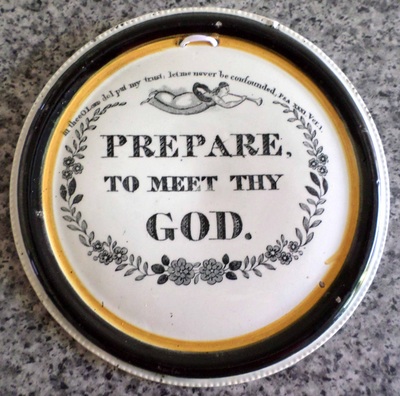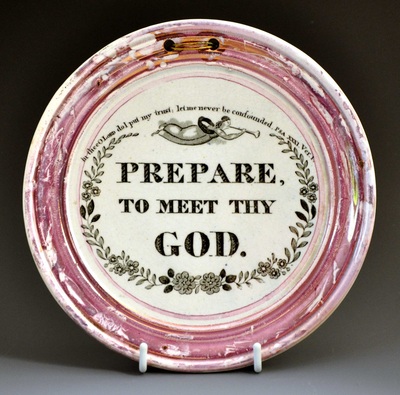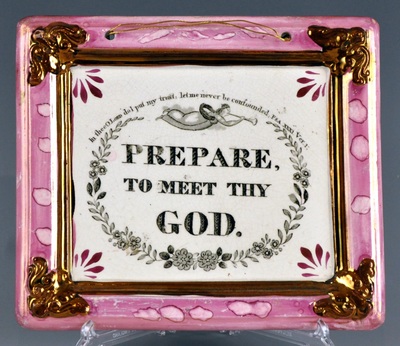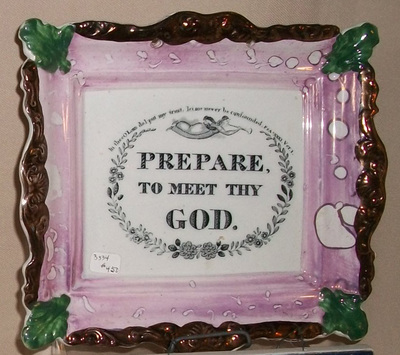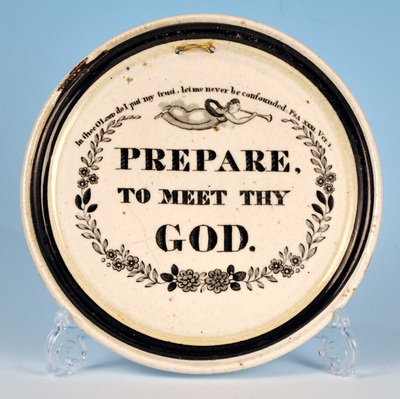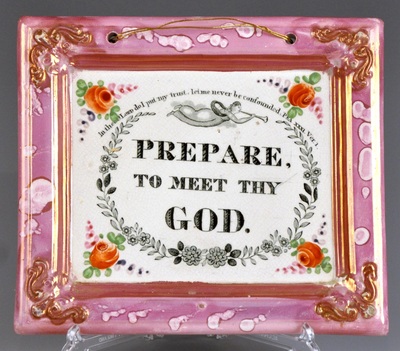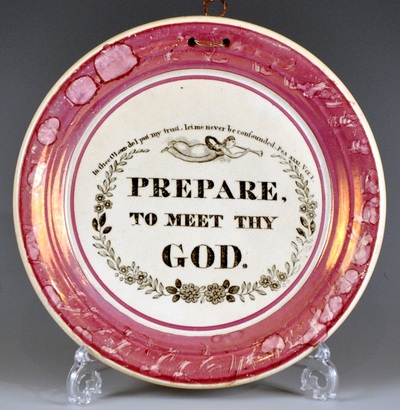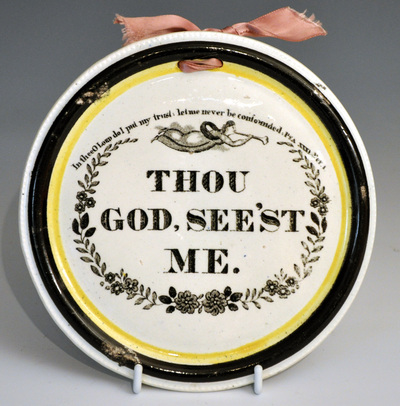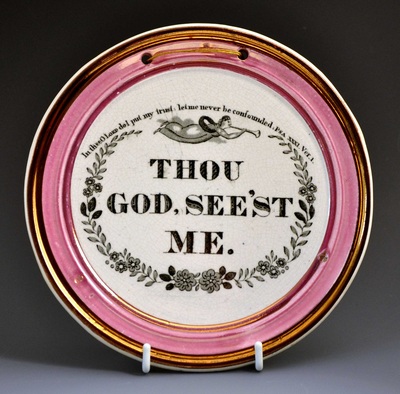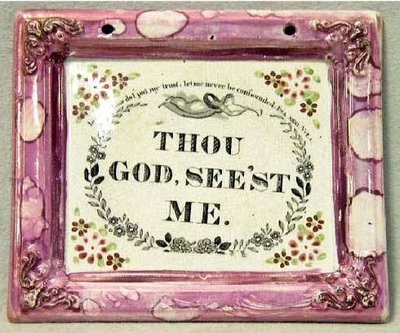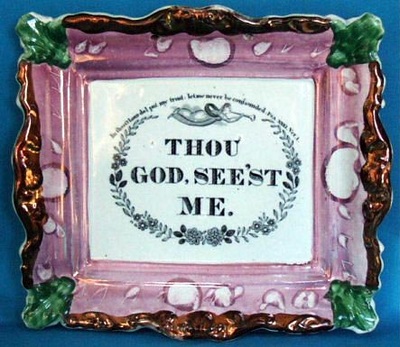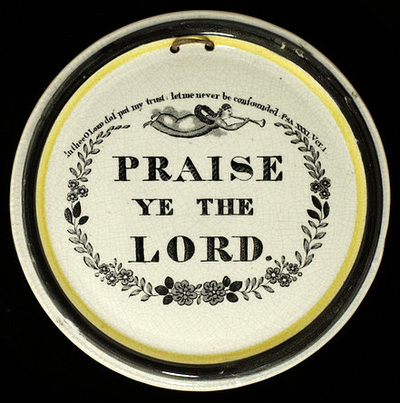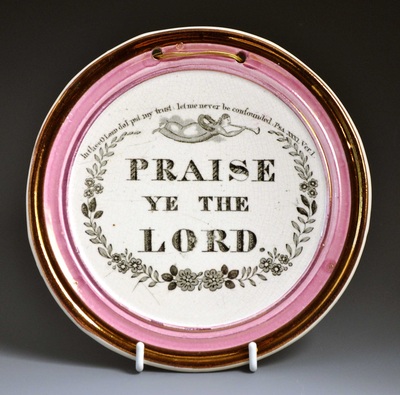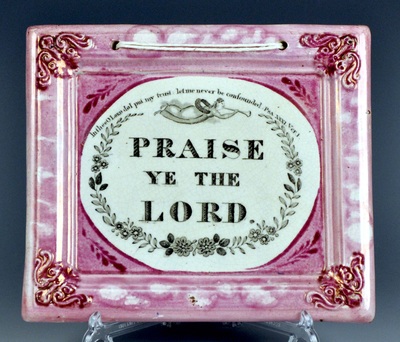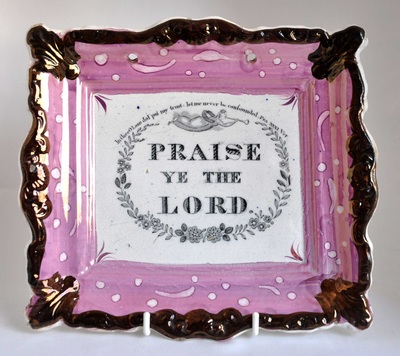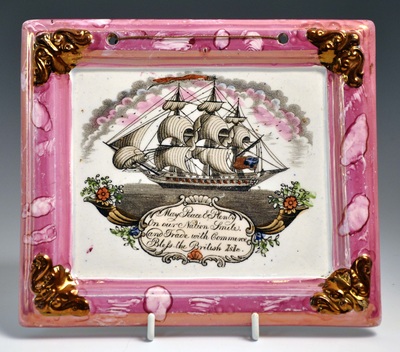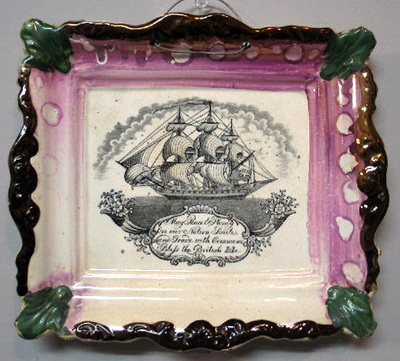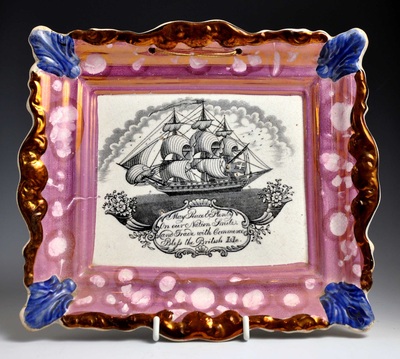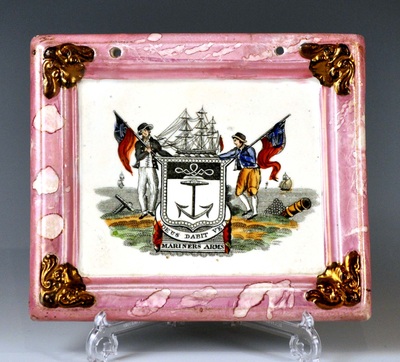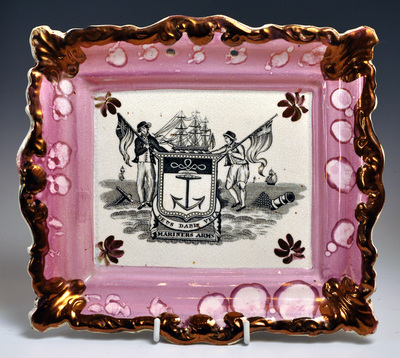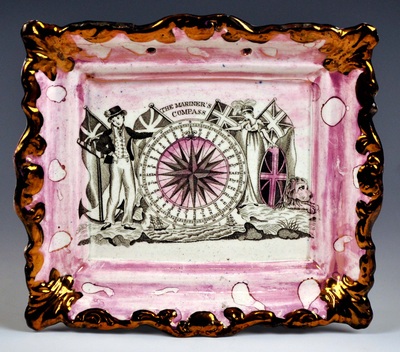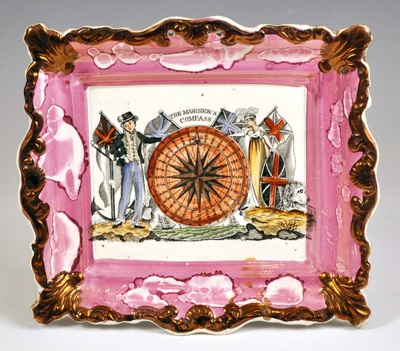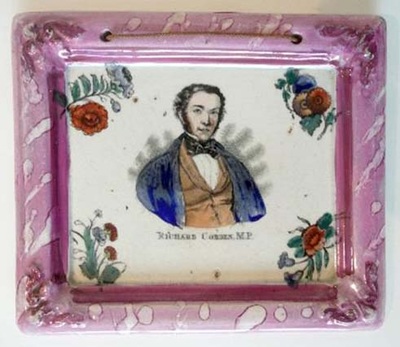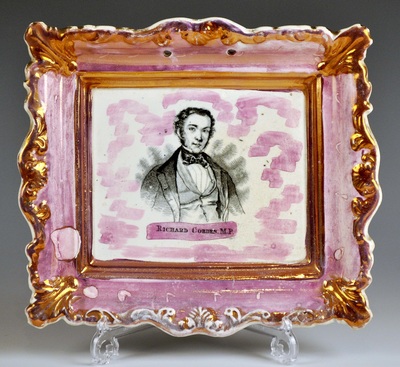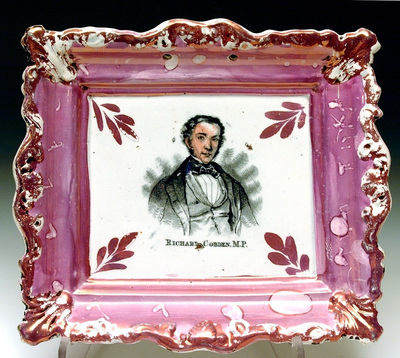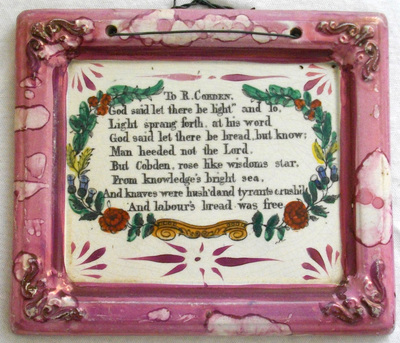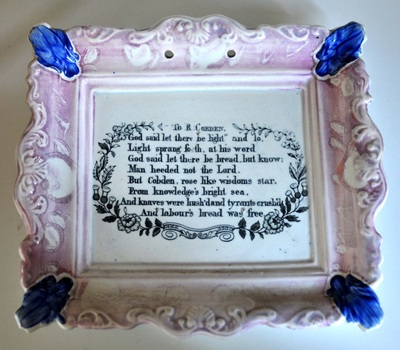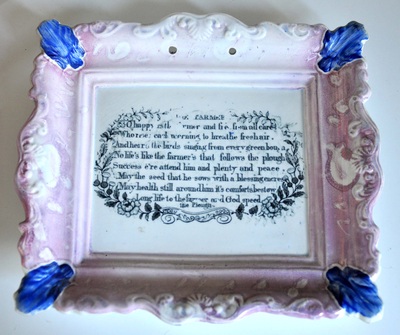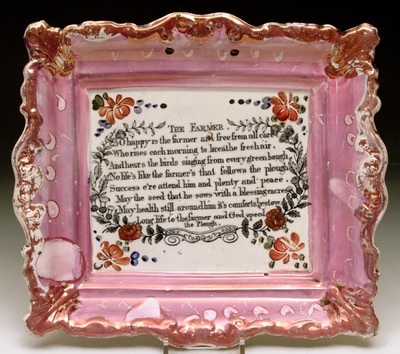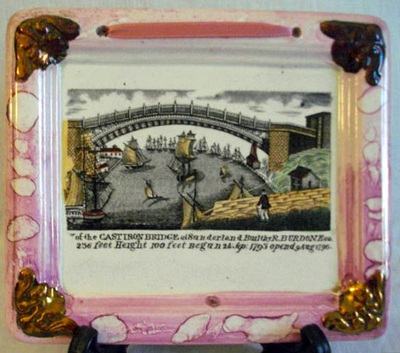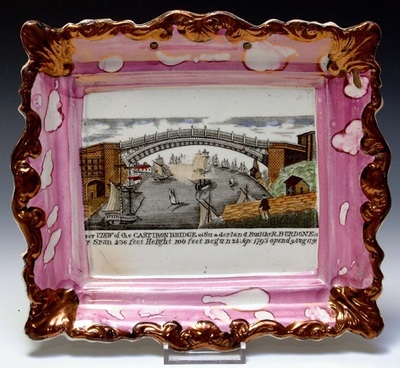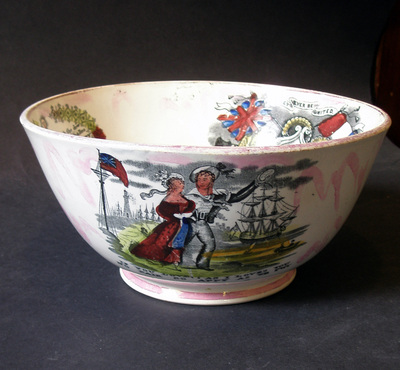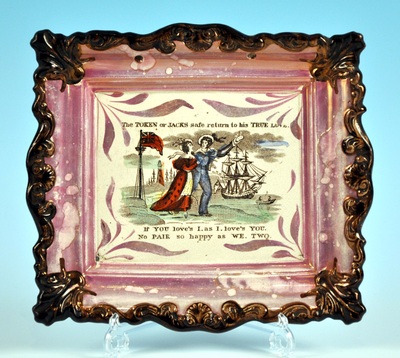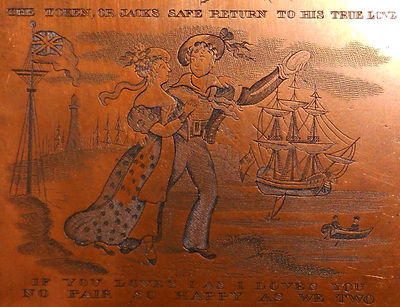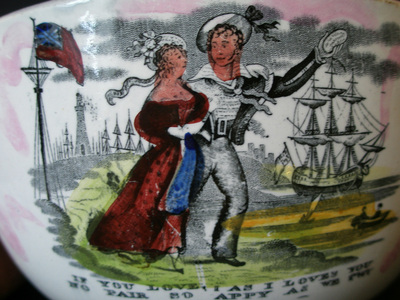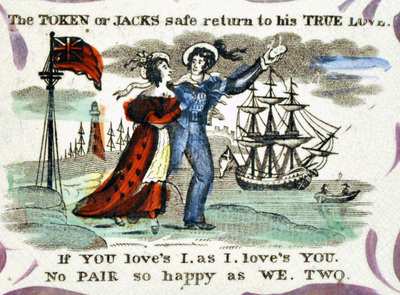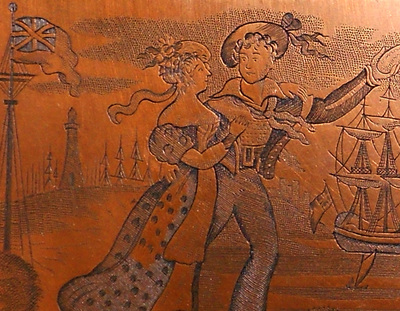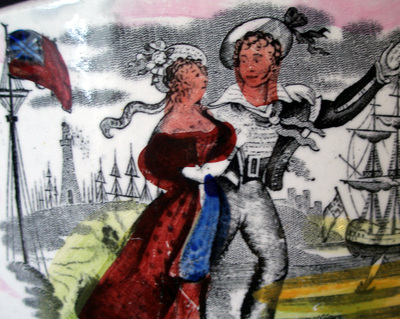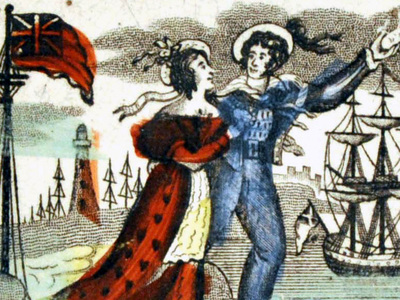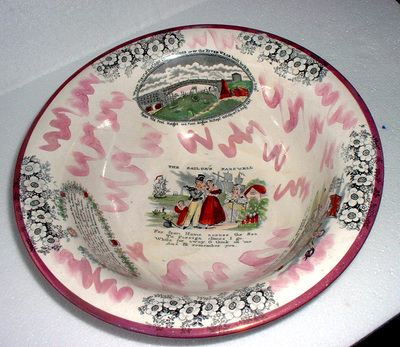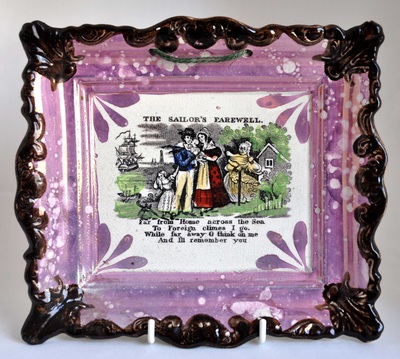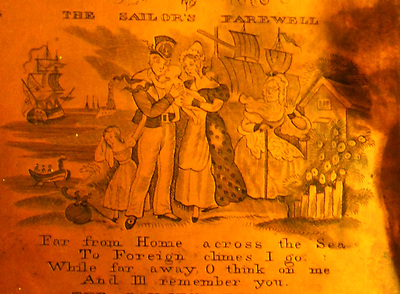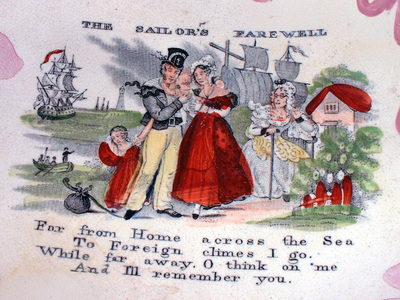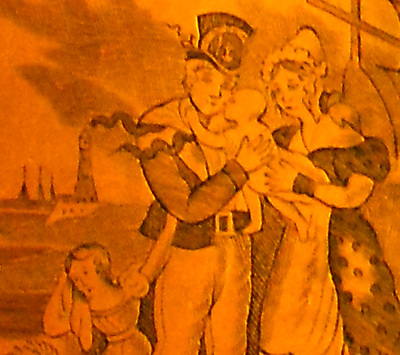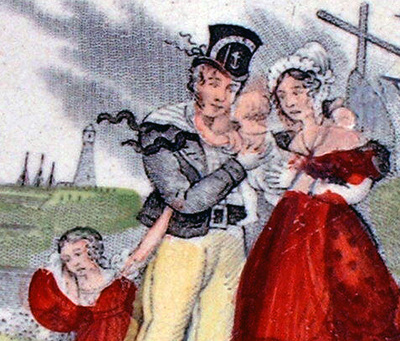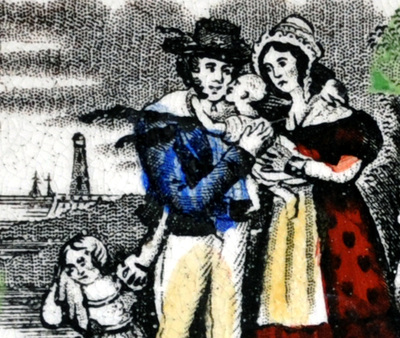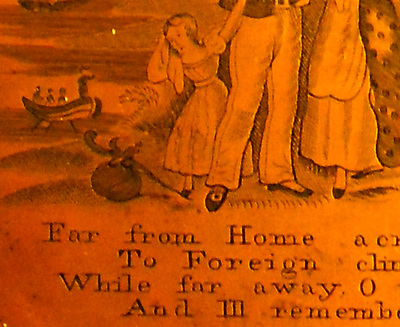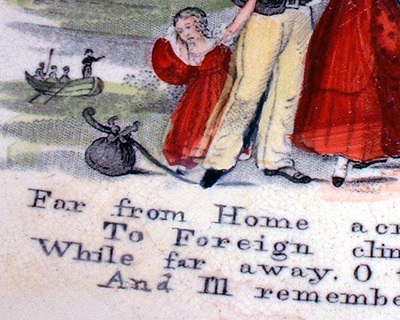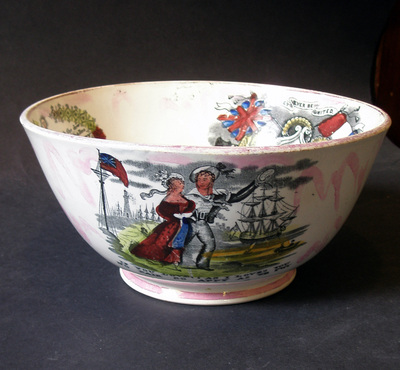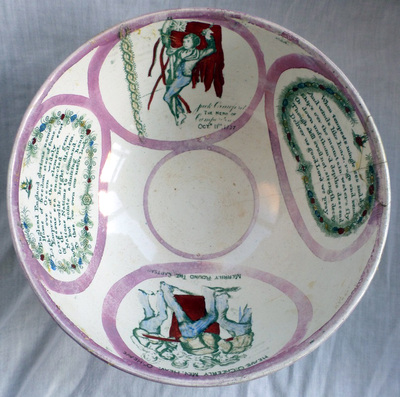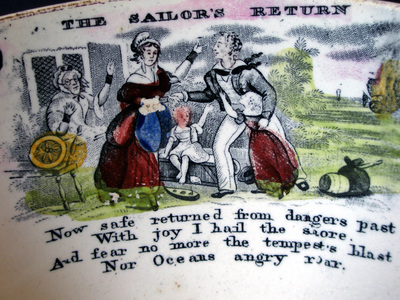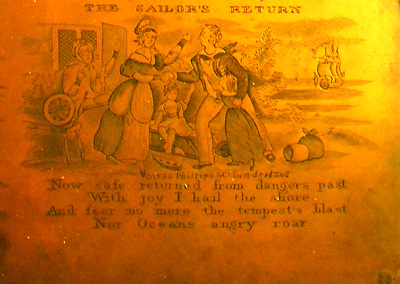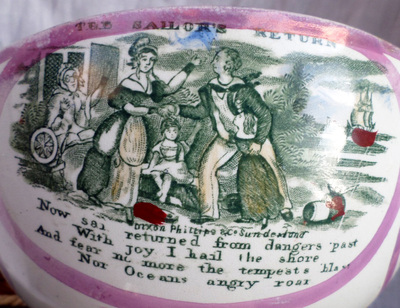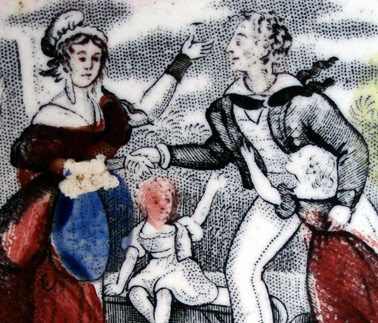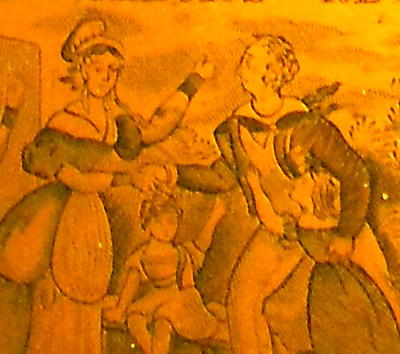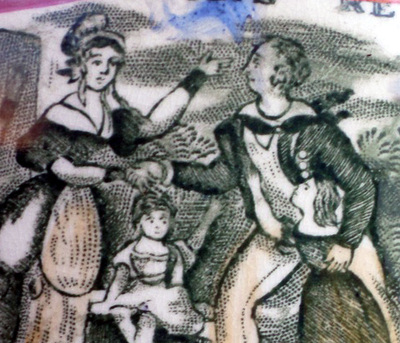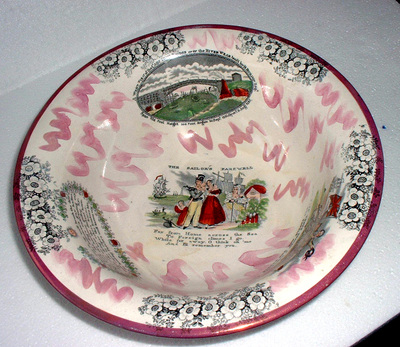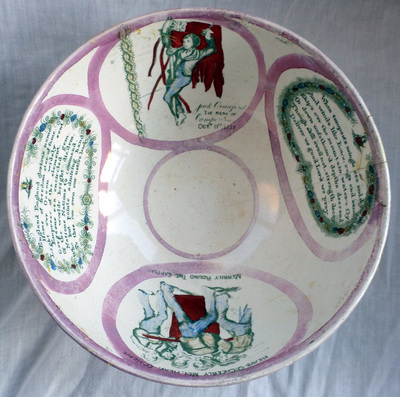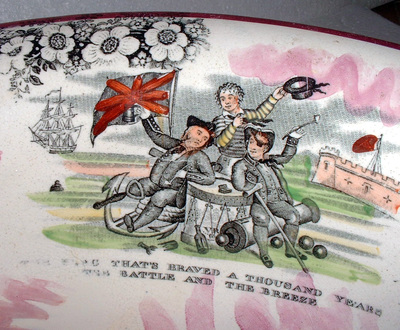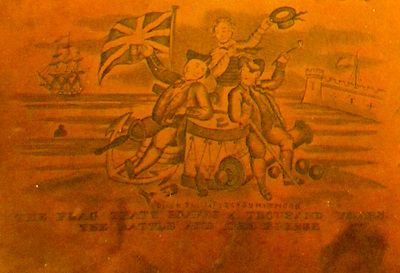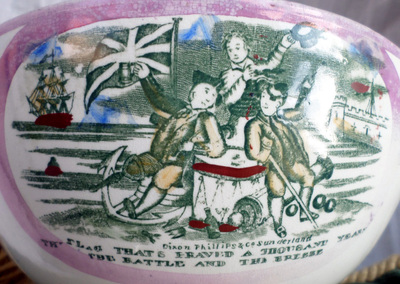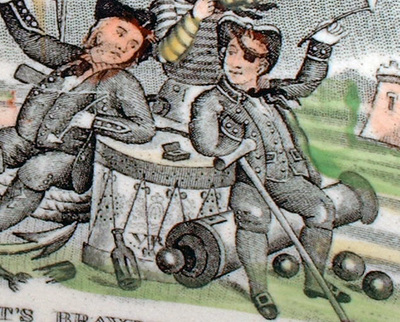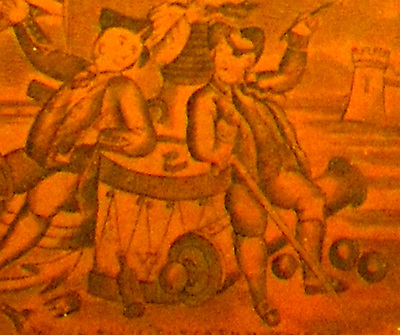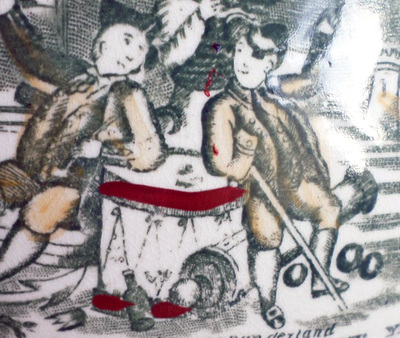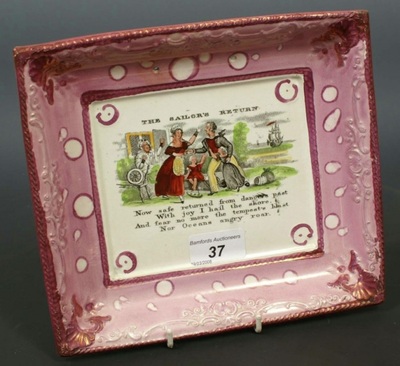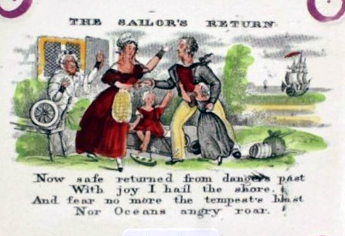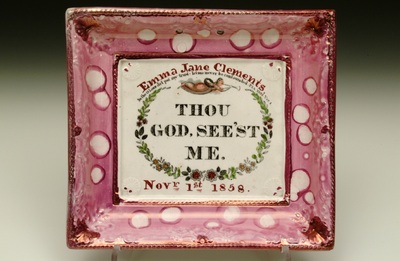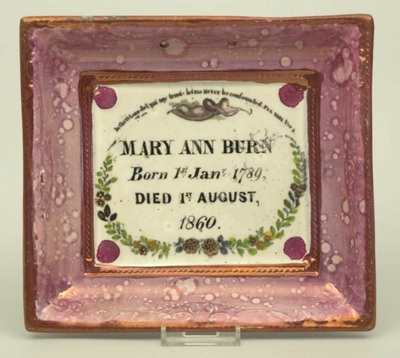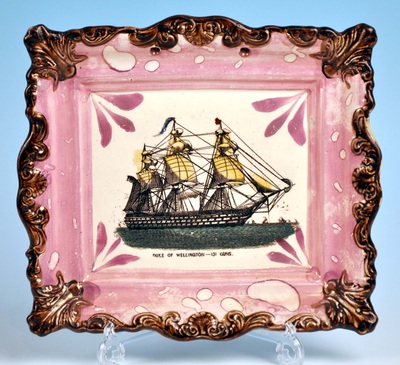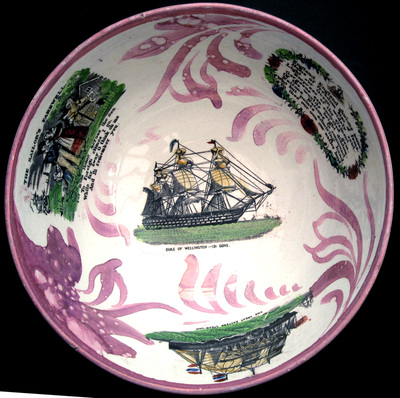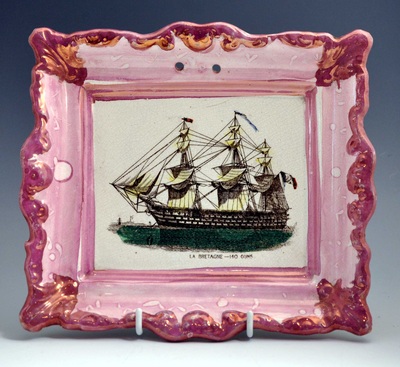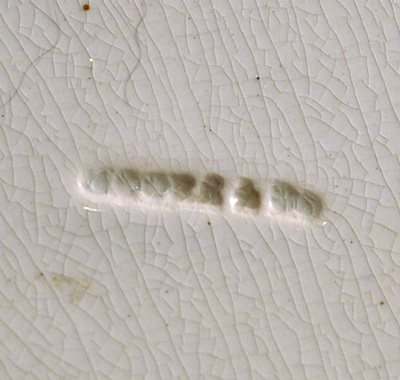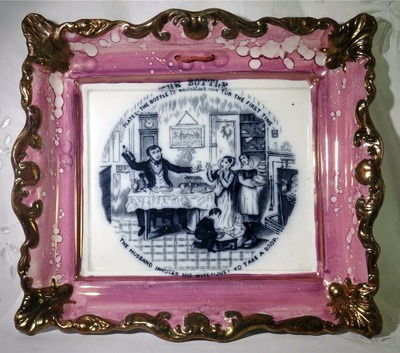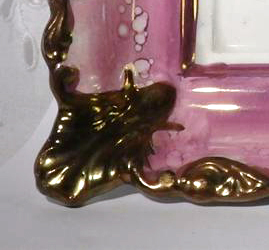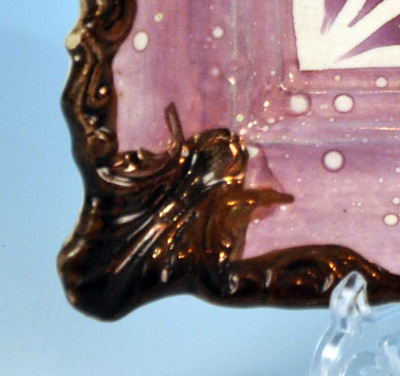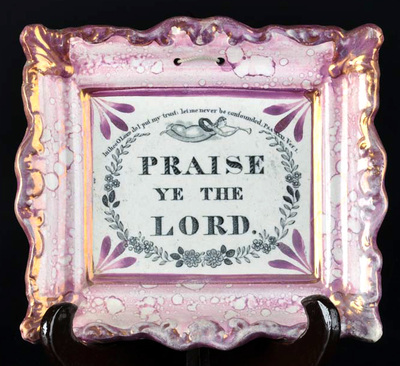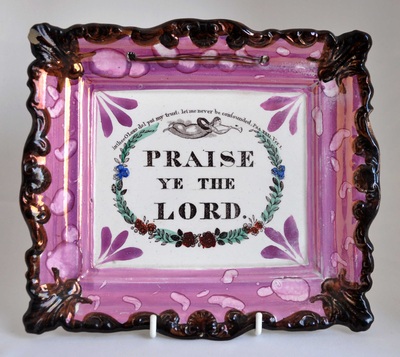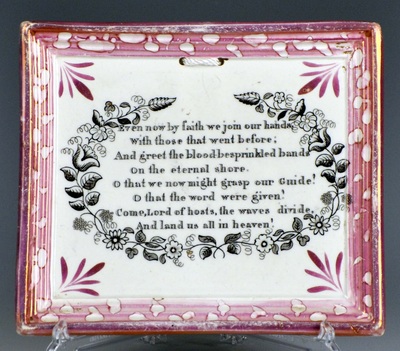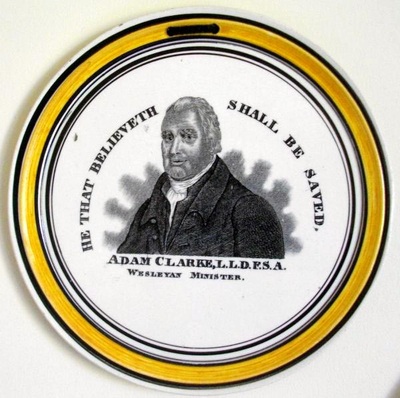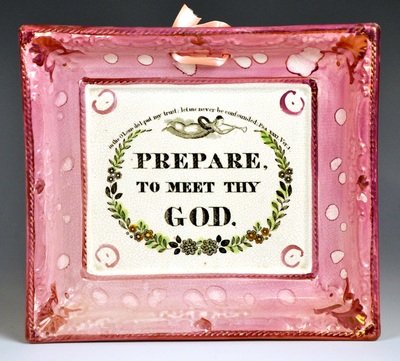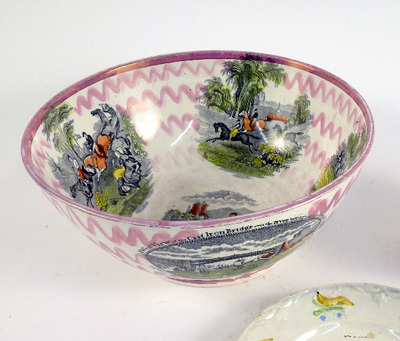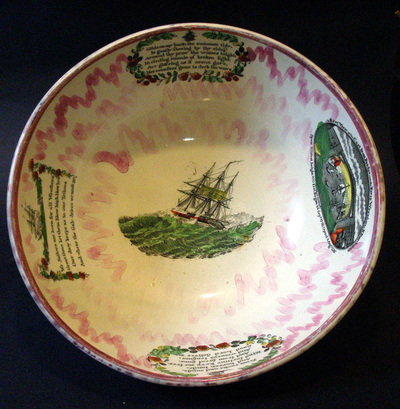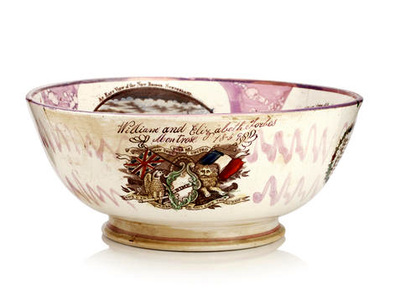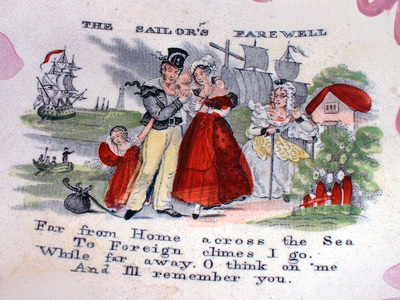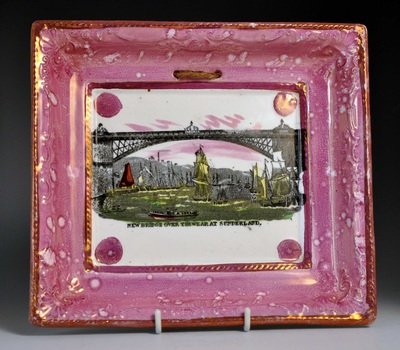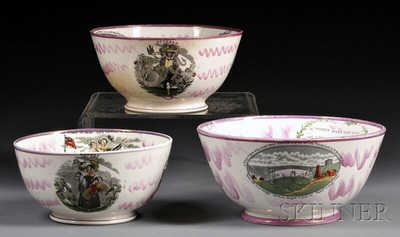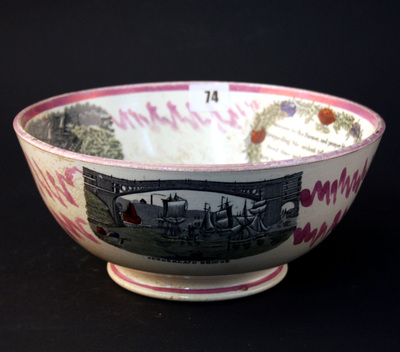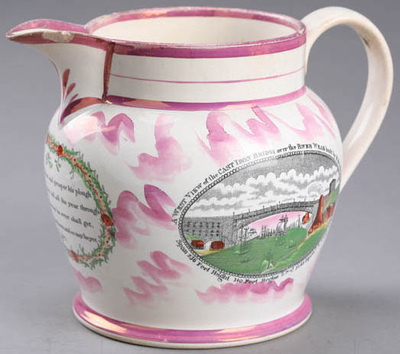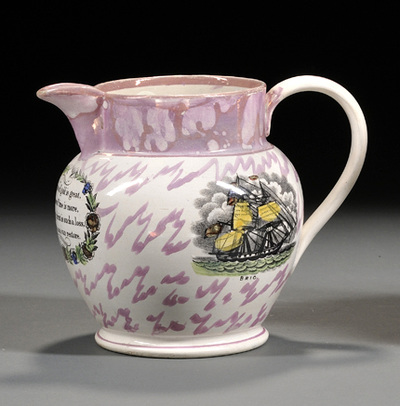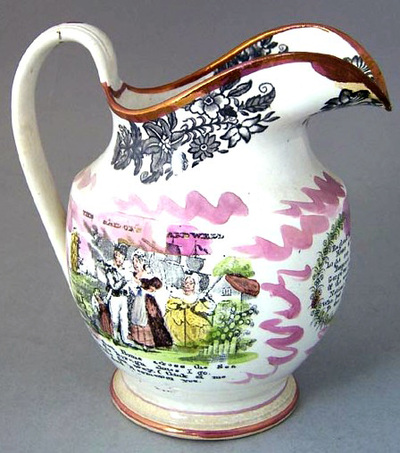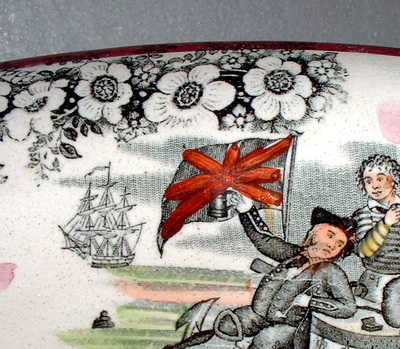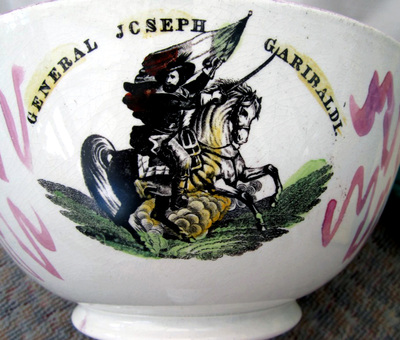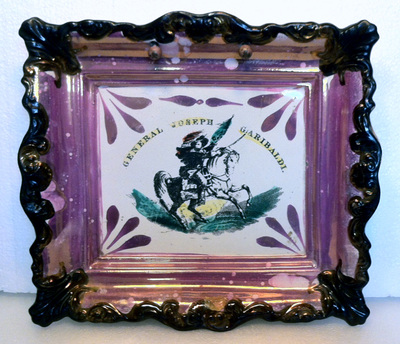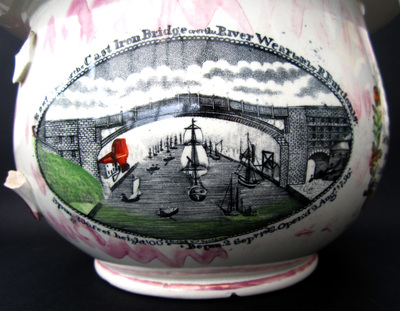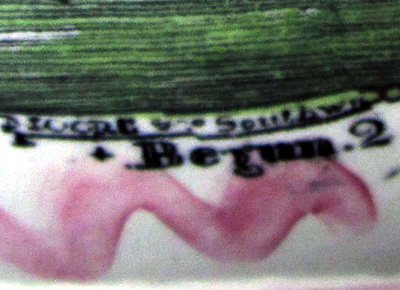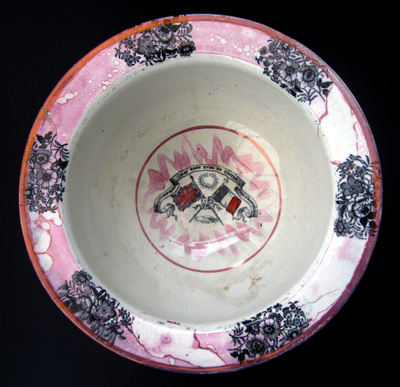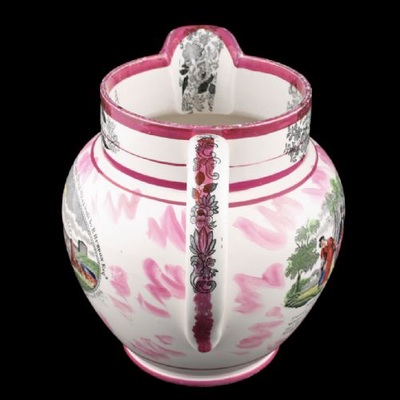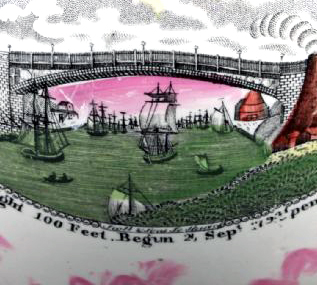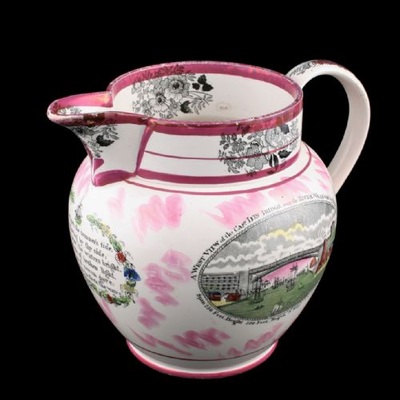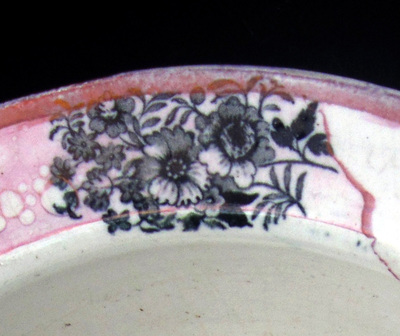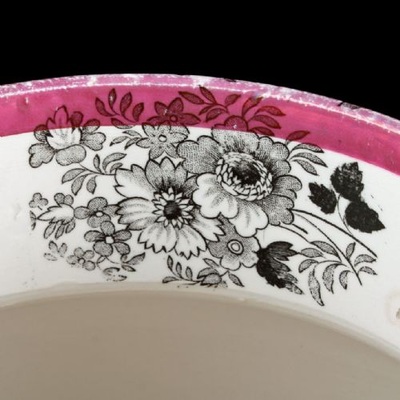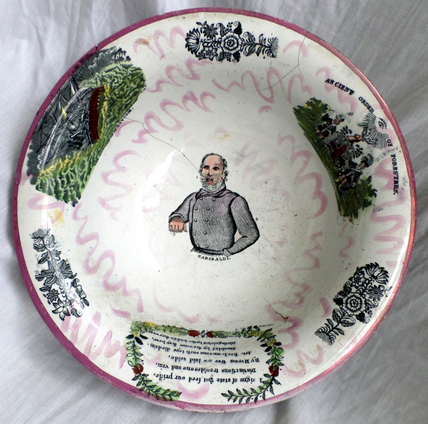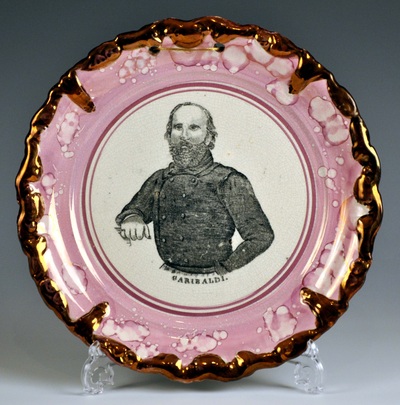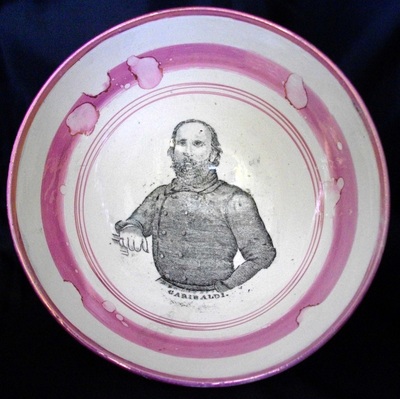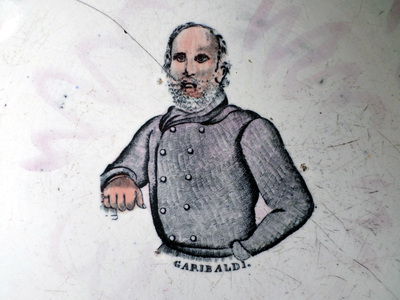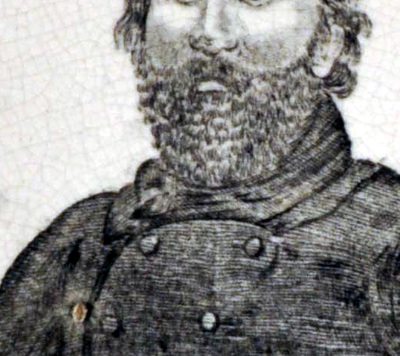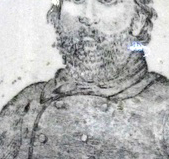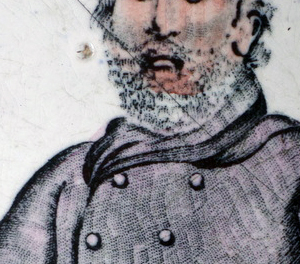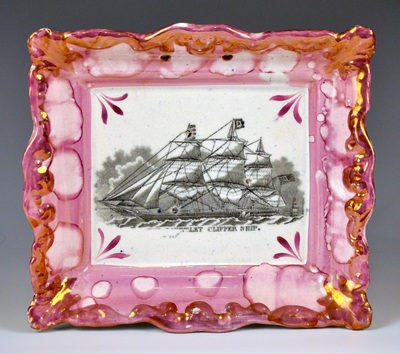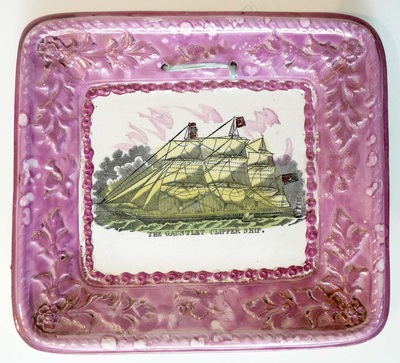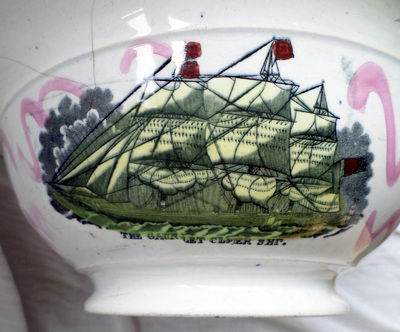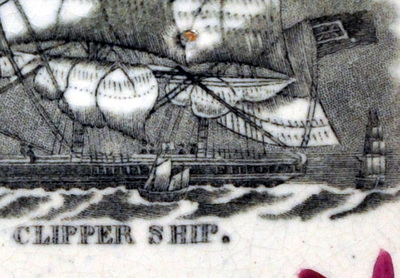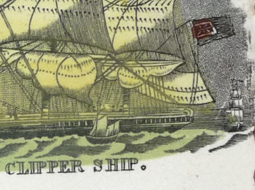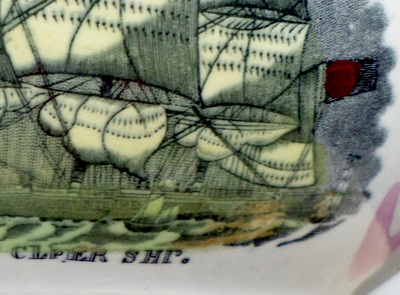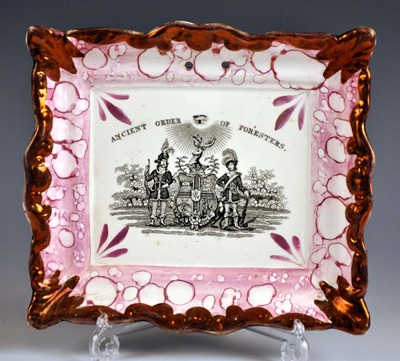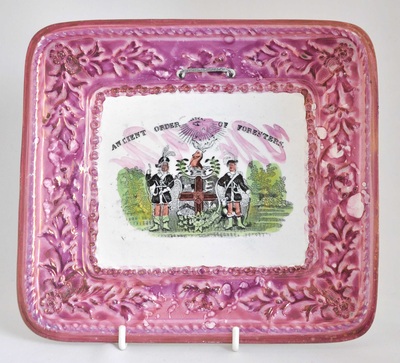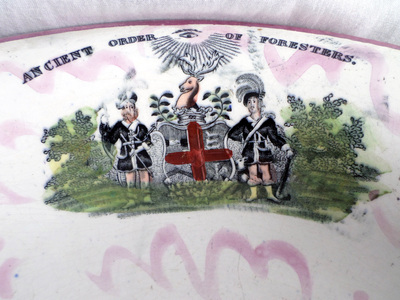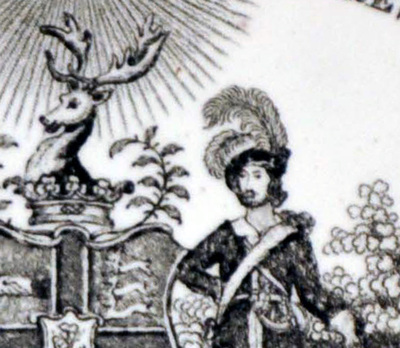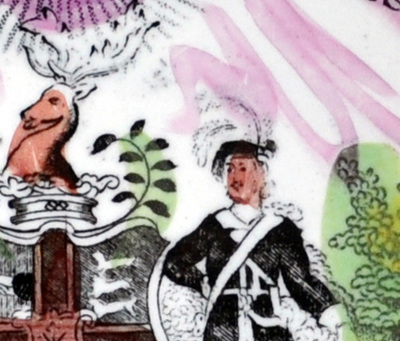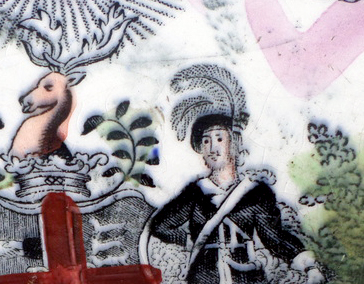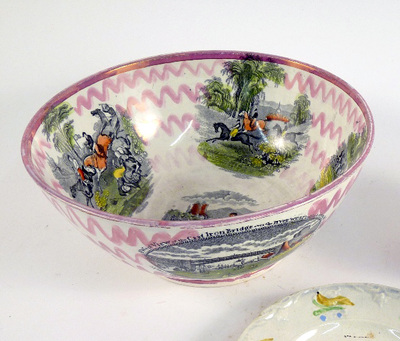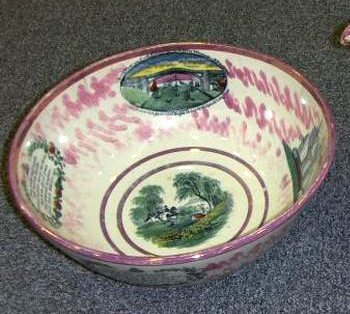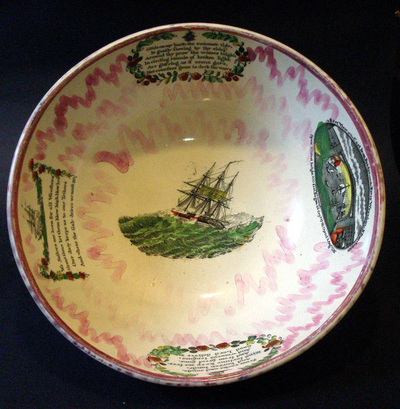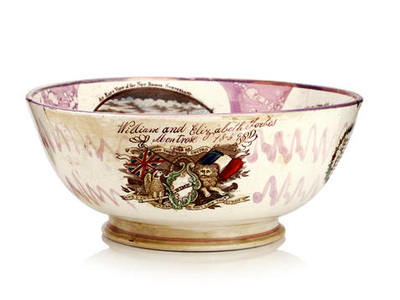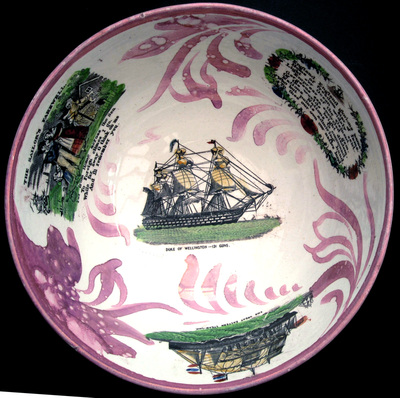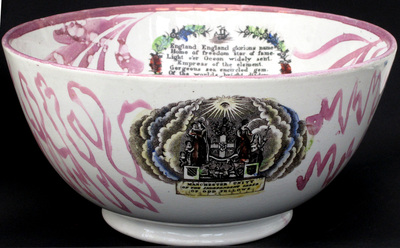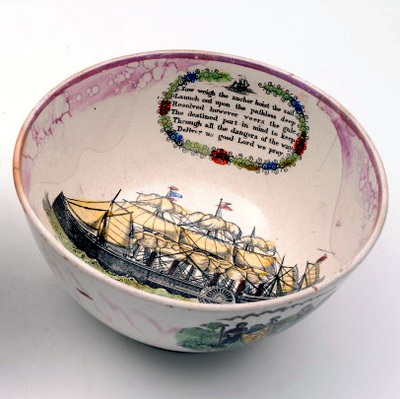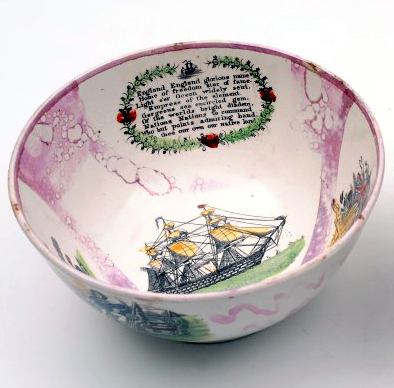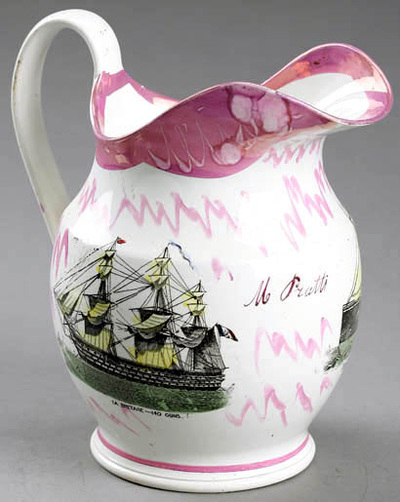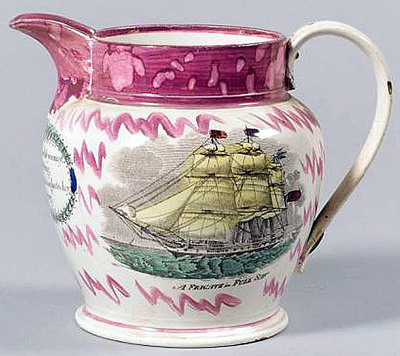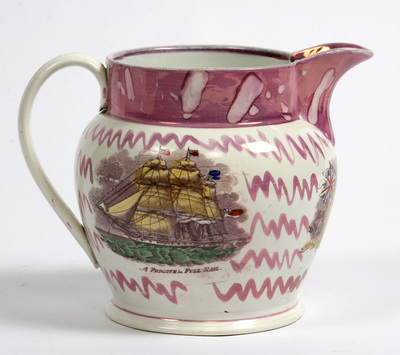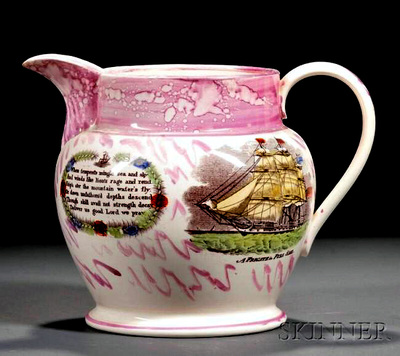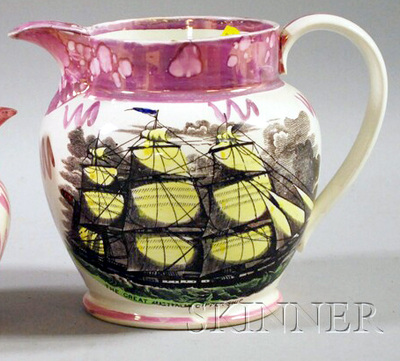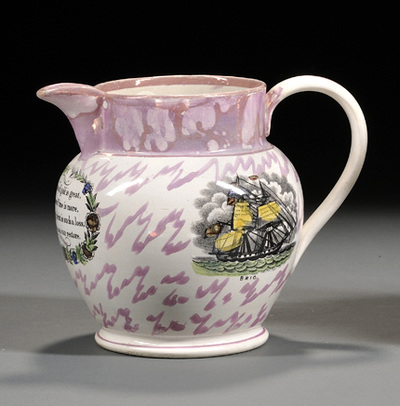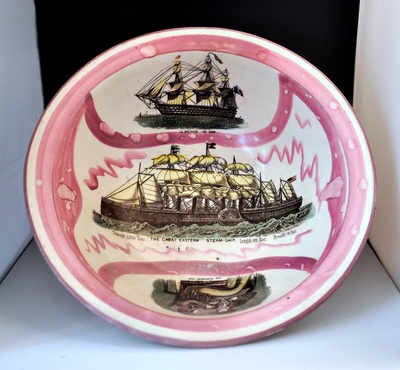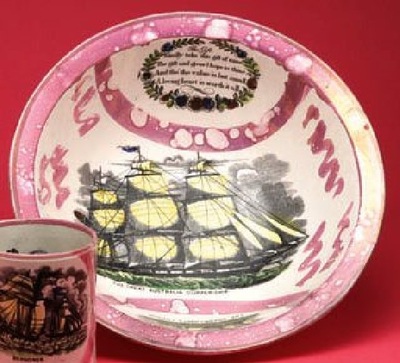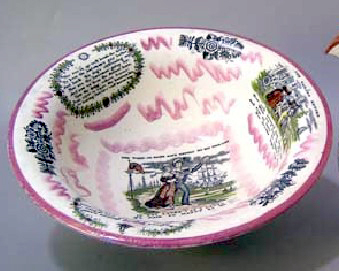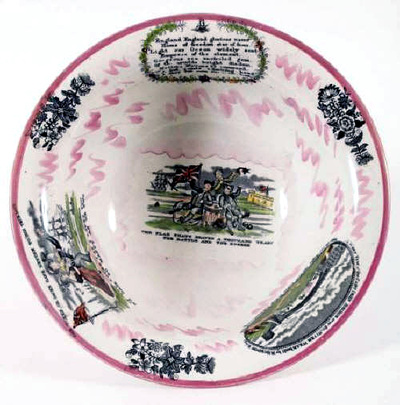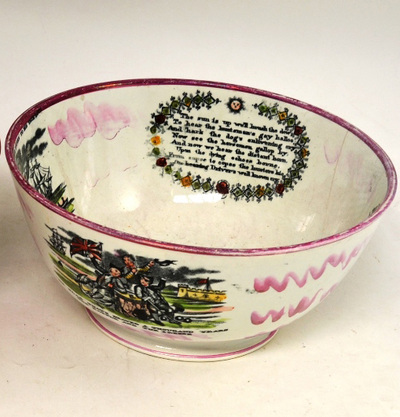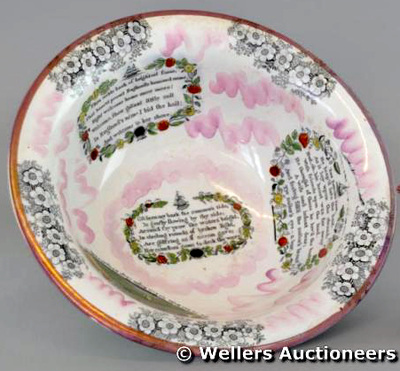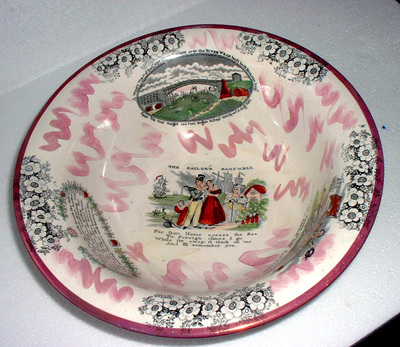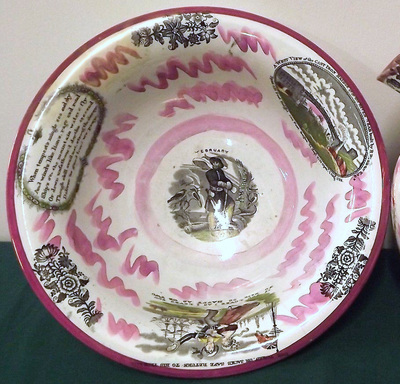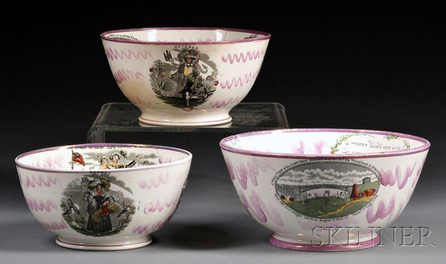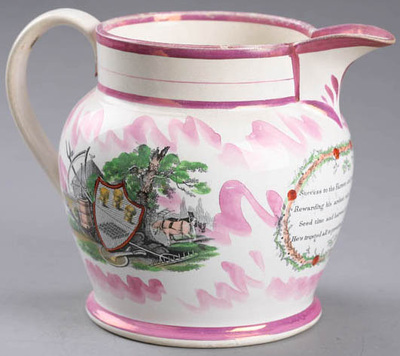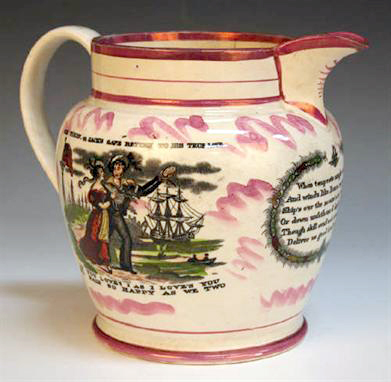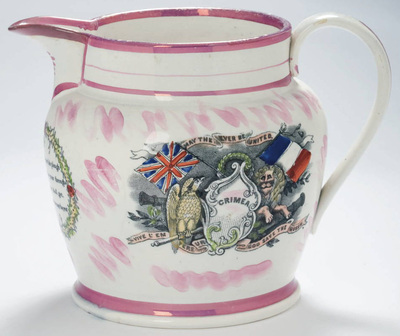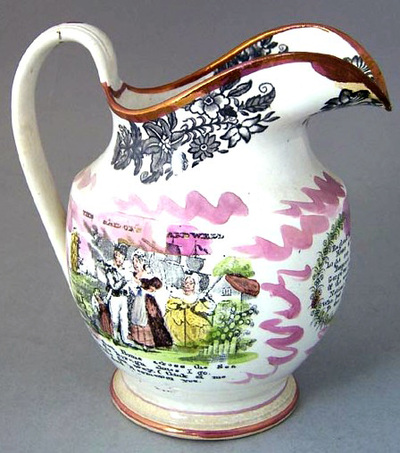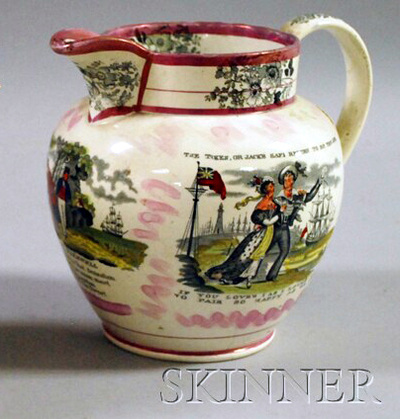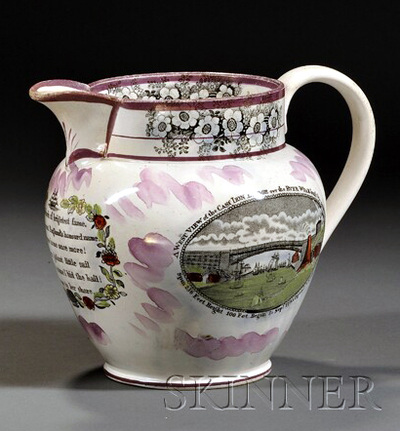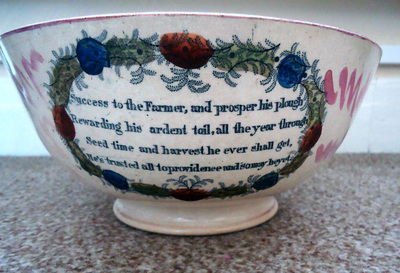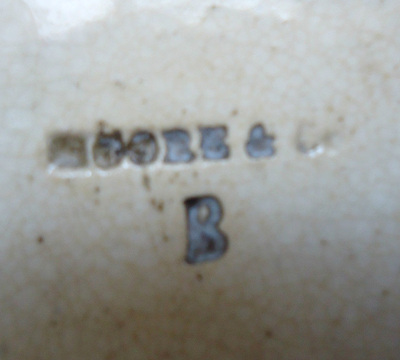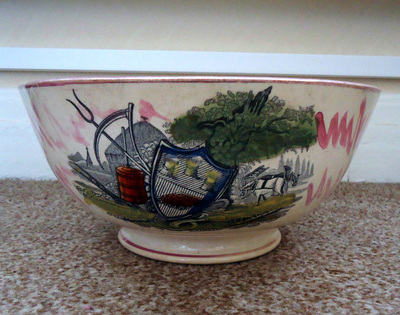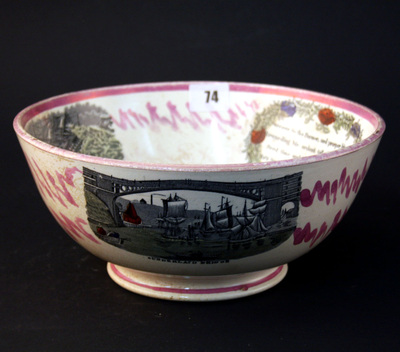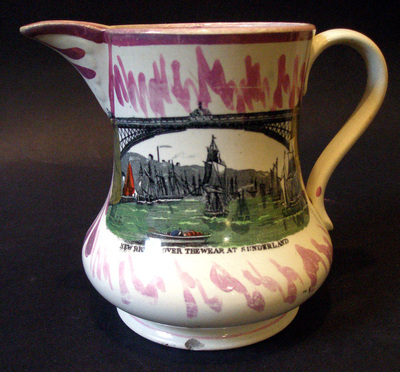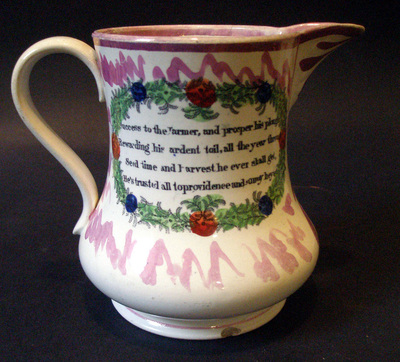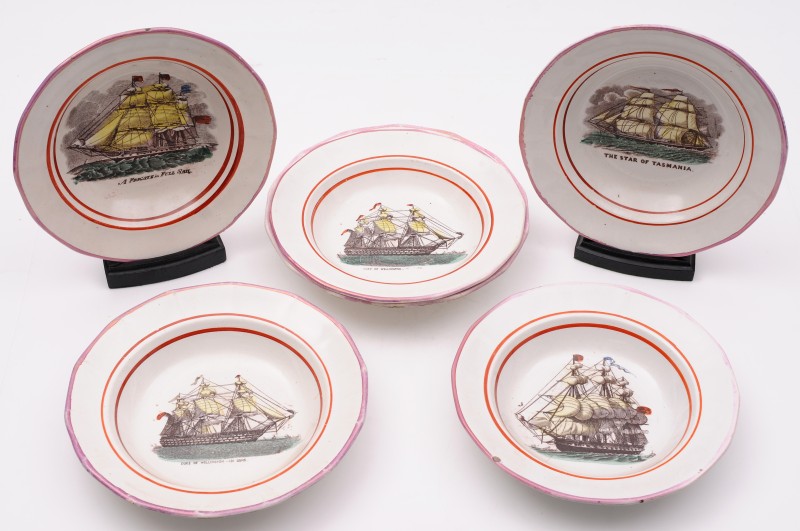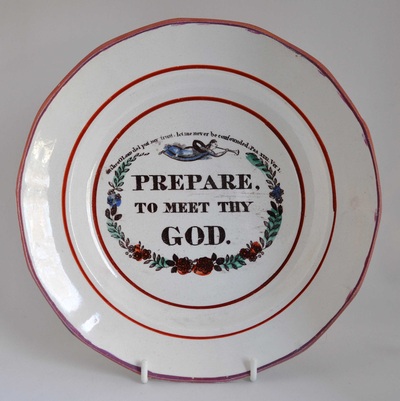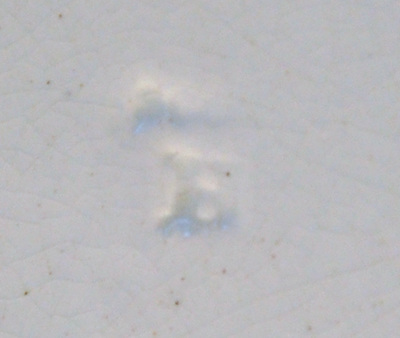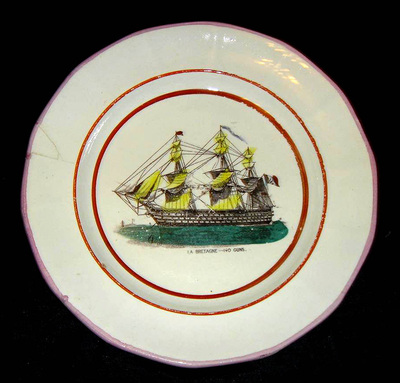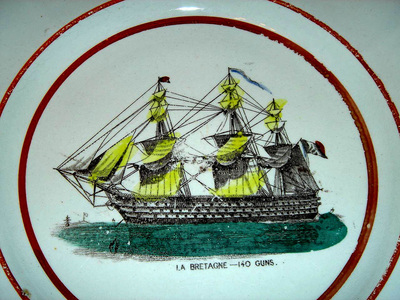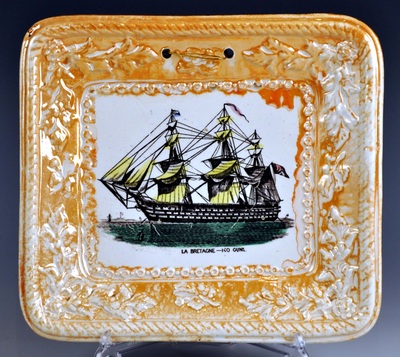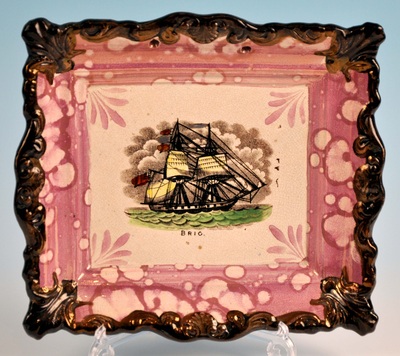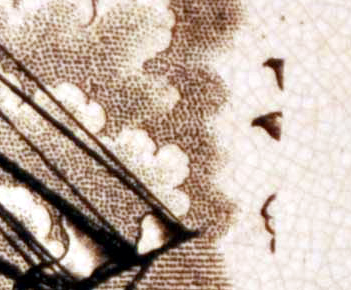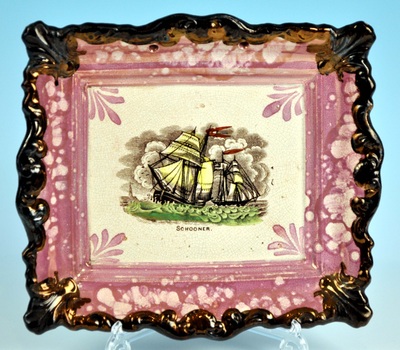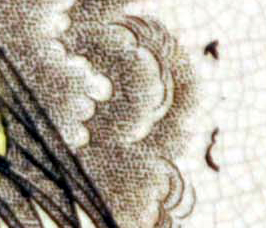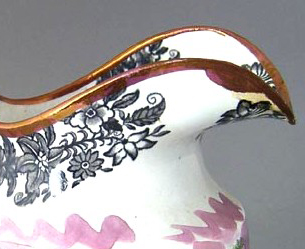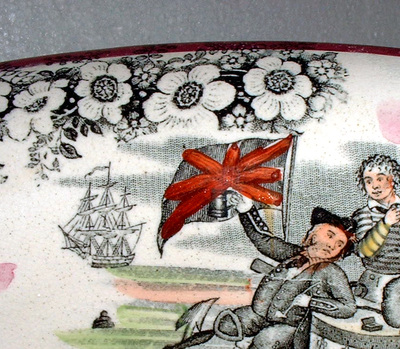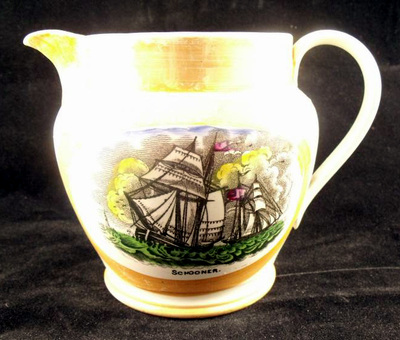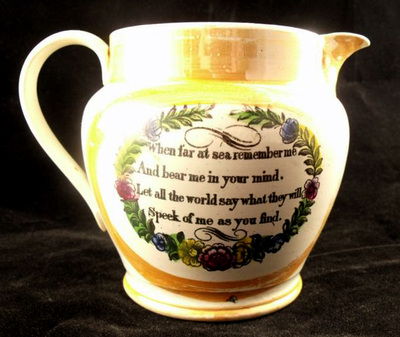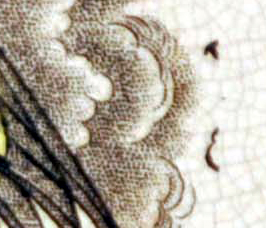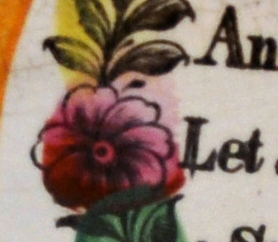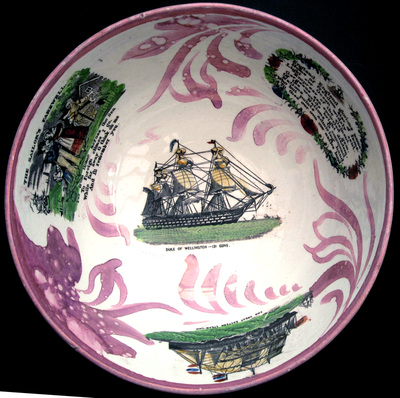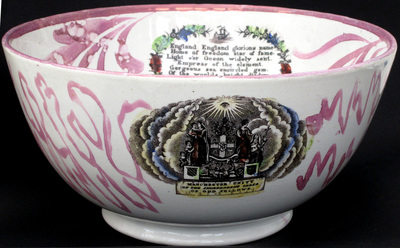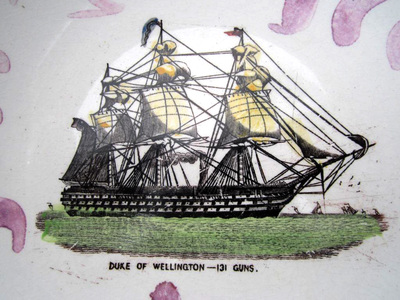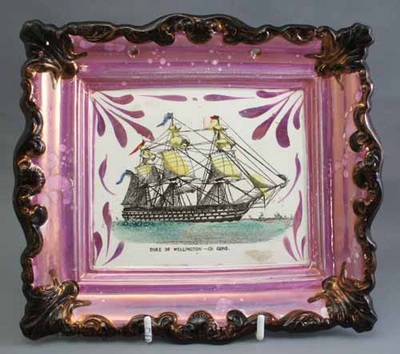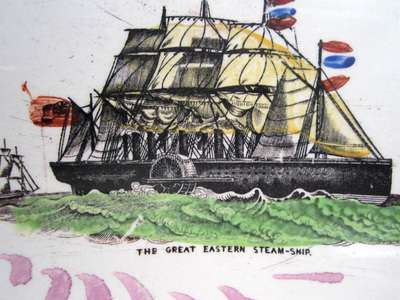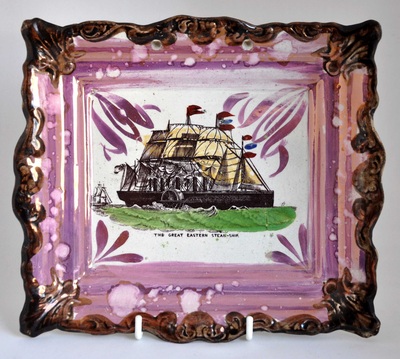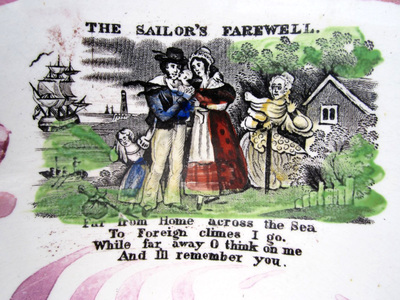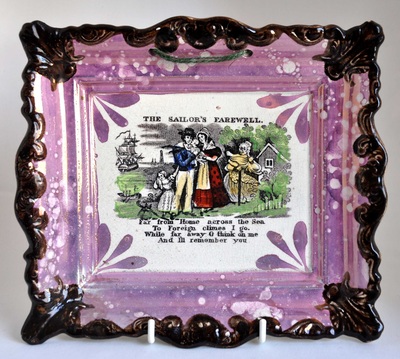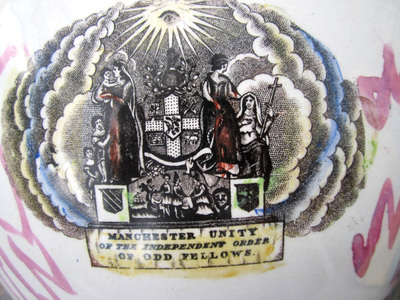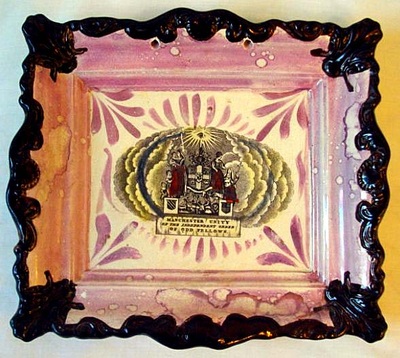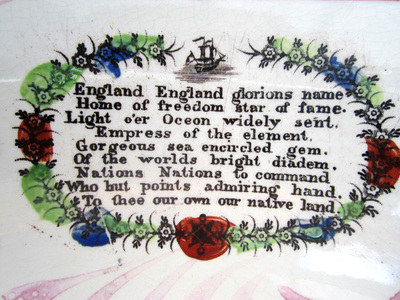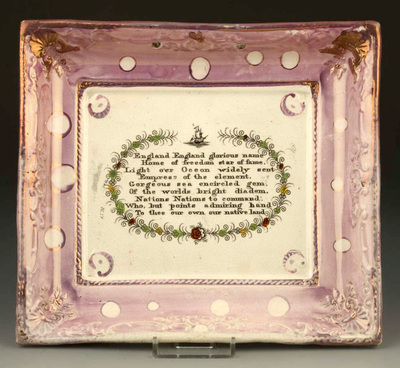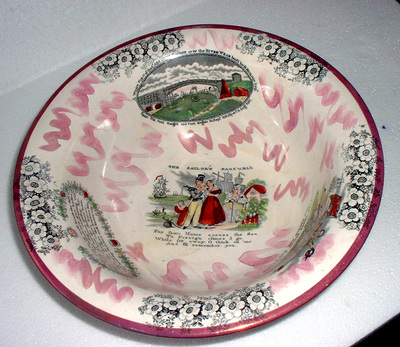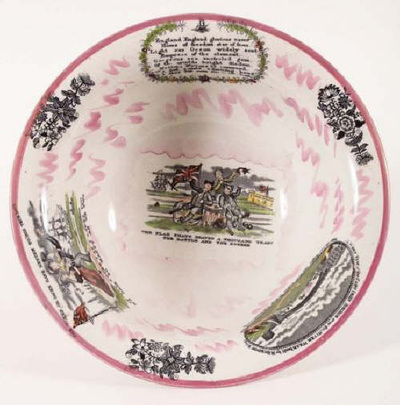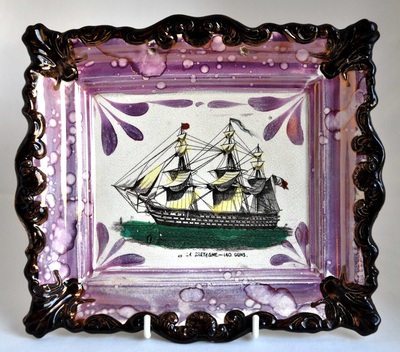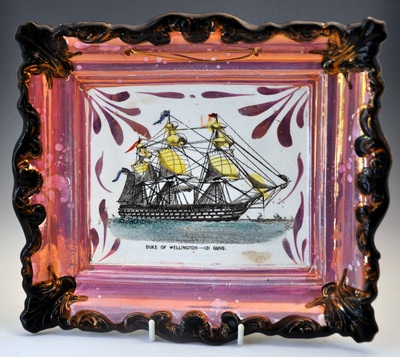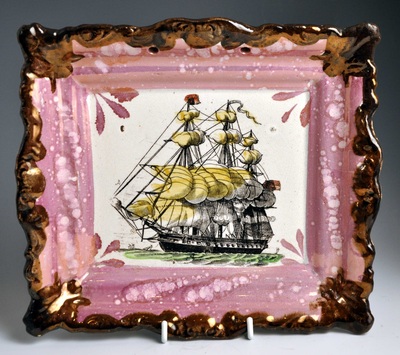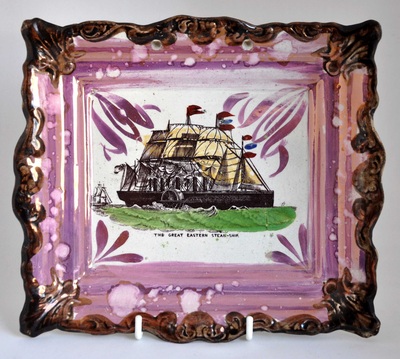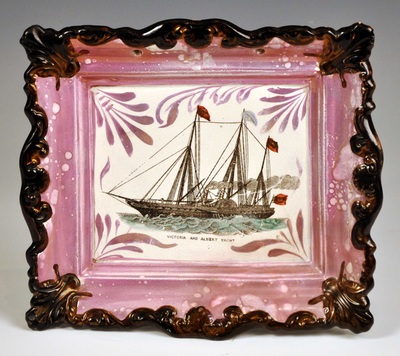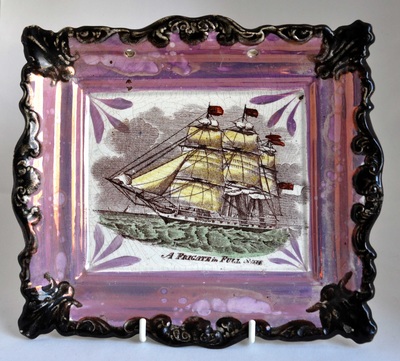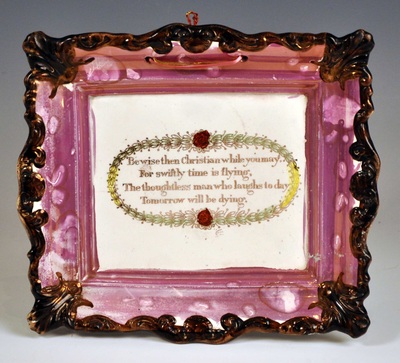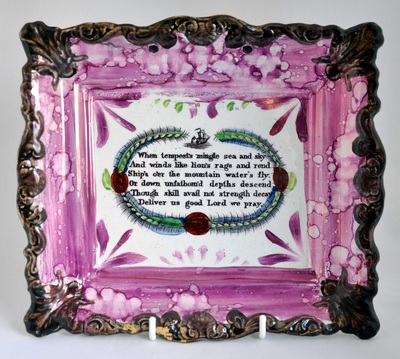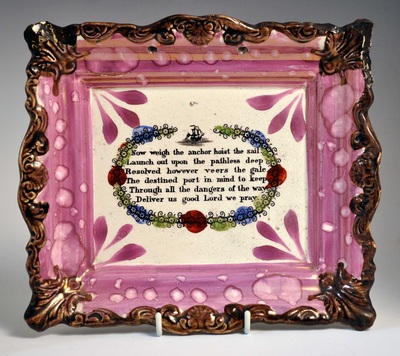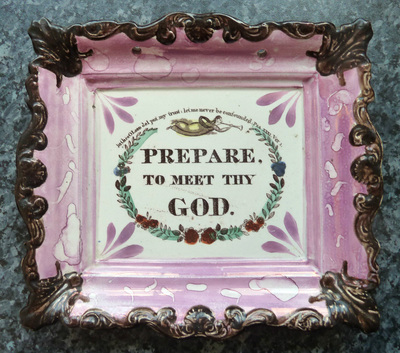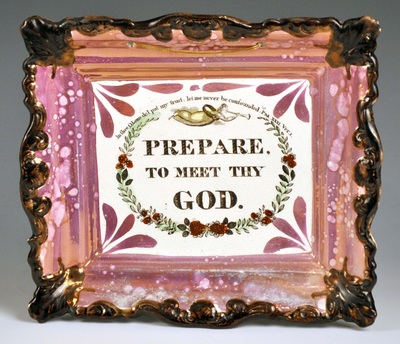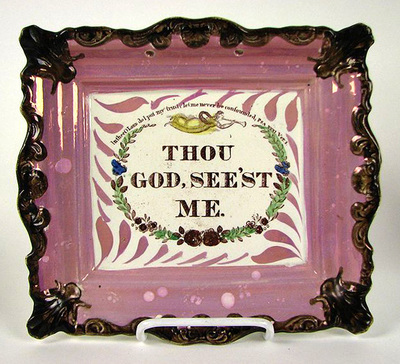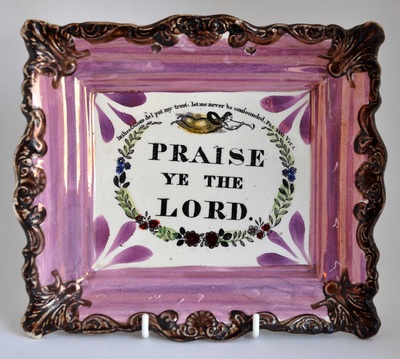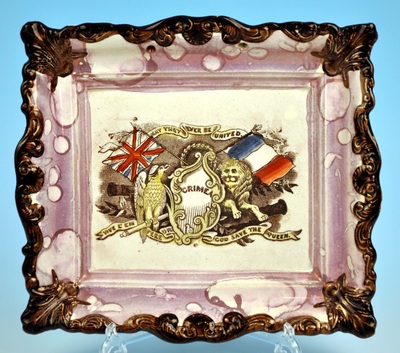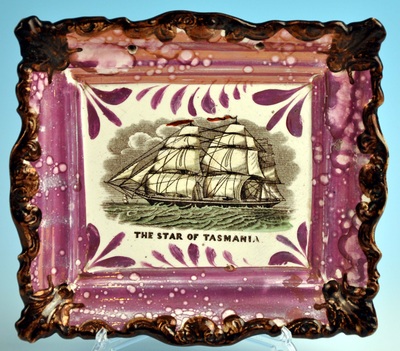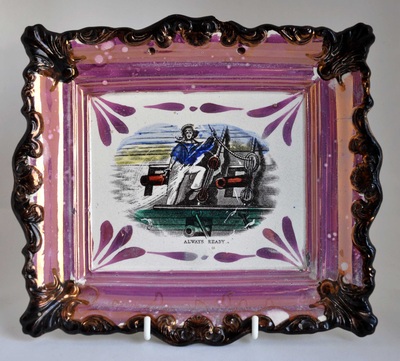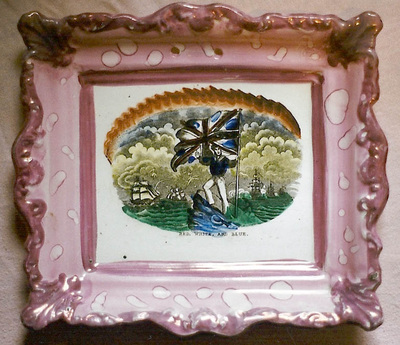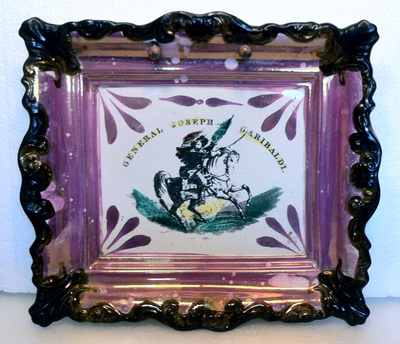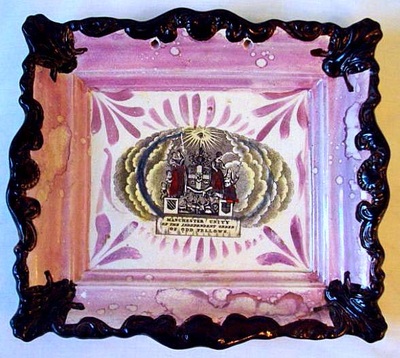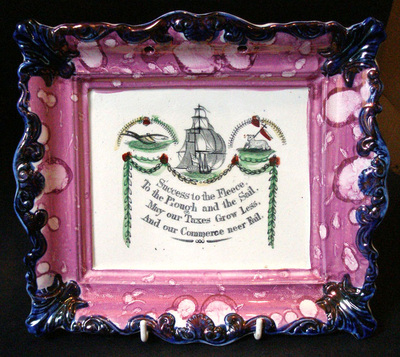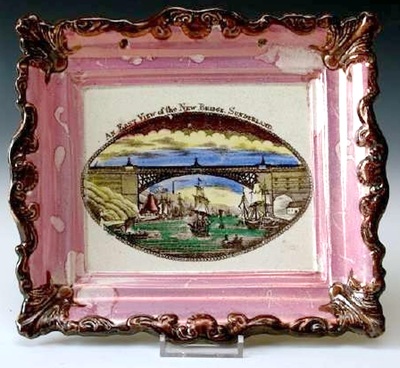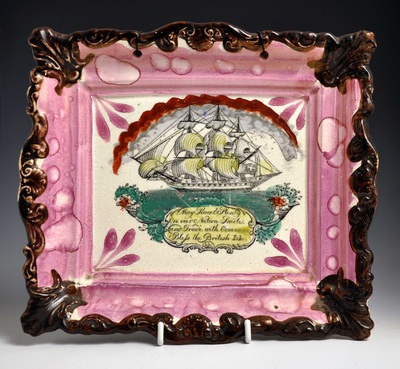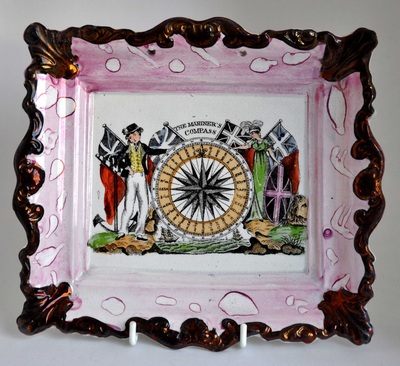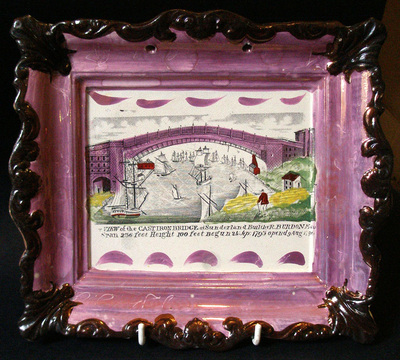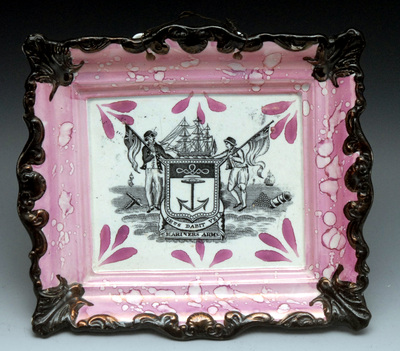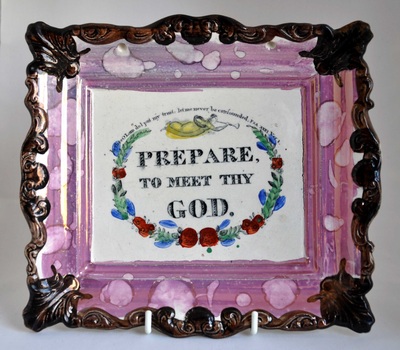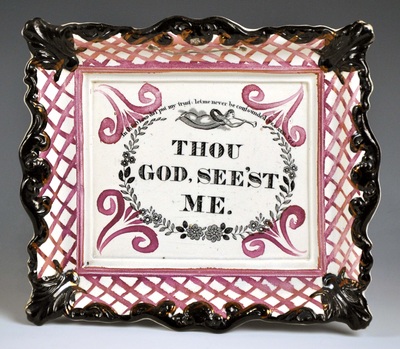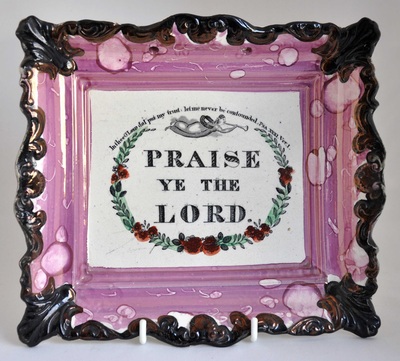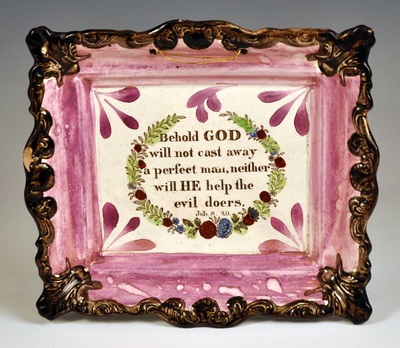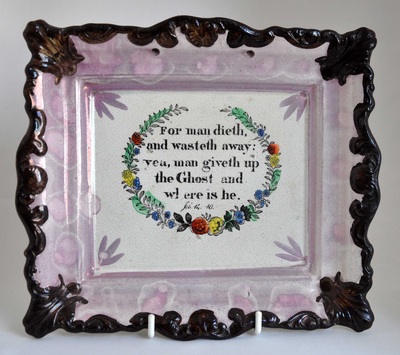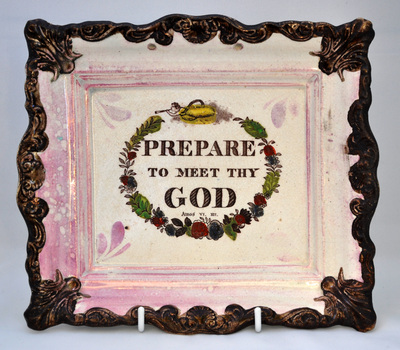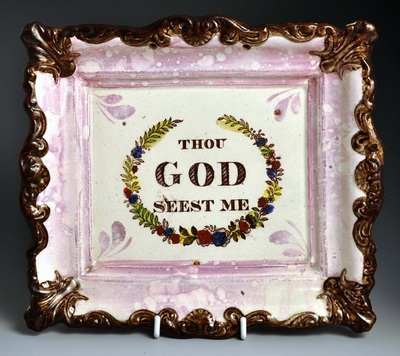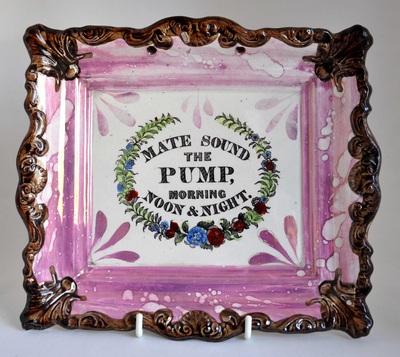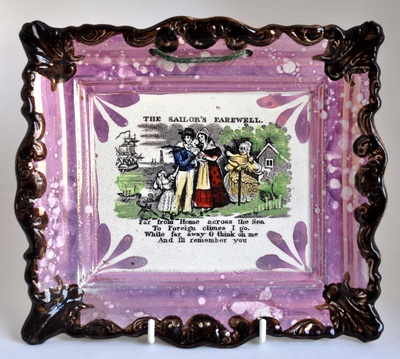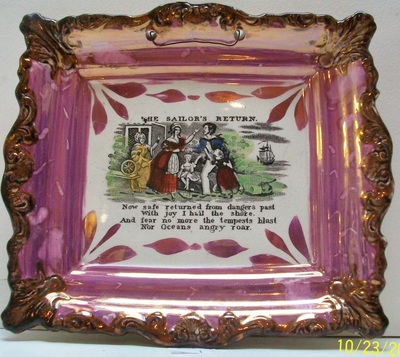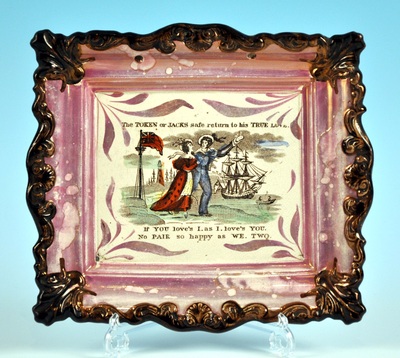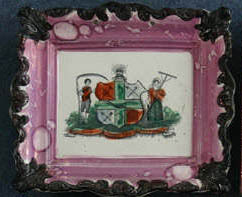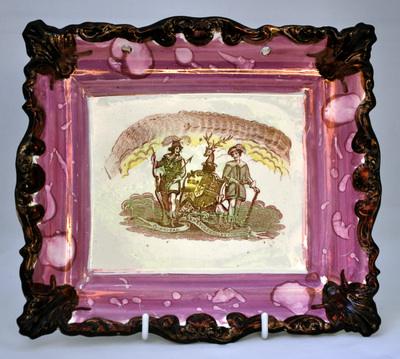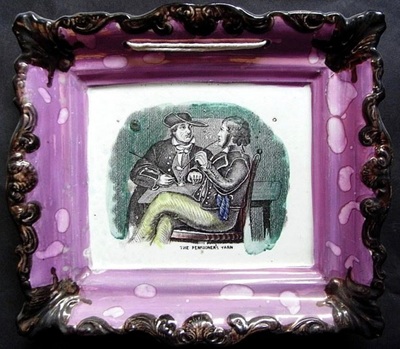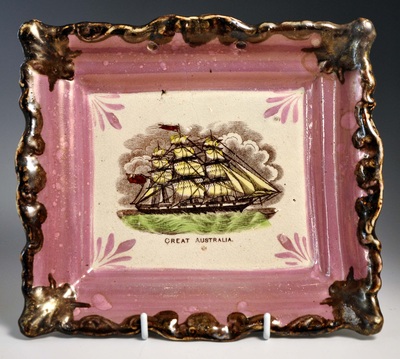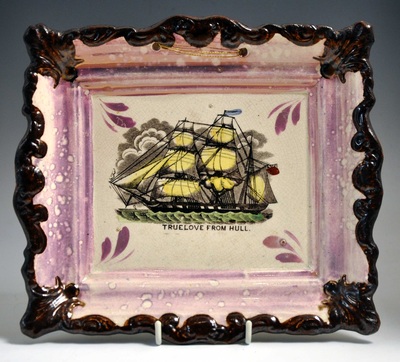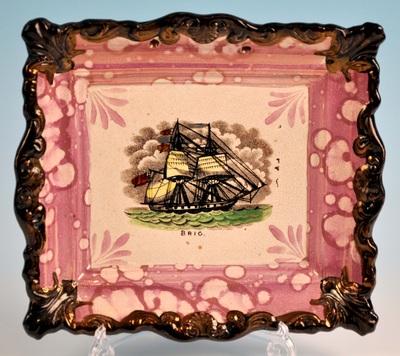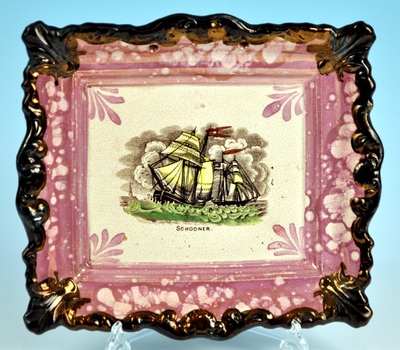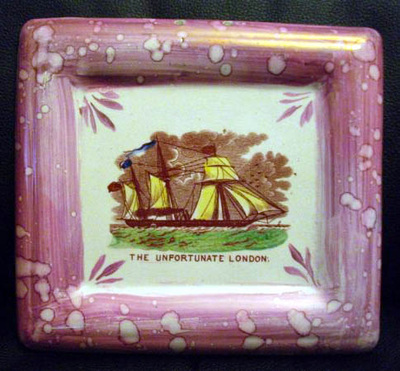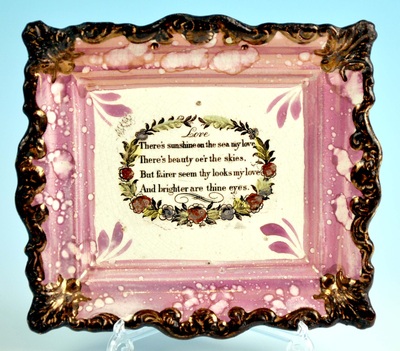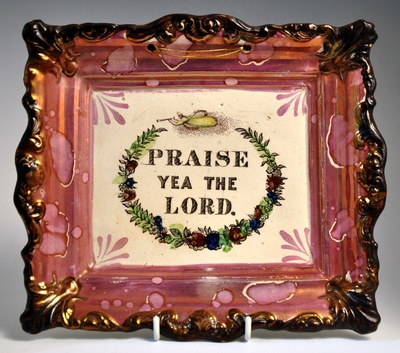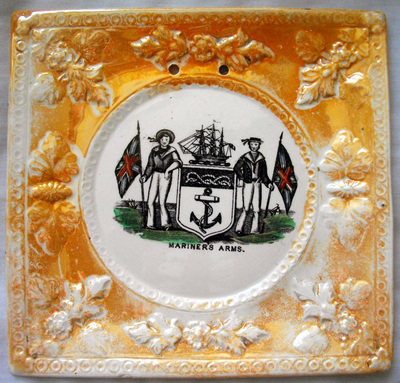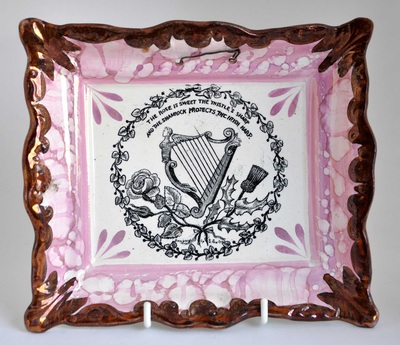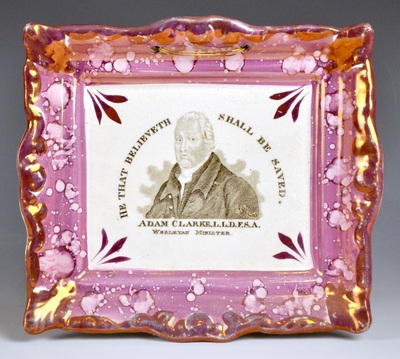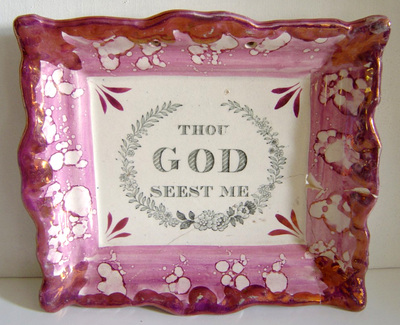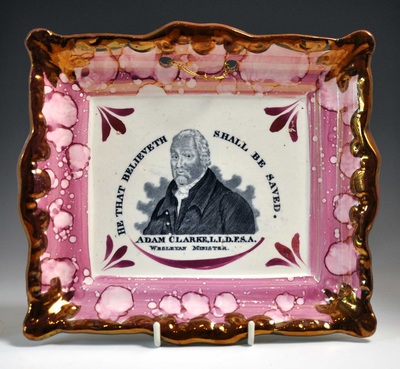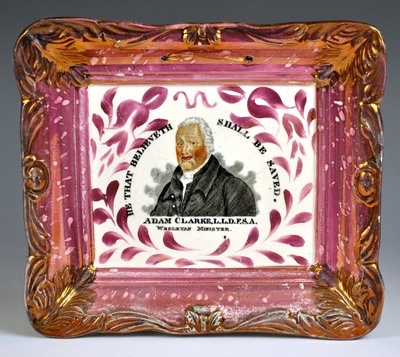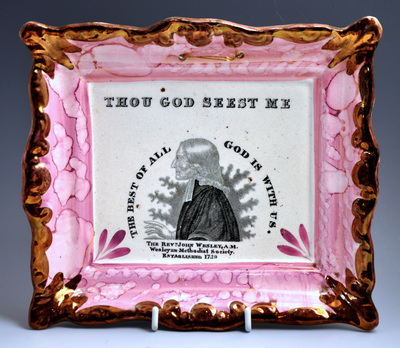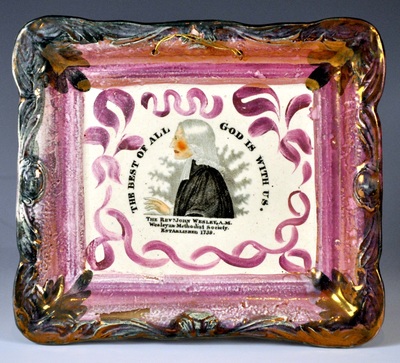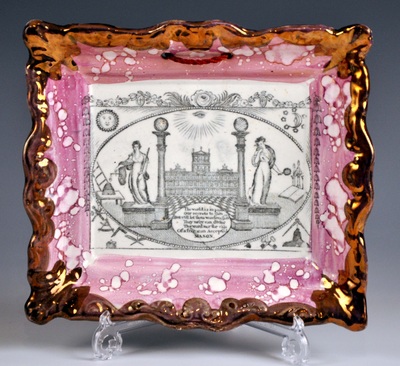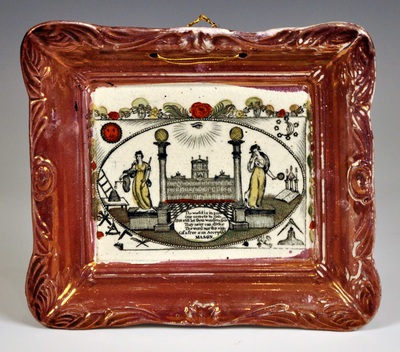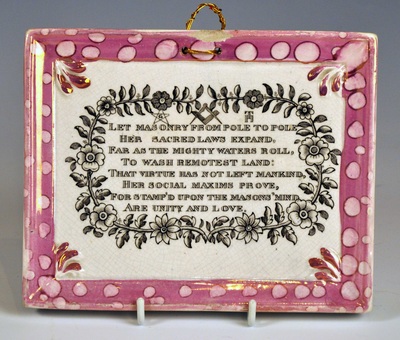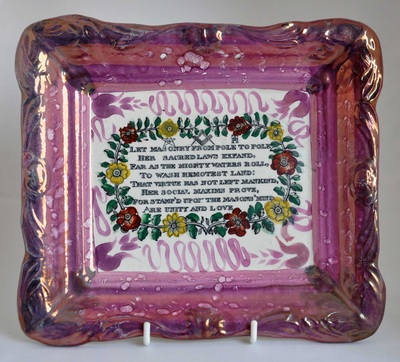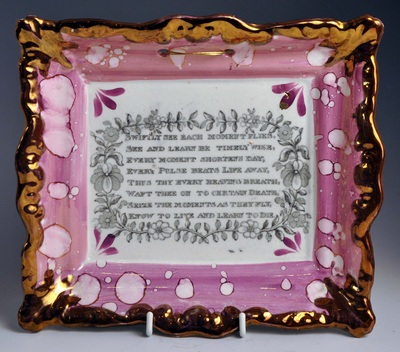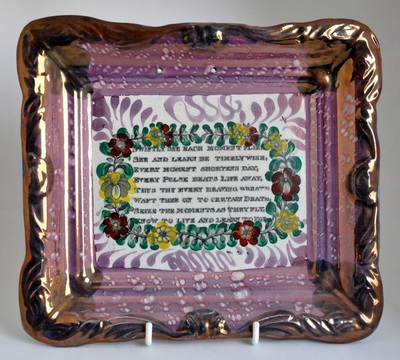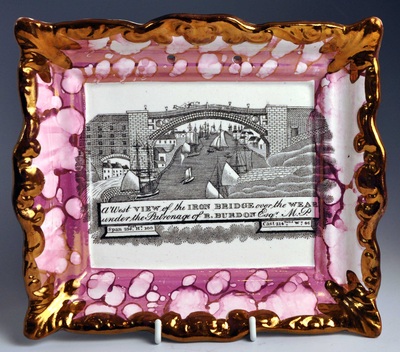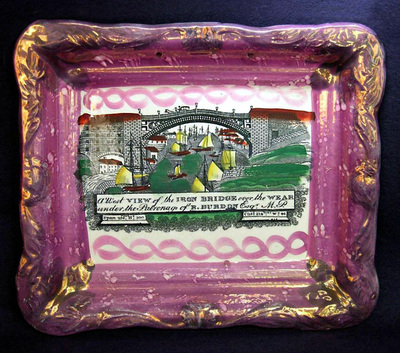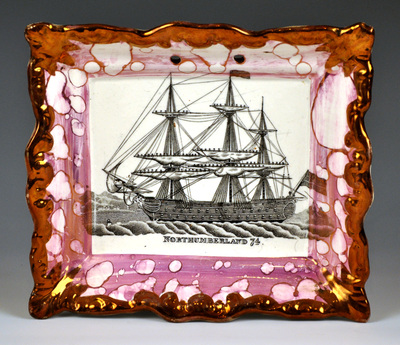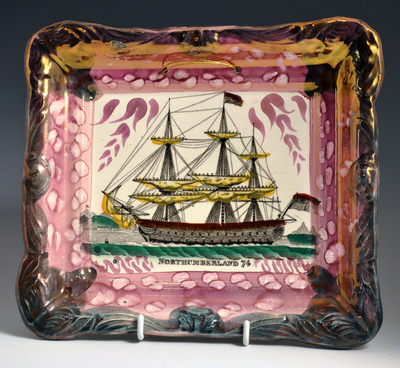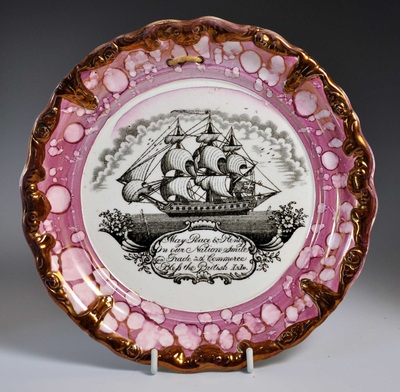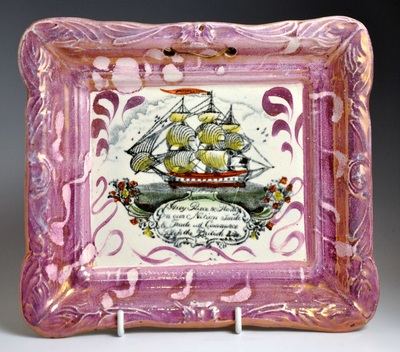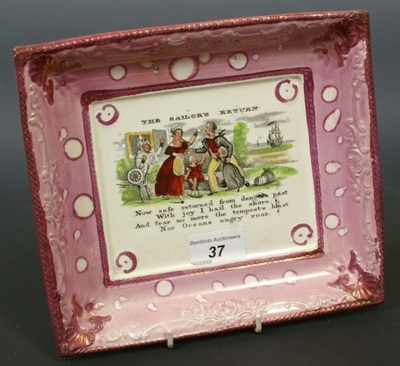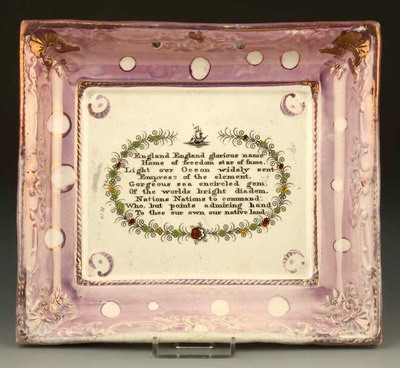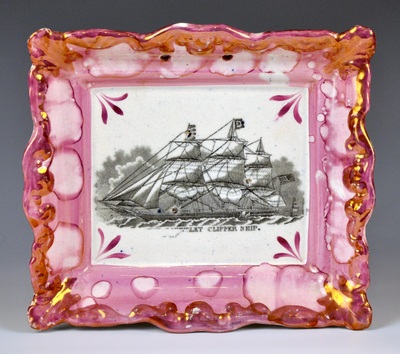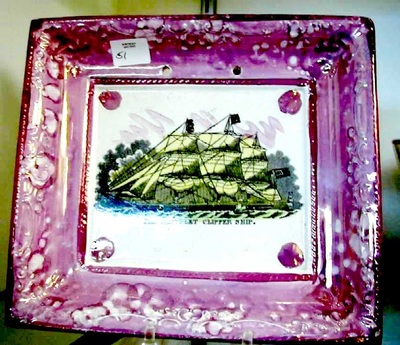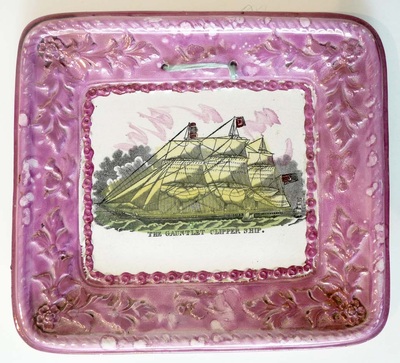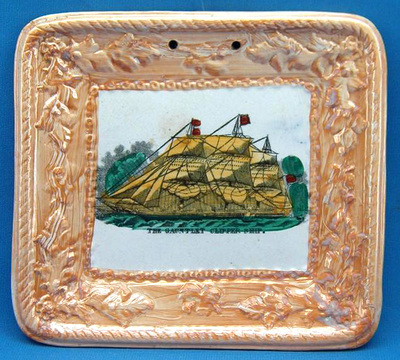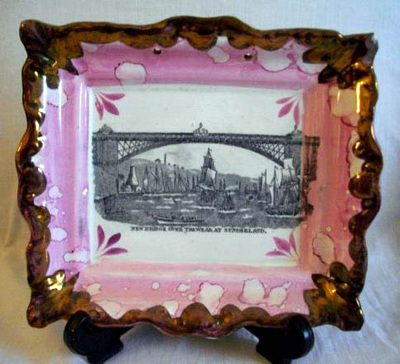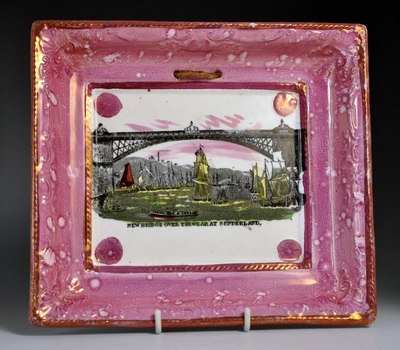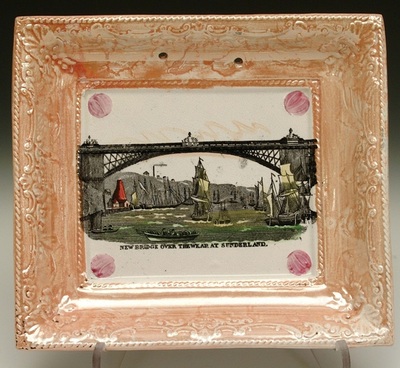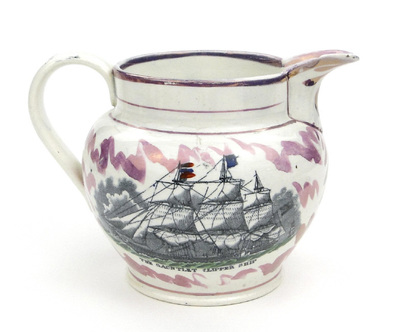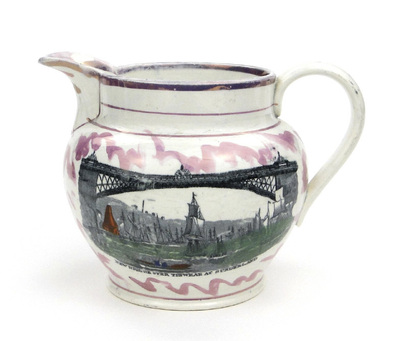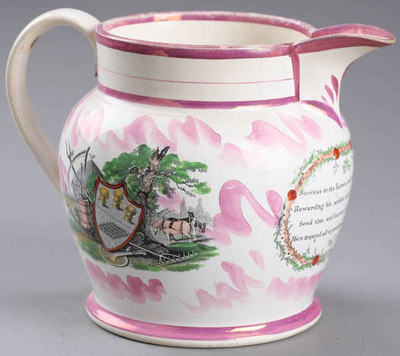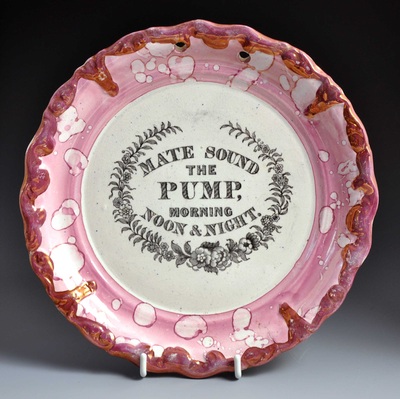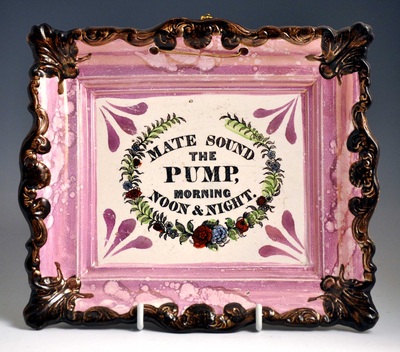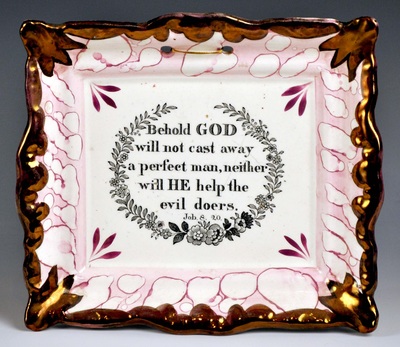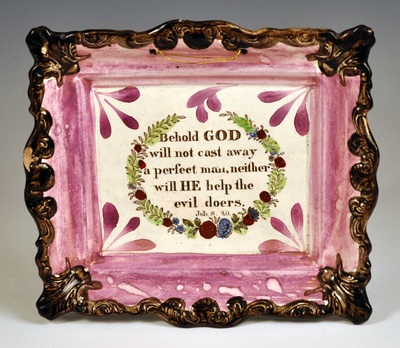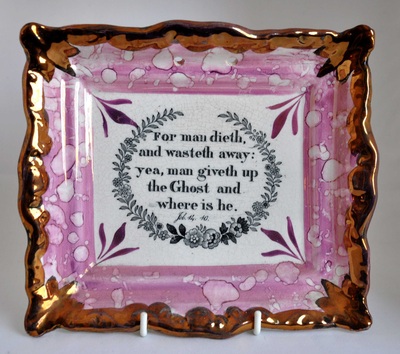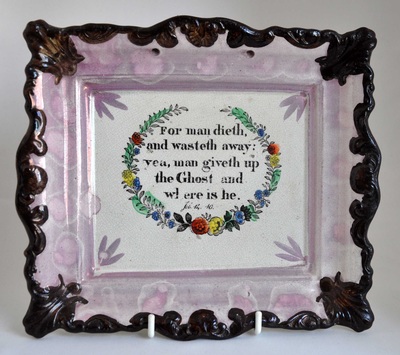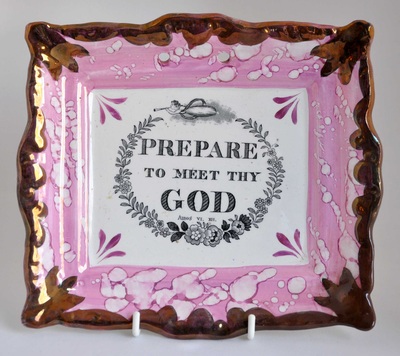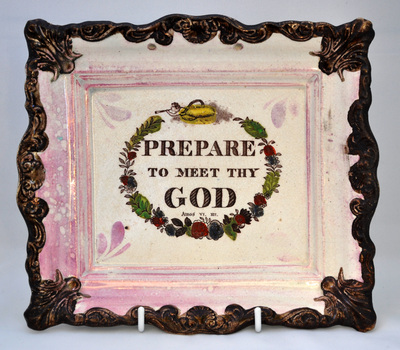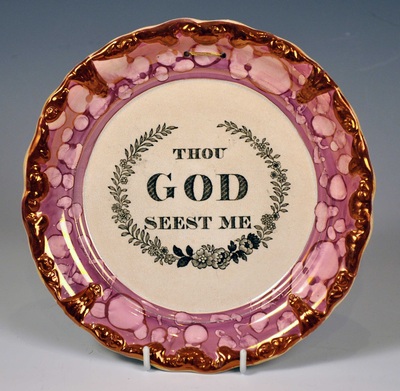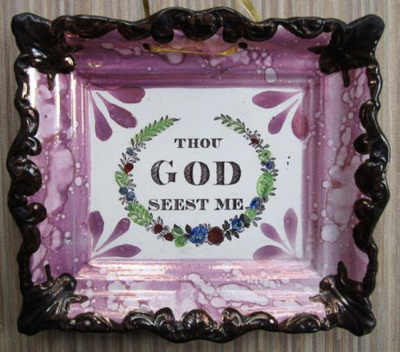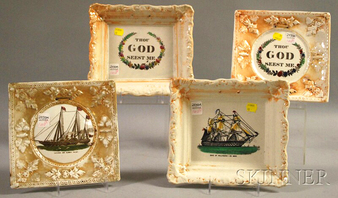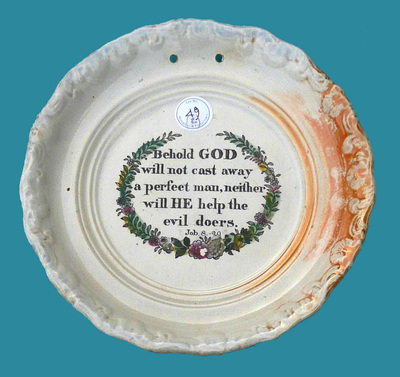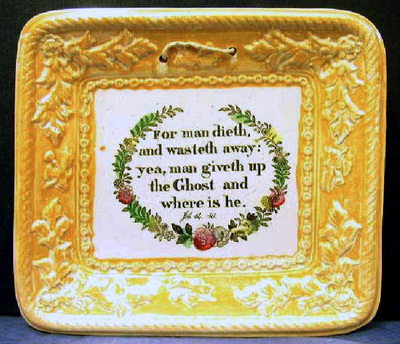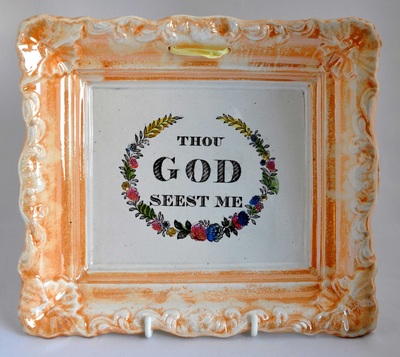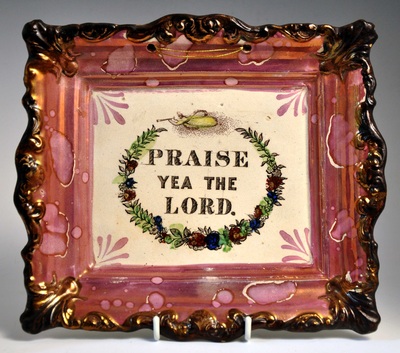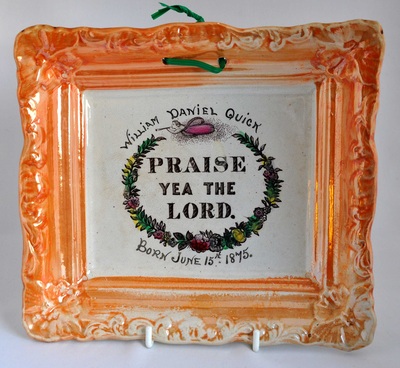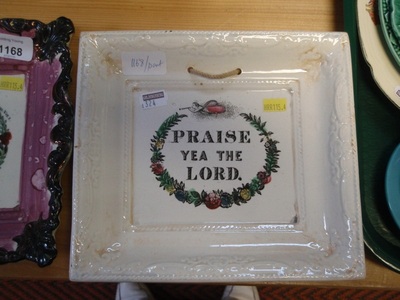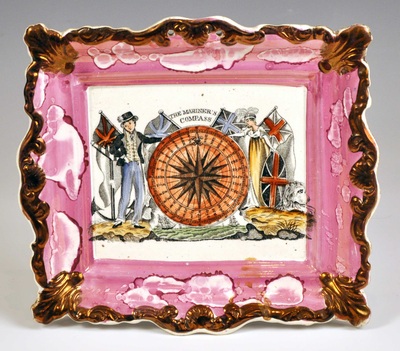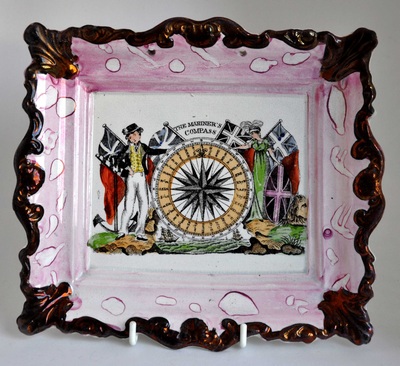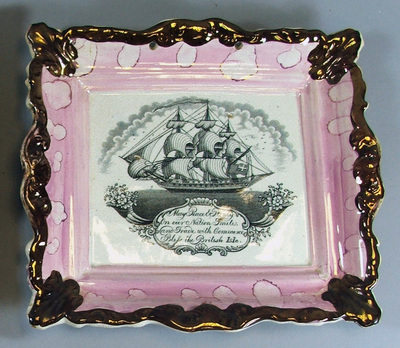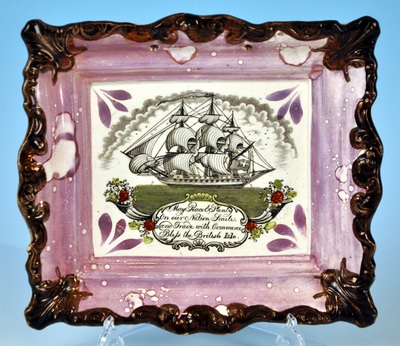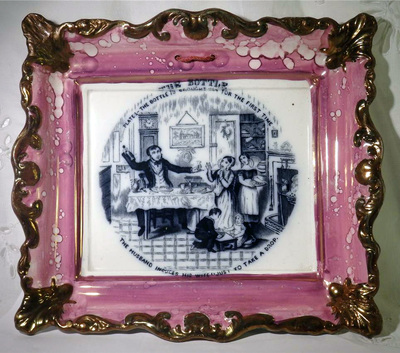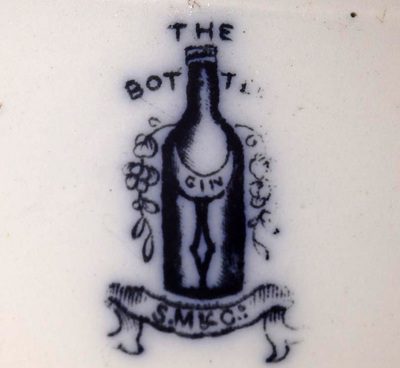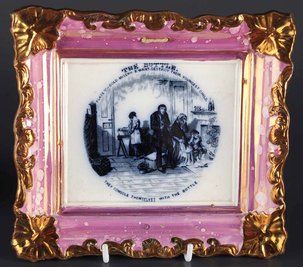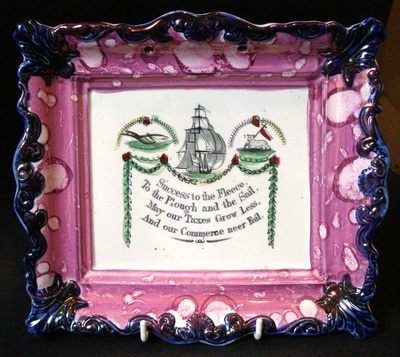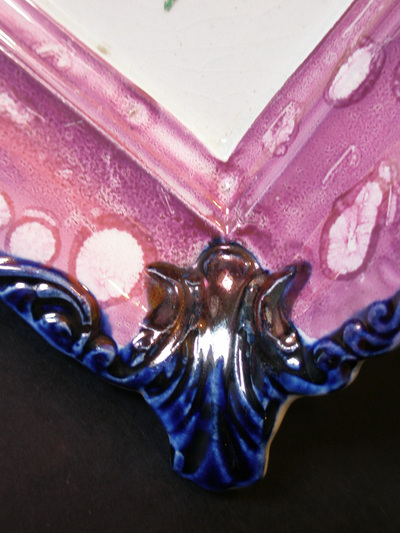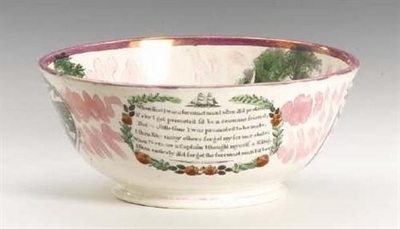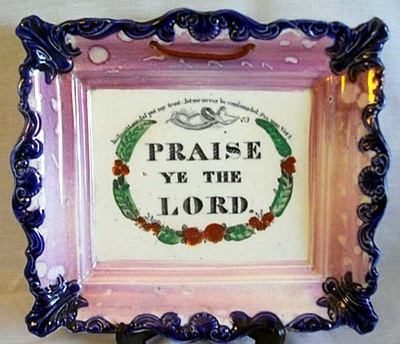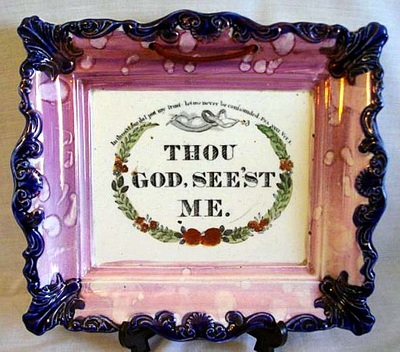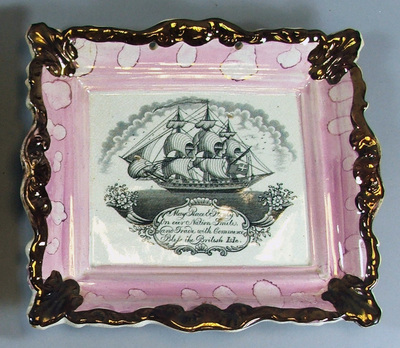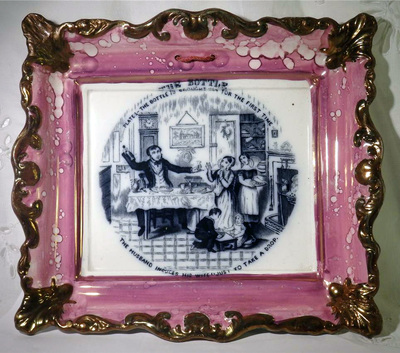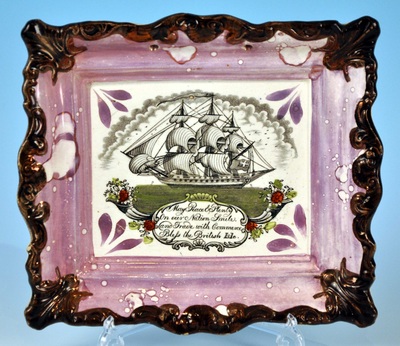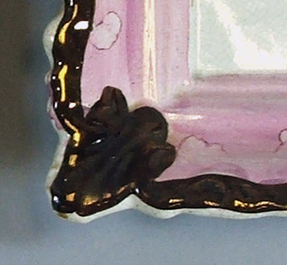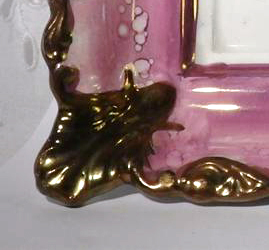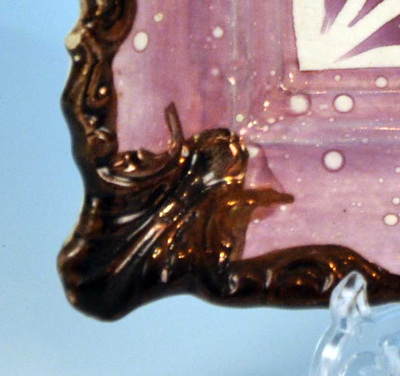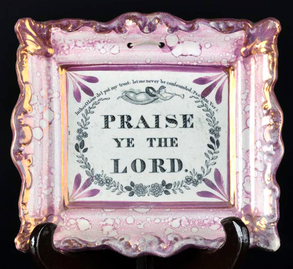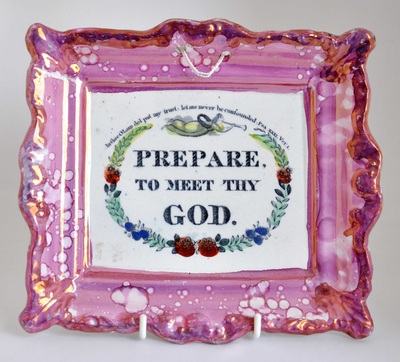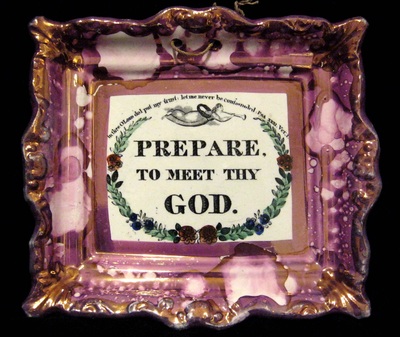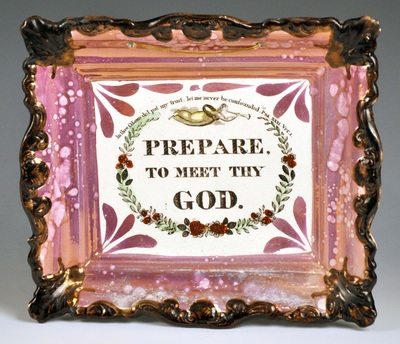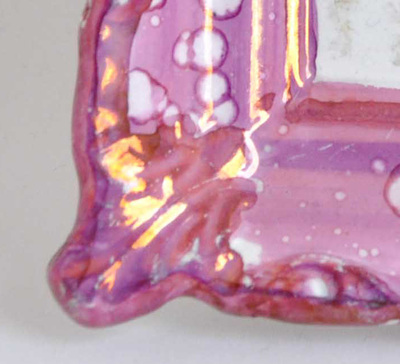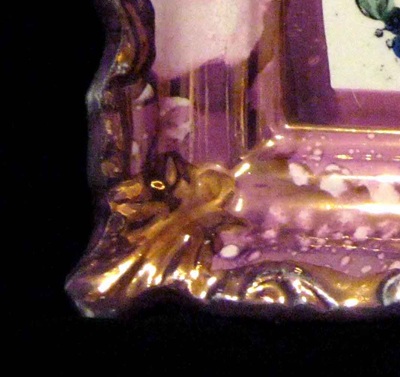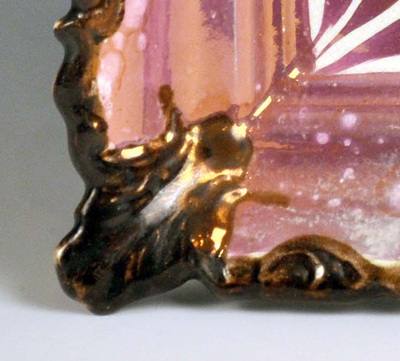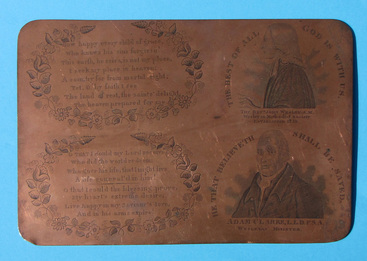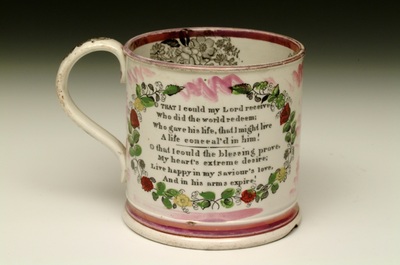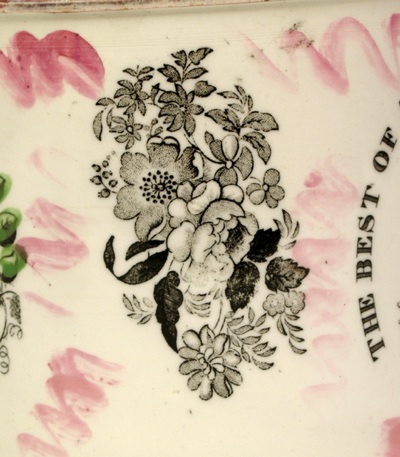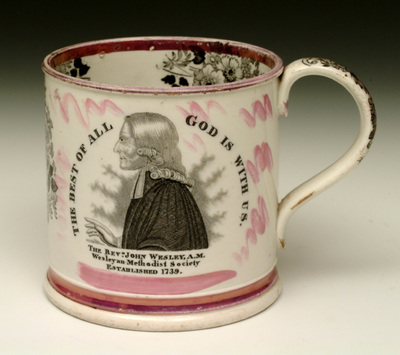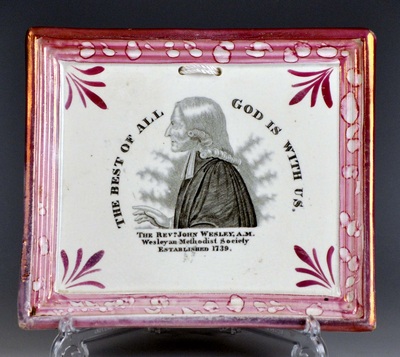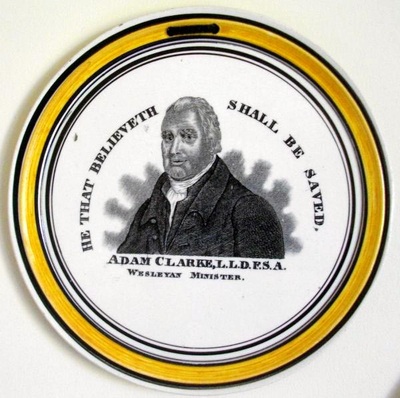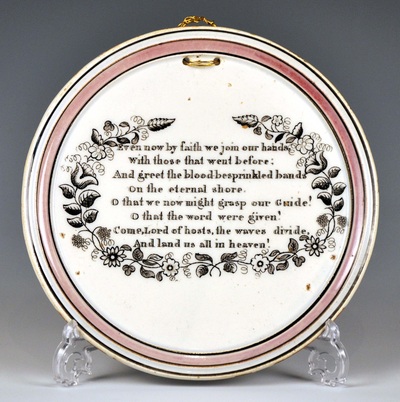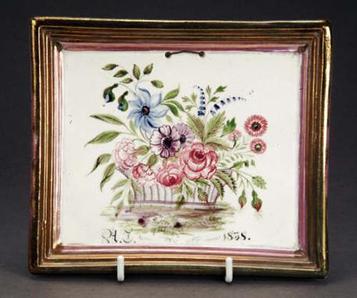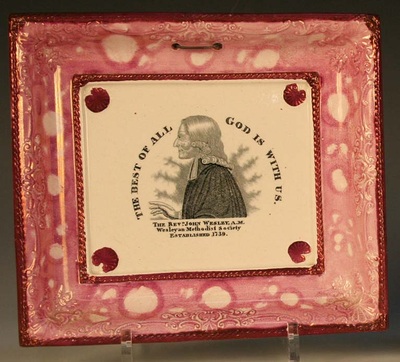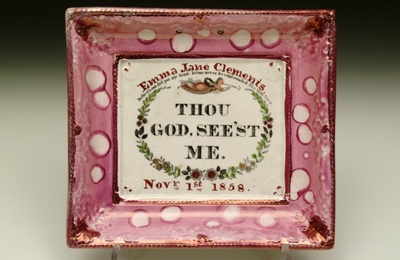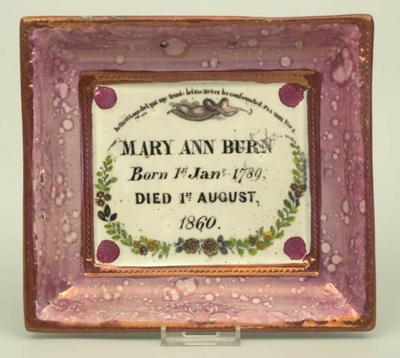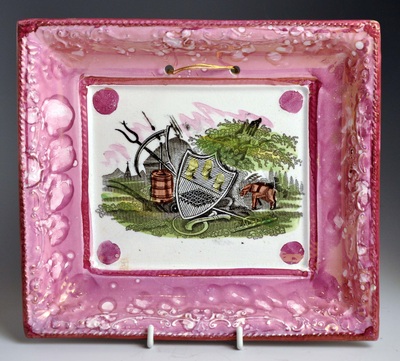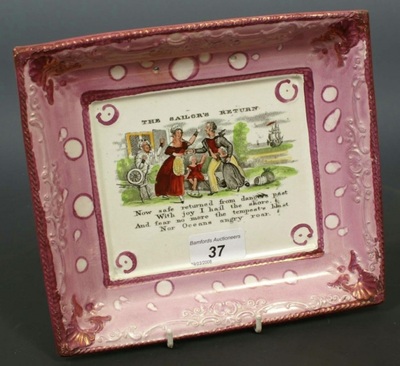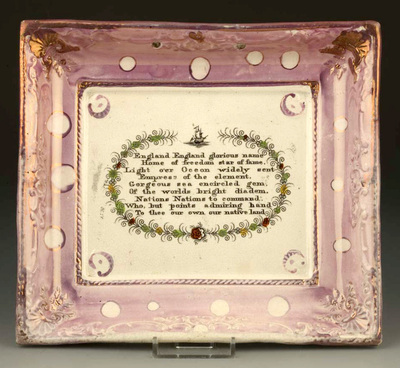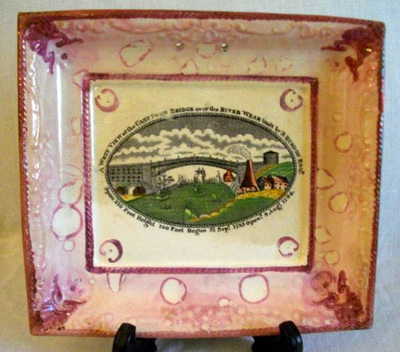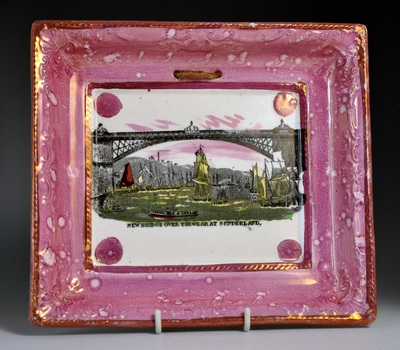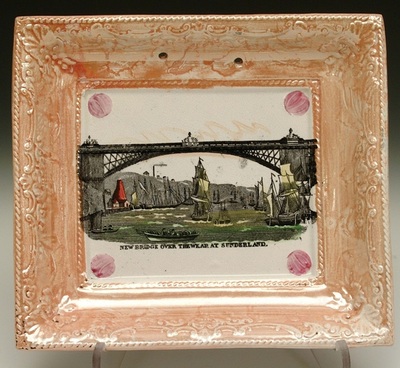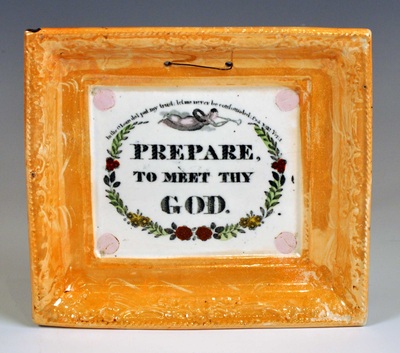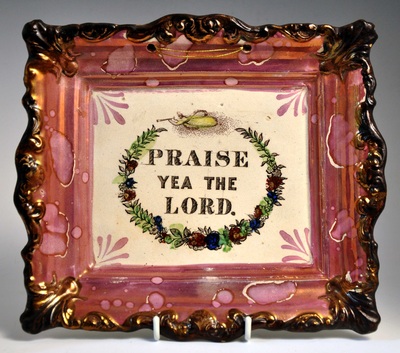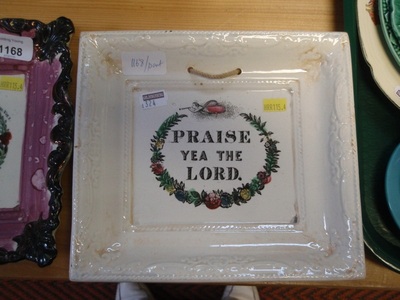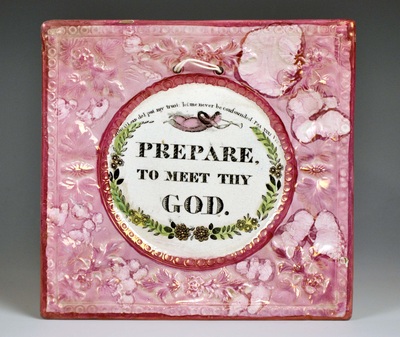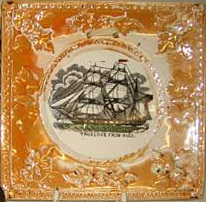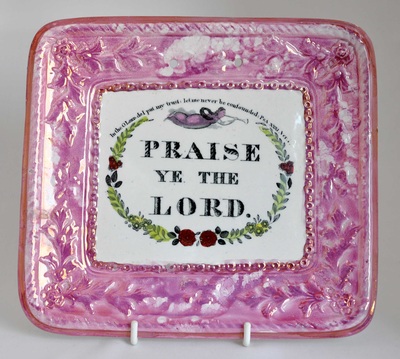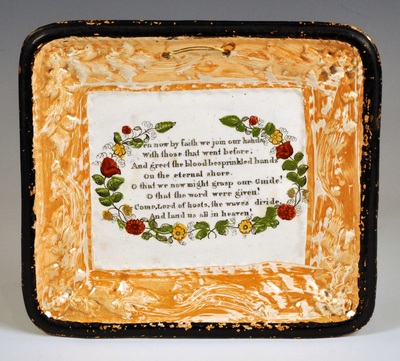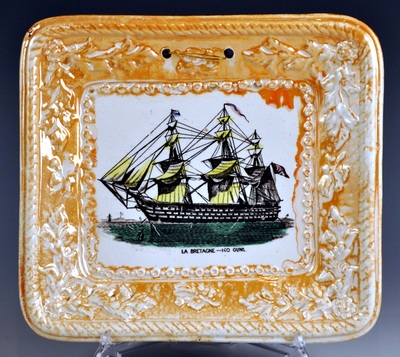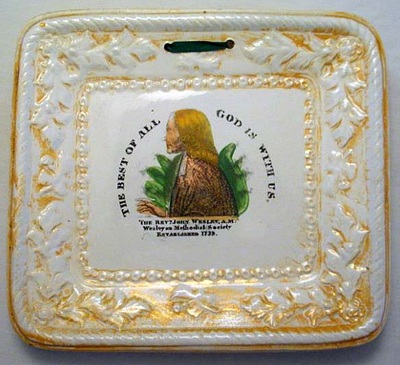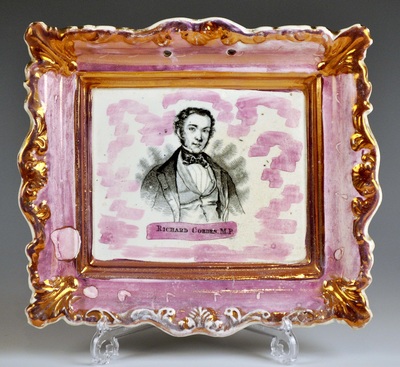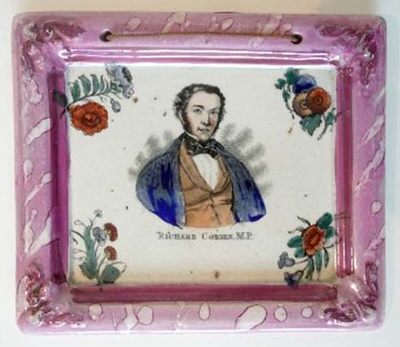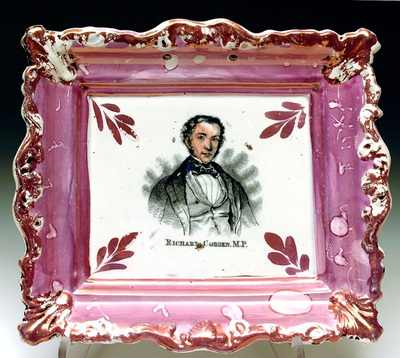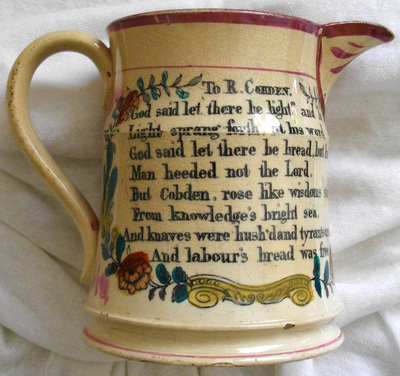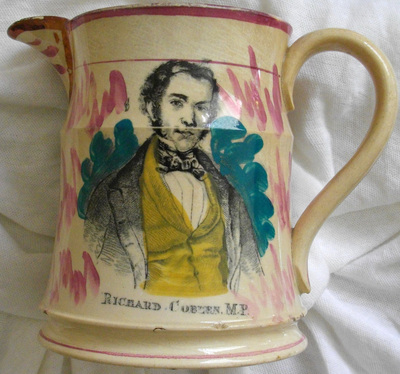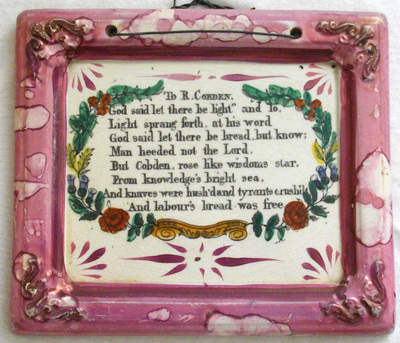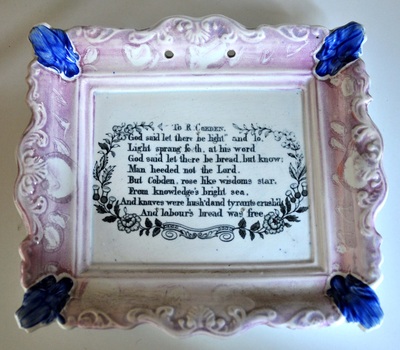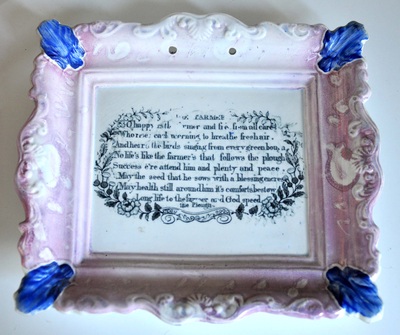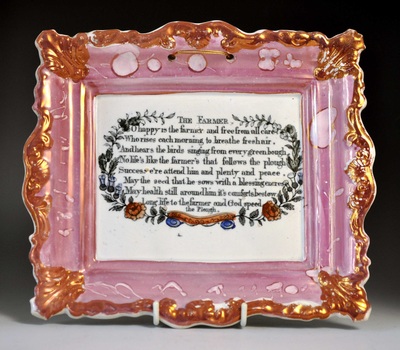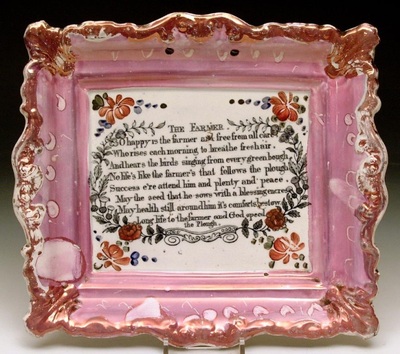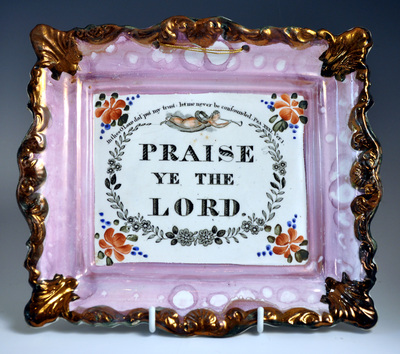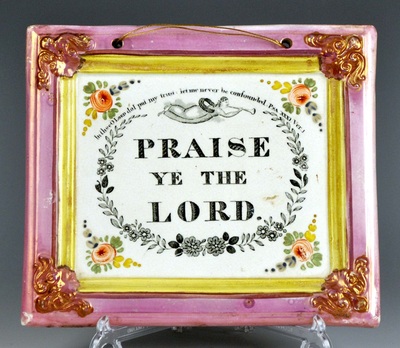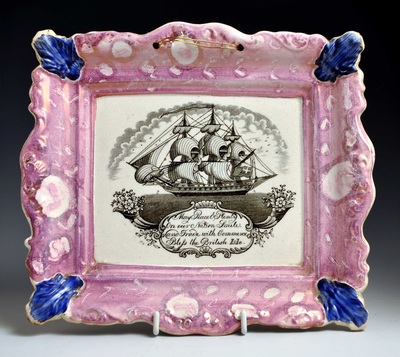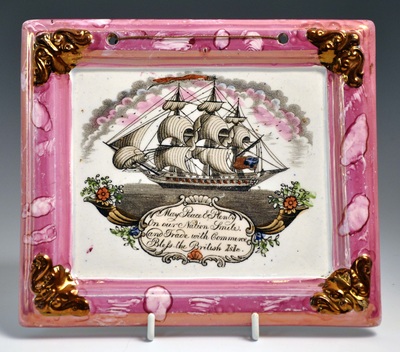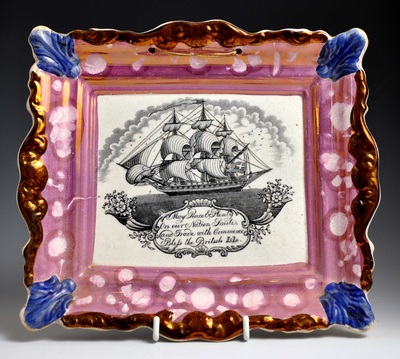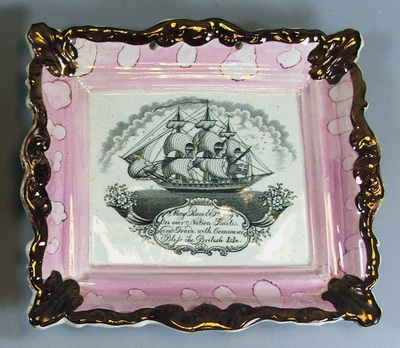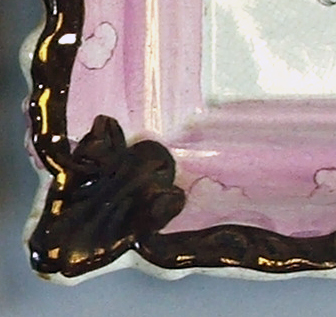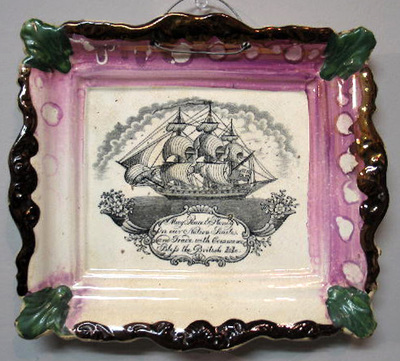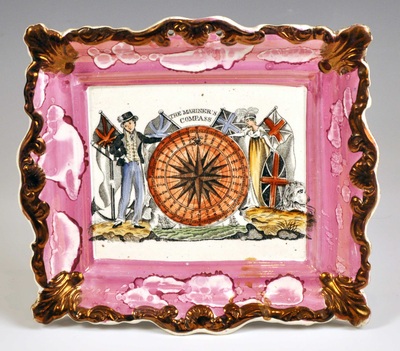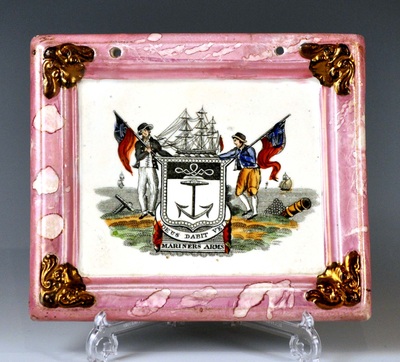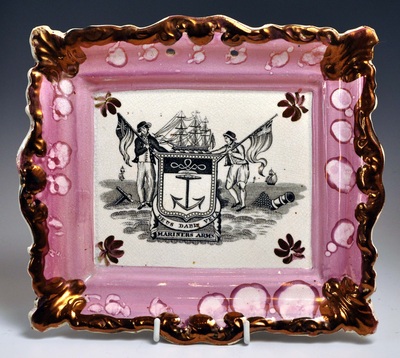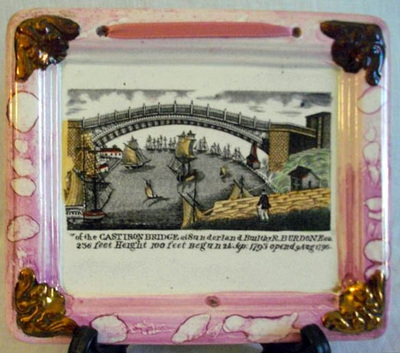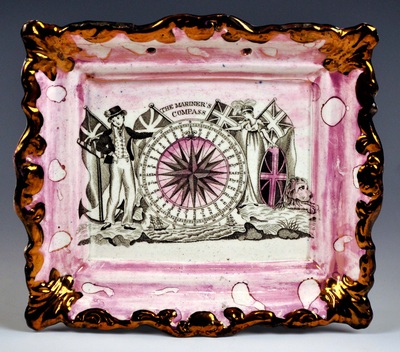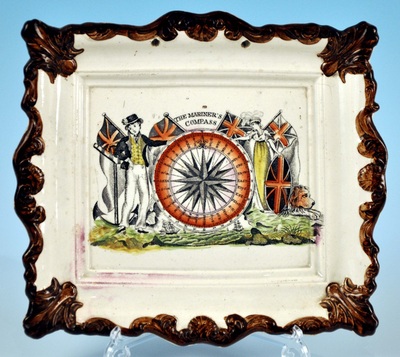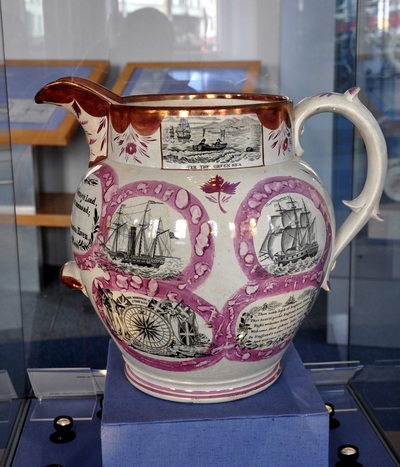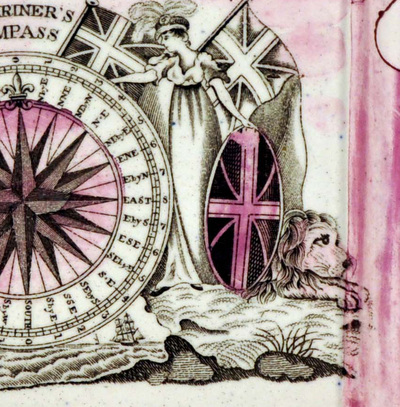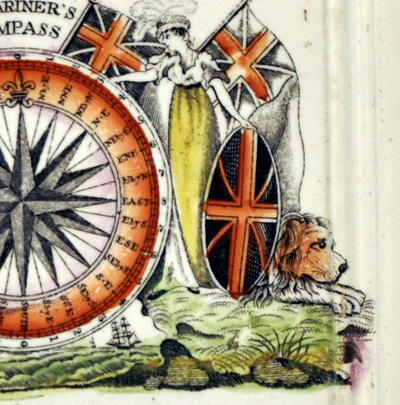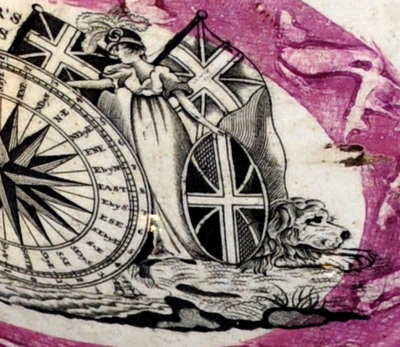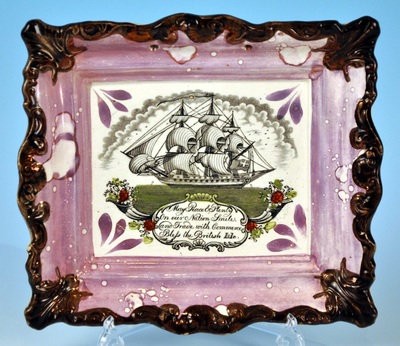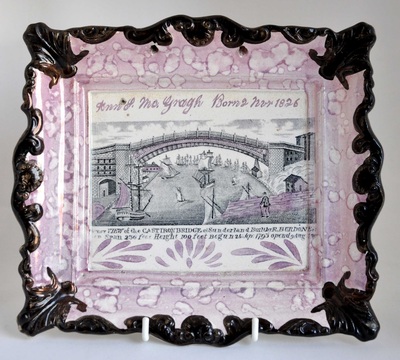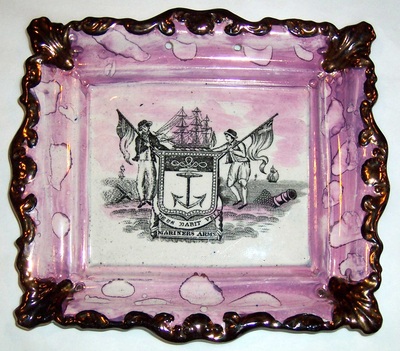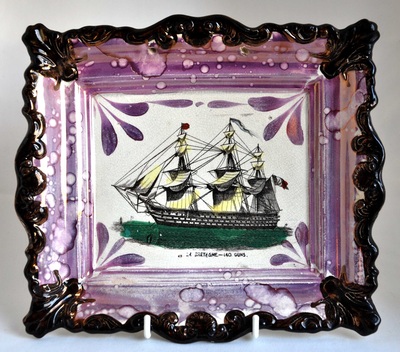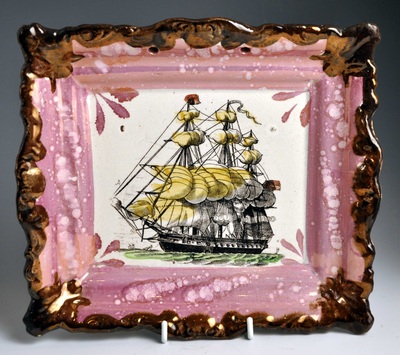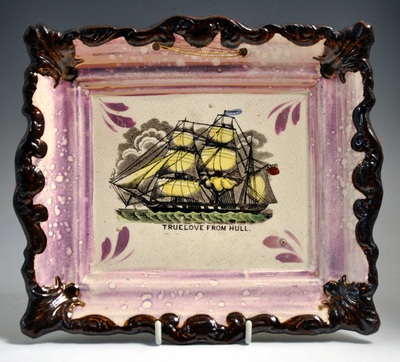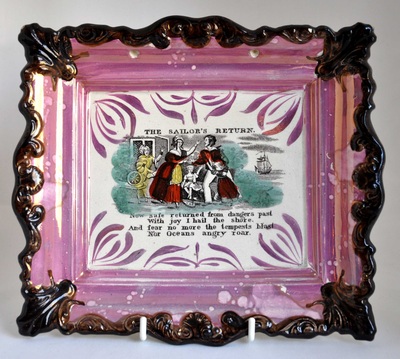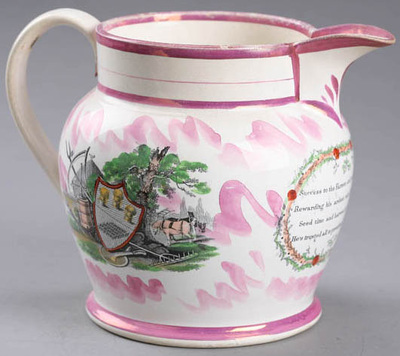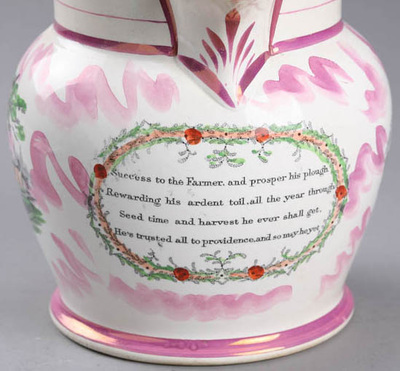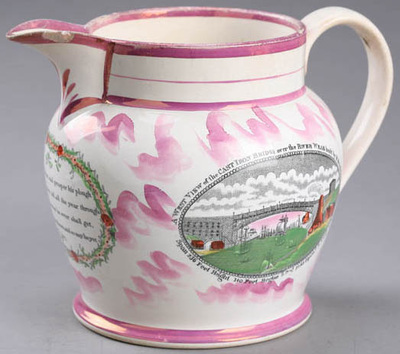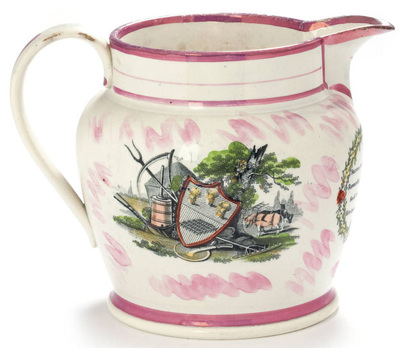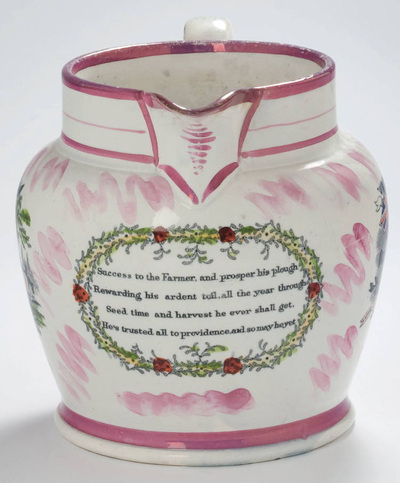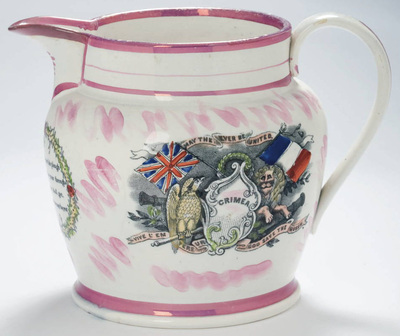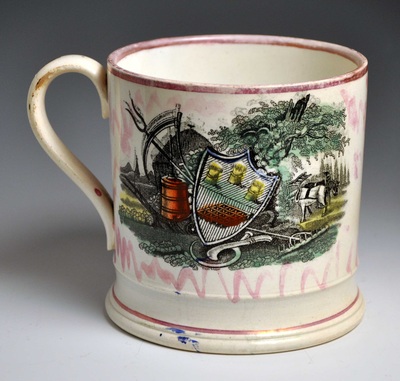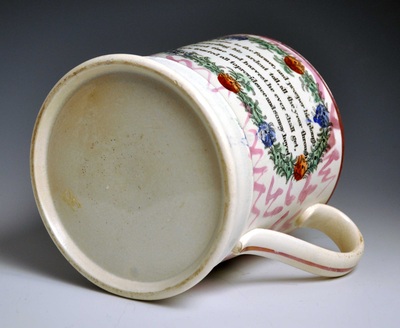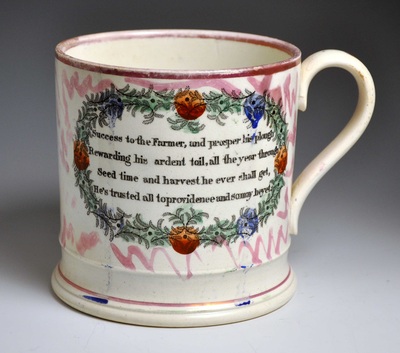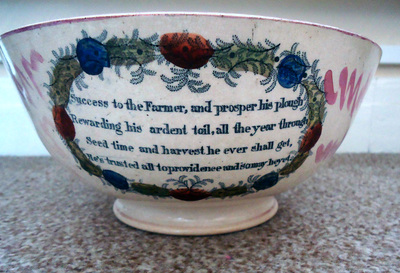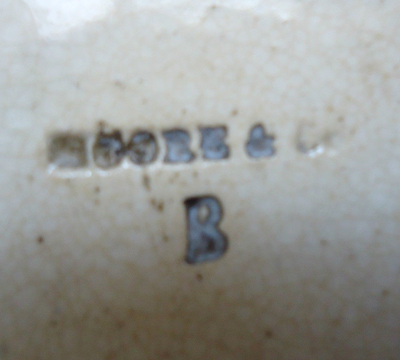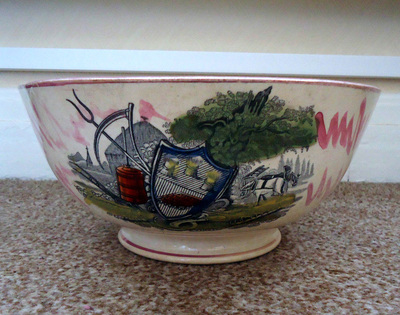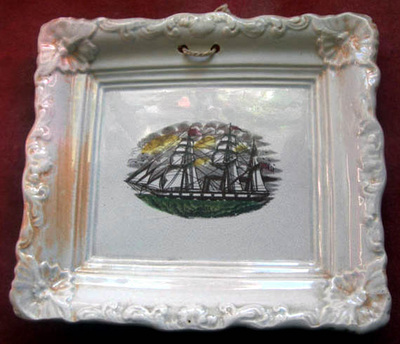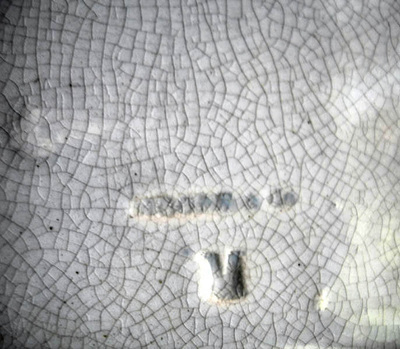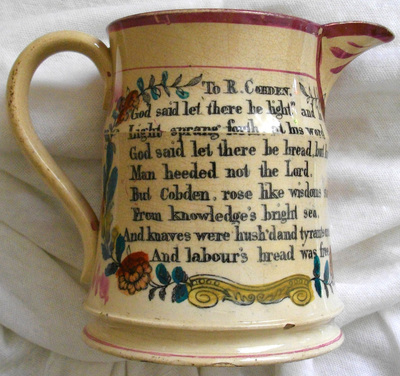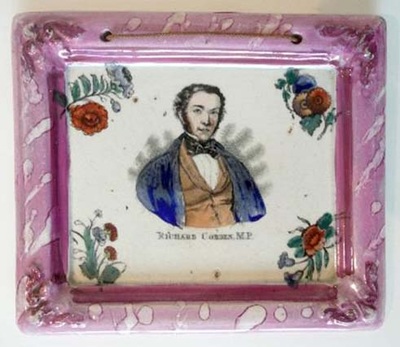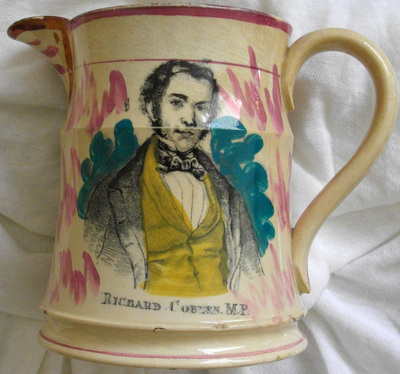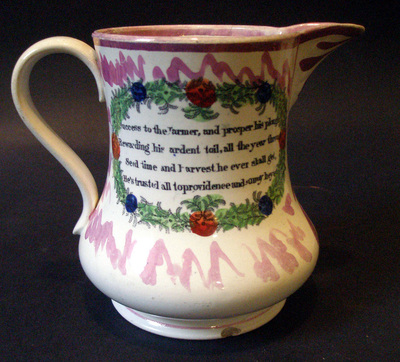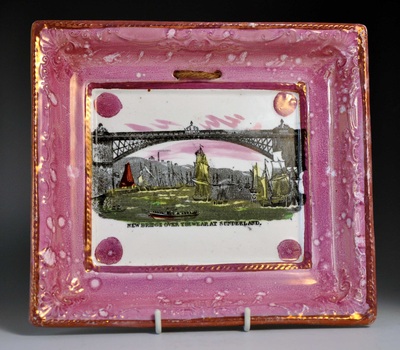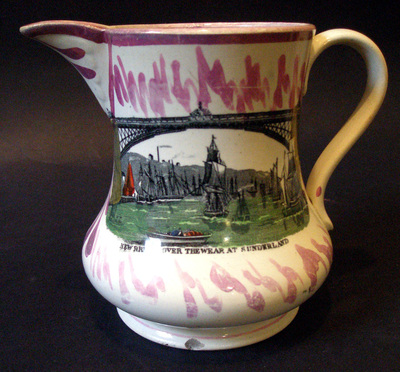|
7/31/2014 0 Comments The group 2 transfersIn my June 14 post, I looked at transfers I'd attributed to Scott's, and divided them into two groups. The group 1 transfers were straightforward enough, because they were traceable back to known Scott wares from the 1830s and 40s. The group 2 transfers' only link with Scott's was that they appeared on the brown-bordered plaques from the 1860s. However, I've since reattributed the brown-bordered plaques to Moore's. So that leaves us with an orphaned group of plaques with group 2 transfers from c1835-1860, the period before they likely arrived at Moore's. To recap, here are the transfers. Firstly the religious verses. The plate 2 Prepare transfer appears on a variety of plaque forms. The first below is attributed to Newbottle, the rest are currently homeless. The plate 3 Prepare transfer also appears to have started life at Newbottle High Pottery, and is found on a similar limited group of plaque forms... Likewise, the plate 3 Thou God transfer... ...and the plate 3 Praise Ye transfer. So if the transfers above started life at Newbottle in the 1830s and ended at Moore's in the 1860s, the strongest contenders to have made the (as yet unattributed) pink-lustre plaques above are Newbottle and Moore's. The argument for Newbottle... The black and yellow Praise Ye plaque was presented to the V&A in 1905 by a descendant of the owners of Newbottle High Pottery, along with a variety of other items. Some have questioned the breadth of objects donated, but archaeological digs of the High Pottery site have since confirmed the provenance of the most contentious items. The fact that Newbottle had two Prepare transfer plates suggests it was making plaques in considerable quantities. The argument against Newbottle... Very little is known about the lustre items Newbottle produced, as they don't appear to have marked anything (all the plaques above are unmarked). The argument for Moore's... Most of the 'group 2' transfers appear on brown-bordered plaques now attributed to Moore's. The argument against Moore's... We have a very clear idea of what Moore's was doing in the 1840-50s, and there's no evidence they used any of the plaque forms above, which never appear with Moore transfers. Conversely, the group 2 transfers don't appear on Moore plaque forms until c1860. Furthermore, there's no evidence of Moore's decorating plaques with hand-painted flowers or green (or blue) corners. And, the Prepare plate 3 above doesn't appear on brown-bordered plaques, so apparently never made it to Moore's. So it's looking like a one-horse race. If it were just the plaques above, we might say why not? And allow the new attribution to pass with little more thought. But attributing the group 2 transfers to Newbottle opens the doors for a an array of other plaques, which, until now, had no links with that pottery. The non-religious group 2 transfers are set out below. The May Peace and Plenty transfer appears on c1845-55 plaques of similar forms to those above, some of those with green or blue corners. The Mariners' Arms and Mariners' Compass transfers also appear on these plaque forms, and another (shown third below), which at first glance looks like a Dixon plaque, but is more heavily potted. A transfer of Richard Cobden appears on the small rectangular group 2 form (first below). It also appears on rectangular plaques, larger than those with brown borders attributed to Moore. It's likely these were made c1846, when the Corn Laws were repealed. A verse dedicated to R. Cobden also appears on the small rectangular plaques, and plaques with blue corners. A verse titled The Farmer sometimes pairs with the R. Cobden verse, and appears on plaques with blue corners and plaques decorated with flowers like those above. And finally, a view of the Cast Iron Bridge Over the River Wear also appears on the group 2 plaque forms. So that makes a hermetic group of 11 transfers and at least 7 plaque moulds, that don't precisely match anything produced by the larger Sunderland potteries - Dixon's, Scott's or Moore's - until c1860 when the transfers appear on the Moore-attributed brown-bordered plaques. All this is consistent with the transfer plates and moulds being at a self-contained location - a smaller pottery producing lustre items. And we have a credible Newbottle provenance, for the religious plaques at least.
More research needs to be done, but the only realistic attribution for these plaques, with the information currently available, is Newbottle High Pottery.
0 Comments
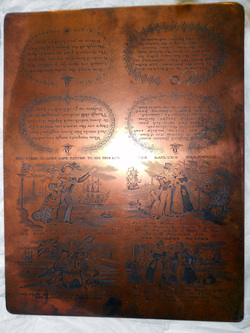 Huge thanks to Shauna Gregg at the Sunderland Museum for sending images of this copper transfer plate in the museum collection. Here's what Baker says about it... 'A copper plate was presented to Sunderland Museum by a member of the Ball family in 1963. [The transfers] are engraved on a copper plate manufactured by Pontifex and Stiles, 23 Lisle Street, London. In 1834, William Stiles joined Russell Pontifex, up to then trading as R. Pontifex and Son. The name was changed to Pontifex and Stiles until the partnership ended in 1839. As one of the designs on the plate has the name 'Dixon, Phillips & Co, one must assume that the firm changed its name some time between 1834–39. This copper plate appears to have passed through the hands of either Moore's or Scott's (possibly both) and finally to Ball Brothers.' From press announcements we now know that the Dixon, Phillips & Co partnership began in 1839. So if the copper plate was engraved by Pontifex and Stiles for that partnership, it could only have been made in that year. And if it did start life at the Garrison Pottery (Dixon's), it likely would have found its way to Moore's and/or Scott's after 1865, when the Garrison Pottery closed. But there are a couple of 'ifs' in this paragraph. The TokenSo was the above transfer plate used by Scott's or Moore's, or both? Below left is a bowl attributed to Scott with similar transfers, and below right, a brown-bordered plaque attributed to Moore. If you look at the details of the transfers, it's clear that the plaque (right details) has a transfer from a different copper plate. The bowl, however, has a very similar transfer to the copper plate above (see left and centre details). The Sailor's FarewellThe differences between the Sailor's Farewell transfers are even more pronounced (Scott-impressed bowl below left, Moore-attributed plaque below right). The sailor is wearing a completely different hat (bowl centre, plaque right). There's a crucifix-shaped mast behind the woman's head in the Scott version, which again is very similar to the copper plate (left). However, for all the close similarities, I think the Scott version also comes from a different transfer plate. Compare the two details below. The shadows under the man's feet, the raised oar in the rowing boat in the Scott version. And yet, the spacing of the lettering is identical. At first I thought this might be down to the image having been re-engraved. But more likely, the image of one of the copper plates was transfer printed onto copper, which was then engraved to form a copy/second plate. The Sailor's ReturnSo if the copper plate corresponds neither with transfers used by Scott's nor Moore's, where was it used? Ian Holmes has a bowl on his United Collections website that certainly comes from this transfer plate. Below is a comparison of the Sailor's Return transfer on the Scott attributed bowl (left) and Ian's bowl (right) attributed to Ball's Deptford pottery. If you move between the images, you'll see the Ball's bowl is the perfect match. One blindingly obvious difference between the transfers is the printed mark 'Dixon Phillips & Co Sunderland' which appears on the Ball's bowl and on the copper plate. If the Scott version (top detail below) were copied from an 1839 Dixon's copper plate, Scott's might well have chosen to omit the printed mark. But, as Ian Holmes points out, the mark appears to have been added as an afterthought, squeezed into a narrow gap, with bits of shading running through it, and in decidedly spidery script. The Flag that's Braved a Thousand YearsThe last of the pictorial transfers on the copper plate also has the 'Dixon Phillips & Co Sunderland' mark. In this case we're comparing the transfer on a Scott-impressed bowl (left), with the Ball's-attributed bowl (right). There are many subtle differences with the Scott transfer (below left), but in particular note the top of the crutch of the sailor on the right. This is more than just later re-engraving. The Scott transfer almost certainly comes from a different copper plate. And again notice how the Dixon mark has been squeezed into a gap (Scott version top). It again runs over the shaded areas, suggesting that it was added at a later date. The transfer plate above may have originated at Dixon's - we'd need to know more about why Baker was so sure it was engraved by Pontifex and Stiles. Is there a mark on the copper plate somewhere? - I couldn't find one. Even if that were proven, it wouldn't necessarily follow that the 'Dixon Phillips & Co Sunderland' mark was genuine. Ball's has an already murky reputation as a pottery that printed items with other potteries' marks. But forging a mark would take them into a whole new league. Could the Ball's family inadvertently have donated evidence of forgery to the Sunderland Museum? We may never know, but we owe them a huge debt of gratitude for saving the copper plate. One thing that might settle it would be to find an 1840s or 1850s Dixon item with the Ball's transfers. However, in many hours of searching over recent weeks, I haven't found anything from Dixon's with these transfers. Some last thoughtsMoore's, Scott's and Ball's appear to have used different versions of the transfers that appear on the copper plate in this post (I could have done a similar exercise with the verses, but you would have lost the will to live). It would have been tidier if the Scott transfers matched those on the copper plate, and if the Dixon attribution of the plate had been stronger. That way, we could have fairly confidently dated the Scott items to post-1865 when the Garrison Pottery closed.
But with regards to my thoughts of recent weeks, nothing much has changed. We already knew that the Scott versions of these transfers were likely used in the 1860s, because of similar plaques with dates in the Sunderland Museum (see below). And yes, that's the period when the brown-bordered plaques were produced. The 'Scott' versions of these transfers never appear on Moore's items. However, the 'Moore' versions of the transfers do appear on Scott's items, likely because Scott's sent them to Moore's for decoration. I've spent weeks (years) thinking about the transfers shared by Scott and Moore in the 1860s. The brown-bordered plaques (left below), made during that period, are probably most associated with the series of common ship transfers. Those transfers rarely appear on items with the Moore impress, and yet frequently appear on bowls with Scott impressed marks (right below) and on the jugs that pair with them. For this reason, the brown-bordered plaques, which are never marked, are almost universally attributed to Scott. I'm now as certain as I can be that's wrong, and have set out the reasons below. 1. Moore's made marked items with the ship transfers in the 1850sThe two plaques below, which pre-date the brown-bordered plaques, both have 'Moore & Co' impressed marks. As does the bowl from Bonhams, with ship transfers and the date inscription, 1859. This evidence alone would be enough to make the case, were the attribution of the brown-bordered plaques to Scott not so widely held. The Moore-impressed items are relatively rare, which is why I believe they've been overlooked. 2. Moore's made similar looking plaques in the 1850sAlthough there's no evidence of Moore's using the larger rectangular mould of the brown-bordered plaques during the 1850s, they made smaller plaques with almost identical lustre decoration. Compare the corner of the Bottle plaque (top centre) which has a Moore printed mark, with that of a plaque with brown borders (top right). Also, compare the decoration on the 1850s' Moore plaque (bottom left), with that of the brown-bordered plaque with the same transfer. 3. There are very few plaques attributable to Scott from the 1850sThe only plaque forms firmly attributable to Scott's are those with group 1 transfers (see three examples below). The first two were likely made in the 1830s or 40s. We know from examples of the last plaque form with hand-painted dates that they were made from c1858 onwards. Scott's doesn't appear to have made plaques during the early- to mid-1850s (unless they continued to make the earlier plaque forms for longer than imagined). So it seems fair to say that Scott's had a very limited stake in making plaques. And the plaques it did produce look nothing like the brown-bordered plaques. 4. There are very few bowls marked Moore from the 1860sMoore's made a fair number of bowls during the 1840s and 50s (see below), but appears to have stopped making them in the early 1860s. This proves nothing in itself, but might hint at a division of labour during this transfer-sharing period, with Scott's making bowls and jugs, and sending them to Moore's for decoration. With Moore's, meanwhile, focussing their efforts on making plaques, as they'd done so prolifically during the 1840s and 50s. 5. The majority of transfers on brown-bordered plaques originated at Moore'sAs discussed in my June 29 post, the majority of the transfers that appear on the brown-bordered plaques, which are traceable to earlier wares, originated at Moore's. There's no obvious reason to believe that Moore's would cede such a large number of transfer plates to neighbouring Scott's. Isn't it more likely that Moore's continued to decorate items with its own transfers? The simplest answer is always the best. 6. Scott's transfers don't appear on brown-bordered plaquesIf Scott's made the brown-bordered plaques, why didn't they decorate them with their own transfers? The Scott group 1 transfers never appear on brown-bordered plaques. Not even the Prepare to Meet Thy God (plate 1) that was used well into the 1870s. The Scott versions of the Sailor's Return and Farewell and associated transfers (see left below) and the Scott months (see right below) never appear in conjunction with the common ship transfers, nor on the brown-bordered plaques. And yet, Scott was widely using these transfers at the time the brown-bordered plaques were produced. The only good reason for these two groups of transfers remaining so completely discrete, is that the copper plates were held at different locations. 7. The lustre decoration on jugs and bowls with ships matches Moore itemsLustre decoration is more difficult to pin down, and it seems likely that both potteries had several people (women? children?) decorating items with lustre. But each pottery had a different house style. Moore's decoration tends to be in long unbroken lines of zig-zag markings (see below left), whereas Scott's tends to be more fluid and curvy, with marks in shorter bursts (see below centre). The Scott items with ships (below right) tend to have 'Moore' decoration. 8. The ship transfers never appear with Scott's flowersAlthough both Scott's and Moore's decorated jugs, mugs and bowls with flowers in the 1840s and 50s, only Scott's continued into the 1860s. Scott's flowers from that period (see left and centre below) never appear in conjunction with the ship transfers, whereas they commonly appear with the Scott group 1 transfers. Scott's made large numbers of jugs and bowls during this period, and decorated some themselves with their own (group 1) transfers and flowers. They appear to have sent others to Moore's for decoration with ships (below right), and those items never appear with Scott flowers. 9. Moore's was a bigger pottery than Scott'sDuring the 1860s Moore's went through a period of modernisation and expansion. A manager called Ralph Seddon from Staffordshire was appointed, and 'on his advice the works were largely rebuilt and equipped with modern machinery'. Between 1866 and 1872 the pottery was reported to be the largest on Wearside. Operating at full capacity, Moore's could have employed up to 250 hands, although was reported to have 180 during this period, whereas Scott's employed about 150 (Baker). If we put aside the decoration of plaques, jugs and bowls with ship transfers, we still have a clear idea of what Scott's was doing in the 1860s. They potted a large number of jugs, ewers, and bowls, and they decorated many of them with their own (group 1) transfers, often with typical flower decoration. They made their own particular rectangular plaque form, and decorated those plaques with the group 1 transfers. But what else was Moore's, the larger pottery, doing during that period? If you subtract the brown-bordered plaques, and decorating items for Scott's, very little remains by way of lustre items. However, according to Baker, it wasn't until 1875 that Moore's 'concentrated chiefly on making dinner sets of various patterns, abandoning what it considered the old-fashioned transfer-printed pink lustreware'. Moore's had the capacity to make the brown-bordered plaques, and to take in pottery from other factories for decoration. Aside from doing that, it's unclear what else the pottery was producing, by way of lustreware, during this period of technological improvement and expansion. 10. Records show that Scott's sent items to Moore's for decorationBaker writes that 'the transfers used by Scott's were frequently the same as those used by the nearby Wear (Moore's) Pottery. Moreover, according to the firm's records Scott's supplied earthenware to Moore's Wear Pottery [...] presumably plain for decoration.' The group of transfers that Baker is referring to are those that appear on brown-bordered plaques. There's no evidence of sharing of Moore's or Scott's transfers from the 1840s. And there's no evidence of Scott's sharing its group 1 transfers, until c1870, and the orange lustre period. I'm still waiting for a response from the Sunderland Museum regarding the records Baker referred to. However, regardless of the date of the records (if they are indeed dated), I believe, for all of the reasons above, that there's compelling evidence that Scott's sent items to Moore's for lustre decoration in the 1860s. Having finally come out of the closet with a Moore attribution for the brown-bordered plaques, I have hours of work to do correcting the information on this site. And in case you thought it was all neatly sewn up, there's still the issue of the group 2 plaques in my June 14 post. Did those transfers originate at Scott's, Moore's, Dixon's or Newbottle High Pottery, or another Sunderland Pottery not yet considered?
Thanks to anyone who has read this far. If you have evidence against my reasoning above, I still am, and always will be, happy to consider it. 7/13/2014 0 Comments Odds and endsGeneral Joseph GaribaldiThanks to Elinor Penna for providing the right image below of a brown-bordered plaque titled 'General Joseph Garibaldi'. Although the green used is different - there are at least three variants of green enamel that appear on these plaques - it is otherwise decorated very similarly to Norman Lowe's Scott-impressed bowl (left below). Although the bowl is marked Scott, you can see in this photo the typical zig-zag decoration, like a letter M, used by Moore. Garibaldi visited London in 1864 and it's possible that these items were made to cash in on this visit. This transfer, however, also appears on earlier Moore plaques, and might have originated at the time of Garibaldi's stay in Tyneside in 1854. Joseph is, of course, the anglicised form of Giuseppe. Moore and Scott flowersThanks to Norman Lowe for the photos of the chamber pot below (first three images) from the 1850s. It has a bridge transfer with the small inscription, 'Moore & Co Southwick', underneath (see top centre detail). It also has flower decoration (what better place to have posies of flowers than around the rim of a po?). As discussed already, flower decoration is more commonly associated with Scott's. Look at the jug below, with a similar bridge transfer, but with a hard-to-read Scott inscription. At first glance the flowers on the items look very similar. So could the two potteries have shared the same copper plates with flower transfers? I still believe the answer to be an emphatic, 'No'. Look at the details below: the left from the Moore chamber pot, the right from the Scott jug. Although one set of flowers is clearly copied from the other, they come from different transfer plates. Moore's appears to have stopped decorating items with flowers sometime in the 1850s, whereas, as discussed in previous posts, Scott's continued into the 1860s. It isn't beyond the realms of possibility that one day a jug or bowl will appear with the common ship transfers and flower decoration. However, I'd expect the flowers to be Moore's. Dixon transfers acquired by ScottThanks to Ian Holmes for the photo of the Scott-impressed bowl below, which has the whole gamut of Dixon transfers: The Gauntlet Clipper Ship, The Agamemnon in a Storm, Garibaldi, and the Dixon Crimea transfer. You can see all the transfers on Ian's United Collections website, along with several other impressed bowls, which all sit nicely with the narrative of my previous post. I've struggled to reconcile some of the transfers on this bowl with the Dixon versions (see the circular plaque below). However, the Dixon bowl (centre below) shows how degraded the transfer had become by the 1860s. The image of Garibaldi on the Scott bowl (right below) might have been so extensively re-engraved that it looks like a different transfer. The engraver, perhaps having no clear imprint to work from, simplified the folds in the collar and re-hatched the body of the coat. There's still room for doubt though, and the Scott version might simply be from a different copper plate. It's difficult to read some of the other transfers on the Scott bowl because the transfers are applied to a curved surface, and chunks are missing. The Gauntlet is titled 'CLPER SHP' instead of 'CLIPPER SHIP' (see right below). But I'm more confident that it is the same transfer that appears on Dixon plaques from the 1850s and 60s (left below) and Scott plaques from the 1860s and 70s (centre below). One transfer on Ian's Scott bowl is nothing like its Dixon counterpart (left below) - Ancient Order of Foresters. The transfers on the Scott-attributed plaque (centre below) and Ian's Scott bowl (right below) are clearly from the same transfer plate. But they are so different to the Dixon version that it's certainly more than a case of re-engraving. Perhaps the transfer was so worn that Scott's commissioned a new one. Perhaps the transfer wasn't on the same copper plate as The Gauntlet, and was simply one of Scott's own mixed and matched on the bowl. We may never know. Theories have to be tested, retested and retested again. Although the picture is far from being straightforward, I haven't yet found anything that's shaken my belief that the plaques, jugs and bowls from the 1860s with common ship transfers were decorated at Moore's. In fact, the more items I look at, the more sure I've become.
7/6/2014 0 Comments Moore and Scott bowls and jugsBowls are a boon for, and the bane of, collectors. They're irresistible because they contain a whole library of different transfers (7 on one item is not uncommon). They help us understand which transfers likely appeared side-by-side on copper transfer plates, and they often have impressed marks. But they're also a pain. Large, unwieldy, and difficult to display. They also tend to be worn through use. I suspect that every serious collector of lustre has a stack of bowls gathering dust in the corner somewhere. Jugs are less of a problem, although they rapidly suck up your living space, and become receptacles for household fluff. Moore and Scott bowls and jugs often have similar lustre decoration. Impressed marks, usually on bowls, tell us with certainty where the items were potted, but not where they were decorated. From the 1860s, there appears to have been some division of labour, with Scott's, supplying Moore's with plain earthenware for decoration. Moore bowlsMoore's made many bowls with transfers from the 1840s and 50s - hunting scenes, ships, and other transfers like Waverley - which never appear on Scott's items. However, bowls with the common ship transfers from the 1850s are rare, which is why I've made such a fuss about the one sold at Bonhams recently with the date inscription 1859 (last bowl below). It is on the money for that date, with transfers of the Star of Tasmania (launched in 1856) and the New Bridge over the River Wear (opened 1859). But other than this item, I've had difficulty finding any Moore bowls or jugs from around the early 1860s. Decoration on these Moore items is typified by zig-zag rows of pink lustre, something like an ECG (electrocardiogram) trace during ventricular tachycardia. Ian Sharp has compared the zig zags to the letter 'M' for Moore. Scott's also used wave-like decoration, but the waves tend to be smoother, shorter, and more curvy. However, the first bowl below shows that Moore's also used curvy waves. So trying to identify wares based on lustre decoration is an imprecise science. Scott bowls and jugs with ship transfersThe three bowls below are all impressed 'Scott'. As discussed in my previous post, these items are decorated with identical enamels to the brown-bordered plaques. The lustre decoration on the side of the first bowl (right side of second image) has a more than fleeting similarity to the Moore zig zags. On the last bowl below, the way the lustre is painted around the transfers in thick swathes is similar the Moore-impressed bowl from Bonhams, above. The similarities of decoration with early Moore wares are more pronounced on jugs with ship transfers. Unlike the bowls, the jugs are rarely marked, but the first ewer below is a typical Scott form (more on that below). The waves on the jugs below are pronouncedly zig zags and not curves. Again, the enamelling over the transfers is identical to that on the brown-bordered plaques. Another thing to note is the thick band of lustre around the rim of each item. And look at the two bowls below. The bowl on the left has the Moore & Co impress. The bowl on the right, with very similar decoration, is impressed Scott. These items, however, might post-date the brown bordered plaques. The Moore bowl has an impressed letter under the 'Moore & Co' mark, in common with later Moore items (see another example at the end of this post). The transfers on the Scott bowl, and the last two jugs above, appear frequently on orange lustre items. Scott bowls and jugs with 'group 1' transfersThese are the items which we can whole-heartedly attribute to Scott. They have transfers that never appear on brown-bordered plaques. The plaque forms they appear on are also found with the religious transfers that Scott used in the 1830s and 40s. The decoration is 100% Scott's. The lustre decoration is fluid and curvy. There are transfers of flowers, particular to Scott during this period, around the rim. The six bowls below are all impressed Scott. Another unique Scott feature is the use of a series of transfers showing the months of the year. These often appear in the centre of the bowl, as in the last example above, and sometimes on the side like the two bowls below. I'm not yet aware of them ever being recorded on bowls with ship transfers. The decoration of jugs that pair with these items (again these all seem to be unmarked) is very different to that of jugs with ships. There is no wide band of lustre around the rim. Rather, the rims are decorated with three fine bands of lustre and/or with flower transfers. Note the ewer below (bottom left). It appears to come from the same mould as the one with the ship transfer above, but has very different decoration. What better explanation than Scott's potted the ewers, decorated some themselves, but sent others off to Moore's, plain for decoration? Later Moore pink-lustre jugs and bowlsSometime around the late 1860s or early 1870s, Moore's began to produce jugs and bowls with the Scott group 1 transfers. Interestingly, the lower left bowl has the Agamemnon in a Storm transfer that originated at the Garrison Pottery, so is certainly post 1865. The decoration on these items is distinctively Moore's, and both the bowls below have impressed marks. So either the transfer plates moved from Scott's to Moore's, or, more likely to my mind, both potteries concentrated their decoration activities at a third location, Sheepfolds Warehouse, and shared transfer plates. Clearly there's a risk of getting carried away, making a limited group of items fit the narrative you want them to fit, particularly where lustre decoration is concerned. The people who decorated pots with lustre, using their own unique signature strokes, could have moved from one pottery to another, just as the copper transfer plates did.
But... and it's a huge but ...we know what Scott-decorated jugs and bowls looked like in the 1860s, and they look very different from those decorated with ship transfers. The items with ship transfers, even if they're impressed Scott, have more in common with Moore bowls from the 1850s. I think the confusion about attribution of the brown-bordered plaques has arisen because there are so many Scott-marked bowls with the ship transfers. Whereas, Moore appears to have made very few bowls and jugs during the 1860s. Perhaps decorating Scott jugs and bowls was enough, and Moore's focussed their energies on making plaques. Or perhaps Scott's made the plaques too, and all Moore's did during this period was decorate. But whoever did the potting, Moore seems to have more right of ownership of the brown-bordered plaques than Scott. Aside from the obvious answer - because everybody says so - here are some reasons why I have thought the brown-bordered plaques originated at Scott's. Reason 1Because there's a photo of a Scott-impressed bowl with the 'Great Eastern' transfer in Baker. Baker's book, 'Sunderland Pottery', is the best and most reliable source of information on the subject. His chapter on 'Southwick or Scott's Pottery' has only a handful of photos of Scott transfer-printed lustre items. The Great Eastern, as the first example shown, has star billing. However, Baker takes pains in the text to point out that 'the transfers used by Scott's were frequently the same as those used by the nearby Wear (Moore's) Pottery. Moreover, according to the firm's records Scott's supplied earthenware to Moore's Wear Pottery [...] presumably plain for decoration.' Nowhere does Baker suggest that Scott made the brown-bordered plaques. Reason 2More ship transfers appear on soup bowls with the Scott impress, than appear on Moore-impressed plaques. I've seen plaques with The Duke of Wellington and La Bretagne transfers with the Moore impress, but on the soup bowls Scott takes ownership of the set, marking them 'Scott' over an impressed letter. However, we know the ship transfers originated at Moore's. The 'Prepare' soup bowl below, with an indistinct Scott impress, has the Moore plate 4 transfer. So the argument that the soup bowls are marked 'Scott', therefore Scott's made the brown-bordered plaques, doesn't necessarily follow. I'd assumed the soup bowls to be late (post 1870), but, perhaps tellingly, I haven't yet seen them with the later ship transfers: The Unfortunate London, Great Australia, Brig, Schooner or Truelove from Hull. So it's possible that the bowls above pre-date 1865 and were made at the same time as the brown-bordered plaques. However, soup bowls also appear with the shrill enamels of the orange-lustre period (see below). Isn't it possible that Scott's marked the soup bowls so diligently because they were sending them to another pottery, whether Moore's or Sheepfolds Warehouse, for decoration? Reason 3The two transfers below showed traces of flowers on the right hand side, from another transfer on the same copper plate. Scott items were often decorated with flowers around transfers (see below), so I leapt upon that to strengthen the Scott attribution. (Moore also decorated items with flowers in the 1840s, but they are different to those below.) But I was wrong. Look at the jug below, which pairs the Schooner transfer with the verse 'When far at sea remember me'. The two transfers were side by side on the copper transfer plate, and very close together. When cutting up the printed-tissue sheet of transfers the decorator snipped off a bit of leaf and petal. Incidentally, the jug above is attributed to Scott, but from the orange-lustre period of transfer sharing. To my knowledge, and crucially, none of the transfers that appears on brown-bordered plaques appears on Scott items with typical flower decoration around the rim. Reason 4There are Scott-impressed items with the same transfers as the brown-bordered plaques and identical decoration. Thanks to Norman Lowe for providing images of the Scott-impressed bowl below. Comparing the enamel and lustre decoration on the bowl below (left images) with the plaques (right images), I don't think there could be any doubt that they were made at the same time, and decorated at the same location. Look at the flags on the Great Eastern, and the identical enamelling on the Sailor's Farewell. So that settles it; Scott must have made the brown-bordered plaques. Really? I don't think so. Now compare a transfer on the bowl (below left) with a Scott group 1 plaque (below right). As always, click to enlarge and move between the images. The verse on the plaque, although the same, clearly comes from a different transfer plate. The enamel decoration on the plaque is done with a lighter touch. And yes, the Scott group 1 transfers also appear on bowls with Scott-impressed marks from the 1860s. N.B. the transfers on these items appear to have come from the Garrison Pottery in 1865, and are, I think, the ones on the transfer plate donated to the Ball family to the Sunderland Museum. So above are three bowls with the Scott impress, apparently made around the same time. And yet, the first bowl is decorated in a completely different way to the other two. It has transfers from different copper plates, no typical Scott flower decoration, and the enamels are more heavily applied. What better explanation than it, and the brown-bordered plaques, were decorated at another location: Moore's?
Reattributing all the brown-bordered plaques on this site, and relabelling all my files, will be a major undertaking. That's why I've laboured over this so intensively. If anyone has information or items which might throw some light on a Scott attribution for the brown-bordered plaques, I promise to give it my closest attention! If you've visited this post before, you'll see I've been refining it over the last few days. There are at least 47 different transfers that appear on brown-bordered plaques. Few collectors will manage to get even a full set of ships, of which there are at least 12 (13 counting 'May Peace and Plenty'). Each of the photos in this post represents a different transfer. So where did the transfer plates come from? Transfers from MooreThe largest group of transfers I can trace back to an 1850s' source come from Moore's (21 of the 47 transfers in this post). I have earlier Moore-impressed plaques with the first two transfers below. The next three also appear on typical Moore plaques from the 1850s. The 'Frigate in full sail' transfer (last plaque below) hasn't yet been recorded on a Moore plaque. However, it does appear on a Moore-marked bowl dated 1859. The first and second transfers below appear on the Moore-impressed bowl dated 1859 (see above), so although they don't appear on Moore plaques, I've included them in this section. The third plaque pairs with the second, so I've included it also. Four different common verse transfers on brown-bordered plaques can be traced back to Moore. Below are two 'Prepare' transfers - one from Sunderland plate 4 and one from plate 5 - and a 'Thou God' and 'Praise Ye' from Sunderland plate 4. (For an explanation of the numbering of the different plates, see the 'Religious' verse pages.) The transfers below have all been recorded on items from Moore's in the 1850s. One is so rare that I don't yet have images of the brown-bordered version (top right). Transfers from ScottIn truth, we can't be certain that any of the transfers that appear on brown-bordered plaques came from Scott. The Scott group 1 transfers never appear on this plaque form. There's as yet no firm evidence that the transfers in Scott group 2 come from Scott, as they don't appear on identifiable Scott wares. The supposition that the transfers came from Scott's is entirely based on working backwards from these brown-bordered plaques, which are widely attributed to that pottery. Although the transfers in this group are few in number, the May Peace and Plenty is the most common of all the brown-bordered ship plaques. There are three verse transfers from this group that make it onto the brown-bordered plaques. The first is from the Sunderland plate 2 'Prepare' transfer plate. The second from the Sunderland plate 3 'Thou God' transfer plate. The third is from the Sunderland plate 3 'Praise' transfer plate. Interestingly, there is evidence to suggest the second and third transfers originated at Newbottle, which had links with both Scott and Moore. The verse transfers below are much more common on brown-bordered plaques than the Moore versions above. The transfer plates in this group all appear to have been retired (probably from over use) before the orange lustre period. Transfers from DixonThese were discussed at length in my previous post, but here they are again. As I've already set out, I believe Moore is the strongest contender to have purchased these transfers. Transfers of unknown sourceThe transfers below haven't as yet been recorded on earlier Scott-attributed or Moore-marked items. I think there's a reasonable chance that the first three, at least, will be found one day on Moore-marked items from the 1850s. It's not surprising that the second group below haven't been recorded on earlier items. The Great Australia transfer is after an engraving in the Illustrated London News from 1860. The Unfortunate London didn't sink until 1866. That transfer is so rare on brown-bordered plaques that I don't have a photo of one (I don't yet have a photo of a brown-bordered Mariners' Arms either, so have included an orange version). My guess is that the plaques below (with very similar decoration) have transfers which debuted on the brown-bordered plaques after 1865. They all appear relatively commonly on orange-lustre jugs and bowls from the 1870s. Their later date explains why they appear so rarely on brown-bordered plaques: they were produced over a much shorter period, i.e. just before orange lustre superseded the plaques with brown borders. So what's to be concluded from all this? There was perhaps a little more innovation regarding transfers during this period than I had given credit for. But still the majority of transfers were recycled (33 vs 14), and some of the first group in the last section were copies of other potteries' transfers.
By far the largest contributor of recycled plates was Moore: triple the number that came from Scott (21 vs 7, or 26 vs 7 if you include the Dixon transfers). And there's some doubt whether the 7 transfers I've attributed to Scott did indeed come from that pottery. Why not Newbottle? There is homogeneity of decoration across all the groups above (I have livened things up by including less typically decorated items). You'll see where I'm going with this. There's little reason to suspect that these plaques were decorated at multiple locations. And if they were decorated at one location, surely Moore is our front runner. 6/28/2014 0 Comments Dixon's demiseThe Garrison Pottery's closure in 1865 is helpful for dating plaques. That year, the transfer plates were sold, likely at auction, along with Dixon's other effects. So any non-Dixon plaque, with a Garrison transfer, has to have been made after that date. Baker references a transfer plate, presented by a member of the Ball family to the Sunderland Museum, that appears to have 'passed into the hands of either Moore's or Scott's (possibly both) and finally to Ball Brothers'. The selling and recycling of transfer plates is perhaps in itself significant. Aside from the Newbottle verse transfers, I can't think off hand of other transfer plates moving from pottery to pottery on Wearside before 1865. Recycling of transfers seems to happen largely in the later period, and fits with a more cost-conscious, less inventive, approach to turning out pottery. At its height, Dixon's made fabulous quality lustreware (see below left). But by the 1860s, quality had deteriorated (centre and right) with heavy potting and degraded transfers. Even so, the transfer plates still had value, and were sold on to other potteries for reuse. Transfers that went to CarrJohn Carr & Sons, of North Shields on Tyneside, bought a quantity of Dixon transfer plates (see below, Dixon plaques left, and Carr right). Carr appears to have had the transfer plates heavily re-engraved, but mitigates that with exuberant 'clobbering' (enamel decoration) and lustre flourishes. There is another verse, 'Friendship, Love and Truth', that went from Dixon to Carr, but I don't yet have a photo of a Dixon example. It's likely that the Dixon 'May Peace and Plenty' also went to Carr (see last two plaques below), but there are minor differences between the transfers, which might be down to re-engraving. Transfers that went to ScottThe transfer plates that went to Scott and appear on the group 1 plaque form (see my last-but-one post) are fairly limited. The Sailor's Return and 'England, England' verse (first two plaques below) are two of the transfers listed by Baker as appearing on the Dixon transfer plate at the Sunderland Museum. There are 7 transfers on this one copper plate, so there are potentially 5 more variations of these rare plaques yet to be recorded (more on that, hopefully, in another post sometime). The Gauntlet Clipper Ship (Dixon version, top right) appears very rarely on the Scott group 1 plaque form (bottom left) from the 1860s. If Scott was making brown-bordered plaques at this time, why isn't the transfer found on them? It would fit very naturally in the ship group. It isn't until the orange-lustre period that the Gauntlet joins them, on the plaque form with rounded corners, also attributed to Scott (last two plaques). As discussed in my last-but-one post, the view of the New Bridge over the River Wear first appears on Dixon items (top left below), and then on the Scott group 1 plaque form (top centre and right). The transfers also pair on a jug (bottom left and centre), with very similar decoration to the Scott-attributed Farmers' Arms jug mentioned in a previous post (bottom right). There may be other transfers from Dixon that make it onto the Scott group 1 plaque form. For instance, the transfer 'Agamemnon in a Storm' frequently appears with the Gauntlet on Dixon items, and it is likely that both transfers were engraved on the same copper plate. Transfers that appear on brown-bordered plaquesLet's start with the transfer that gave the name to this website. A circular Dixon (c1860) version is shown on the left, beside a typical brown-bordered plaque (post 1865). Whoever made the brown-bordered plaques (whether Scott or Moore) clearly had an interest in purchasing the common verses from Dixon. Although the brown-bordered plaques (right examples below) were made in large numbers, there are more Dixon versions (left examples) with these transfers. N.B. the Dixon plaques are the output of much longer period: 1840-1865. The motivation for purchasing the transfer plates must have been to squeeze the last drops of commercial value from four of Dixon's top sellers. It appears to have been a canny move, as the popularity of these transfers continued into the 1870s and the orange-lustre period. Incidentally, Dixon didn't have a 'Praise Ye the Lord' transfer, so whoever produced the brown-bordered plaques appears to have had one made to complete the set (bottom left). The bottom centre plaque has a hand-painted date '1875', which helps us fairly accurately date these orange plaques. The first, circular, plaque below is of a typical Moore form. The second is the round-cornered form attributed to Scott. It is only during this orange-lustre period that there's a complete mixing of transfers on Scott and Moore forms. This ties in nicely with Norman Lowe's theory that at some point both potteries were sending their wares to the same place - Sheepfolds Warehouse - for decoration. So who made the brown-bordered plaques? You'll probably have guessed that I think this inches us a little further towards Moore. Even amongst the transfer plates purchased from Dixon, there appear to be two distinct groups. The transfers that appear on Scott group 1 items have never yet been recorded on brown-bordered plaques. What better explanation for this than they were made at two separate locations? It is only in the orange-lustre period that the transfers are used on Scott and Moore plaque forms interchangeably. Interestingly, there is no orange-lustre version of the brown-bordered plaque form.
6/22/2014 0 Comments More on the ship transfersFirst of all, thanks to Ian Holmes and Norman Lowe for their suggestions and photos. I've been thinking again about the transition between the golden age of transfer-printed plaques of the 1840s and 50s, to the mass-production era of the 1860s and beyond. It's not a perfect analogy, but think about the way that novels are published. When a book is new and in vogue, it is released in a hardback edition of a few thousand: expensive to print, with a quality binding, which the publisher can charge a premium for. The market for hardbacks is relatively small, so when the initial excitement surrounding the book is over, it has to compete in a mass market, and the publisher releases it as a cheap paperback in editions of tens or even hundreds of thousands. Now think about the Moore ship plaques of the 1850s: topical, lightly potted, carefully decorated, produced in small numbers... You get the picture. A similar shift in strategy might explain why there are so many more brown-bordered ship plaques than early Moore-impressed examples. By the 1860s pink lustre was becoming old fashioned - it had been around for decades. There was stiff price competition from the more technologically advanced Staffordshire potteries. The advancement of railway networks meant that Staffordshire factories could compete in the same local market. It's no coincidence that around this time (1865) the Garrison Pottery folded after a long period of decline. The Galloway and Atkinson partnership, at the Albion Pottery on Tyneside, barely lasted a year (1864). It was a hard time for North Eastern potters. Baker reports that Moore's too, after a change of ownership in 1861, had to reinvent itself. A manager called Ralph Seddon from Staffordshire was appointed, and 'on his advice the works were largely rebuilt and equipped with modern machinery'. Between 1866 and 1872 the pottery was reported to be the largest on Wearside. Operating at full capacity, Moore's could have employed up to 250 hands, although was reported to have 180 during this period, whereas Scott's employed about 150 (Baker). It was during Moore's period of expansion that the brown-bordered plaques were made in huge numbers. So why is generally assumed they were made by Scott? Isn't it equally possible that the ship plaques continued to be made by Moore? The main argument against this is that the transfers frequently appear on Scott bowls and jugs. But as I never tire of repeating, records show that Scott supplied Moore with plain earthenware for decoration (I've asked the Sunderland Museum if these records are dated, but as yet have not heard anything). The other argument is that the 1860s' brown-bordered plaques look nothing like marked Moore plaques. The late brown-bordered plaques (below right) do, however, have a more than passing resemblance to earlier plaques attributed to Scott (below left). The earlier plaques are, however, slightly smaller and more finely potted. The plaque below, recently listed on eBay, changed the way I'd been thinking. So what's so special about it? Well firstly, the transfer originated around 1847, and belongs to the groups of Moore transfers listed in my last-but-one blog post. Secondly, it has a printed Moore mark (below right). Thirdly, it has copper lustre borders - almost brown - rather than the pink borders we'd generally associate with Moore. Fourthly, the lustre is a deep purple, like that found on the brown-bordered plaques. It appears to be, however, from the standard Moore rectangular mould (smaller than the brown-bordered plaques). I think this is a game changer, and shows that Moore could just have easily made the brown-bordered plaques as Scott. It is the nearest thing we have to a marked prototype. Incidentally, Ian Holmes points out that he also has a Moore Bottle plaque with copper lustre borders and purple lustre (below). I also remembered on Ian Sharp's site, a plaque with unusual blue borders attributed by him to Moore. Ian notes that the 'Success to the Fleece' transfer appears on earlier Moore items. I would have loved to have found an image of one, but the best I could come up with was the bowl below right, which the auction catalogue describes as 'signed Moore & Co, verses including Success to the Fleece and Waverley designs'. You can just make out the edge of the transfer to the right of the photo (click to enlarge). This is important in as much as the 'Fleece' transfer, like The Bottle above, appears to have been used exclusively by Moore. The plaque below is apparently from the same mould as the ship plaques with brown borders. But let's not get too carried away by the idea that blue borders always come with Moore transfers. Ian Holmes has two plaques with similar blue borders. The left plaque below has the Moore & Co 'Praise Ye' (plate 4) transfer, but the right plaque has the Scott-attributed (plate 3) transfer. Incidentally, the brown-bordered plaques would have started with a blue edges like this. When the pink lustre is painted over them, the blue turns to copper. You can see this in the centre detail above. Although the plaques below aren't a true pair, it is hard to imagine that they weren't decorated at the same location. So where does this leave us in terms of the ship transfers? I set out three possibilities at the end of my last-but-one post, that sometime around 1860 either:
The ship transfer plates moved to Scott This is possible, but I haven't found any real evidence for it yet. If Scott held the transfer plates, what was Moore's part in this division of labour? There's no record I'm aware of that Moore sent earthenware to Scott for decoration; records show movement of pottery in the other direction. But, to throw in a cliche, perhaps there's no smoke without fire. The received wisdom that Scott made the brown-bordered ship plaques must have some basis in fact for the idea to have established such a strong hold. The pottery was big enough to have produced plaques in large numbers, and also went through a period of modernisation (although it is less clear from Baker when). Moore decorated plain earthenware for Scott with ship transfers This seems logical at present. But a clearer idea of the dates that Scott supplied Moore with earthenware would need to be established. We know that by the mid 1860s, Moore's was the larger pottery, so we might expect it to have had the additional capacity to cope with decorating Scott's wares. The plaques above show that Moore was decorating objects in similar style to the brown-bordered plaques as early as the 1850s. And, looking back at the late group 1 'Scott' transfers in my previous post, the plaques that Scott appears to have been making in the 1860s were of a higher quality than the brown-bordered plaques. Although it is possible that Scott made both quality wares and cheaper wares to feed two different markets (this might account for why the transfer plates of the two groups remained separate). The ship transfer plates moved to Sheepfolds, who decorated wares for both Moore and Scott with ship transfers, while turning out glass rolling pins on the side This is Norman Lowe's theory, and why not? We know that Sheepfolds made glass rolling pins, and there are plentiful examples of glass rolling pins with the ship transfers. However, some of the other transfers that appear on the rolling pins, 'Love and be happy' for instance, are more closely associated with the orange-lustre period of the 1870s. I think that Sheepfolds is a strong contender to have decorated the later, orange ship plaques from both Moore and Scott. But as for the brown-bordered plaques of the 1860s, I'm not so sure. So as ever there's no clear answer. A wider study of Scott- and Moore-marked wares might add to the debate. P.S.Look at the corner details of the three plaques below. The 1850s' Scott-attributed plaque (left) has a transfer that also appears on brown-bordered ship plaques (right). However, the plaque with a Moore printed mark (centre) has an almost identical corner detail to the brown-bordered plaque. Below is another transitional item with a Moore plaque form, transfer, and typical pink lustre borders, but with the three lustre strokes in each corner around the transfer that often appear on later brown-bordered plaques. All this got me thinking. What if the plaques with Sunderland plate 5 'Prepare' transfers were all Moore? The plaques below would nicely demonstrate the transition of decoration, from the pink lustre of the 1850s, through purple lustre, to the brown-bordered plaque of the 1860s. Perhaps the watchword should be, 'Render unto Moore the things that are Moore's, and unto Scott the things that are Scott's'.
There are fewer Scott transfers that don't appear on Moore items than I first thought when I started this blog a few years ago. For instance, the two Moore bowls at the end of my last post have transfers like 'A Frigate in Full Sail' and 'The Pensioners Yarn', which I previously thought belonged exclusively to Scott, because they've not yet been recorded on Moore plaques. But if we look back to the pre-1860 period, there are two distinct groups of Scott-attributed transfers, which don't appear on Moore wares (or at least, not until c1865 and the orange lustre period). What's more, each of those 'Scott' groups has its own associated plaque forms and decoration. There is no cross pollination between the two groups. All of this troubled me. How did the plaque moulds and transfer plates of these two Scott groups remain so completely apart? The most obvious answer would be that they were separated geographically, and the two groups come from two different potteries. In which case, would the real Anthony Scott please stand up? Alternatively, they could have been separated temporally, and each belong to a different era of Scott production. In that case, the moulds and transfer plates of one of the groups must have lain dormant in an attic somewhere for a period. What I mean will become clearer if you read on. Scott group 1Some of the transfer plates in this group date from as early as the 1830s. Very unusually, two still exist (now in the New Room, John Wesley's Chapel, Bristol); one of which is shown below. These images of John Wesley, and its pair, Adam Clarke, along with the Charles Wesley verses appear frequently on typical Scott items, like the cup below (click on the images to enlarge). They appear on small round and rectangular plaques from about 1832 onwards (the year of Clark's death). A plaque apparently from the same rectangular mould, and with the date inscription '1838' came up in an auction at Dreweatt Neate a few years ago (see below). But these transfers never appear on the heavy brown-bordered plaques commonly associated with Scott from the 1860s. And they never appear on pink-lustre Moore plaques. But interestingly, the Wesley transfer and the common religious verses (Sunderland plate 1) appear on the finely moulded plaques below. Verses on these plaques have been recorded with hand-painted inscriptions and the dates 1858, and 1860. So there is a 20-year gap between the plaque forms above and below, during which the transfer plates appear to have been out of service. Other transfers that appear on these plaques are the Farmers' Arms, the Sailor's Return, maritime and farming verses (see Dick Henrywood, Poor Man's Pictures, Part II, for a 'Success to the Farmer' verse), West View of the Cast Iron Bridge over the Wear, and New Bridge over the River Wear. The New Bridge opened in 1859, but this bridge transfer originated in the Garrison Pottery and first appeared on Dixon items. The transfer plate was likely bought by Scott when the Garrison Pottery closed in 1865, which helps us date the last two plaques below. So, at the same time Scott is said to have mass-produced the brown-bordered plaques, they were also, apparently, making the finely potted and high-quality items below. Religious verses (Prepare to Meet Thy God, etc) on these plaques are common. John Wesley, the Farmers' Arms and New Bridge plaques are rarer (I've seen a handful in the last 15 years). But the others are so rare I've only ever seen one of each. The fine potting and decoration of plaques from this mould didn't last. By the 1870s the potting had become clunky, and the transfers less carefully applied (see left below). In this later period, transfers from the brown-bordered plaques begin to make it onto this plaque form. The square plaque form below, in the pink-lustre period (c1860s), appears to have been used only with the common verse transfers in this group (Sunderland plate 1), although there may be a John Wesley or an Adam Clark out there somewhere. By the orange lustre period (c1870s), transfers that appear on brown-bordered plaques make it onto this form (see top centre). The orange lustre is often degraded, with deterioration of the detail of the moulding, and the plaques are more heavily potted. The similarly moulded rectangular form with rounded corners is always heavily potted (even the pink-lustre versions). It is found with the Scott group 1 transfers, and with the ship transfers that originated at Moore's. The quality of the Wesley plaque below is so poor that it likely post-dates the Scott period (ie post 1897), and was made when the moulds and transfer plates moved to Ball's Deptford Pottery. Scott group 2The Scott group 2 transfers appear to originate in the 1840s. Richard Cobden and verses relating to him and farming appear on the two plaque forms below. Cobden was a hugely popular figure in 1846 because he'd been instrumental in repealing the corn laws, and lowering the price of bread. But Cobden was a pacifist and opposed action in the Crimea (a popular war) so by the mid 1850s he'd fallen from public favour. This allows us to fairly accurately date these plaque forms. They are more heavily potted than the plaques with the Moore impress from this period. Although the transfer never appears on plaques with Moore marks or with typical Moore decoration, it does appear on other later items. The jug below, for instance, has zig-zag lustre decoration (like the letter 'M') often associated with Moore. Previously I've mused over the suggestion that this jug was made by Carr. But I now think that unlikely. The decoration of the Cobden verse on the jug is very similar to that on the 'Scott' plaques. The Cobden verse also appears on plaques with blue corners, as does a verse titled 'The Farmer'. The flower decoration on the bottom left plaque is the same as that found on verse plaques attributed to Scott (Sunderland plate 3). If the blue corners look familiar, hold that thought. They also appear on Scott-attributed 'May Peace and Plenty' plaques. A feature of some of the plaques in this group is a copper-lustre border, carefully painted to the outside edge (see below centre). These plaques are more finely potted than the later Scott-attributed plaques with brown borders, on which this transfer also commonly appears. (Cobden and his related verses never make it onto the brown-bordered plaques, probably because of his wain in popularity as discussed above.) Other transfers found on these 'group 2' plaque forms are the Mariner's Compass, Mariners' Arms, and the 'Cast Iron Bridge' over the River Wear. Now here's what troubled me. The reason these plaques are attributed to Scott is solely that the transfers also appear on the typical 'Scott' brown-bordered plaques (like the one centre below). Unlike the 'group 1' transfers, I'm not yet aware of them appearing on early Scott items. So could this limited group of transfer plates have been acquired from another pottery, and the plaques above been made somewhere else? There are many variations of the Mariners' Arms transfer, used by several potteries, so that's not much help. The Mariner's Compass, on the other hand, appears less frequently. I remembered it on a Seaham jug in the Sunderland Museum, but looking at the details below, the third (from the jug) is clearly from a different transfer plate. Click on the images to enlarge. Could all of these group 2 items have been made by Moore, as the Cobden jug might suggest? Potentially they could, but the same issues would still need to be addressed. Why was this group of transfers and plaque moulds kept so completely distinct from Moore's other items? Why do they never appear with Moore impressed marks, during a period when Moore put their mark on everything else? And why is the decoration so different from Moore's other items of the period? All things considered, they do still seem more likely to be Scott, made during the 20-year period between the early group 1 plaques, and the later group 1 plaques. What else was Scott doing during that time? Now here's one more puzzle. The ships that appear on brown-bordered plaques (bottom row below) frequently appear on orange-lustre plaques, along with transfers from 'group 1' above. And yet the transfers of 'group 2' (top row below), which also appear on brown-bordered plaques, have never been recorded with orange lustre. So even amongst the brown-bordered plaques, there appears to be a division of two groups. Could the brown bordered plaques have been made by two different potteries (Scott and Moore)? The main argument against this is the homogeneity of decoration and quality of lustre of the plaques below. Finally, here's another category of brown-bordered plaques, with transfers that neither appear on early Moore plaques, nor late orange-lustre 'Scott' plaques. I'm sure there are more! P.S.Below are two jugs, which further tie the 'group 1' transfers to Scott. The decoration is typical of that pottery, with soft curvy squiggles, and like the plaques, the jugs are of a high quality. On the first jug, the third transfer is of the old bridge, so it could pre-date 1859. The Crimean transfer on the second jug might also suggest an 1850s' date, although I suspect this transfer was used into the 1860s and perhaps beyond. Now compare the quality with the Moore items below, which have the same transfers (the mug is unmarked and attributed to Moore on the basis of the zig-zag decoration). It seems possible that the transfer plates started off at Scott, and moved to Moore at a later date. This might be borne out by letter 'B' under the impress on the bowl. A similar lettered impress appears on an orange ship plaque from post 1870. However, as Norman Lowe has suggested, it is also possible that by this period both potteries were sending wares to Sheepfolds Warehouse to be decorated. I think something similar can be said of the Cobden jug, with its clumsy decoration. Ian Holmes has suggested that the Cobden transfer might have been revived in 1865, to commemorate his death. Ian Sharp has a similar jug for sale on his website, which he also attributes to Moore. It has the New Bridge transfer, acquired from the Garrison Pottery in 1865. So the transfers from group 1 (bottom row) finally come together with those from group 2 (top row) on Moore-attributed items. Although the relationship between the two potteries is complex, I do believe that one day somebody will be able to unpick it. As always, if you have items or information that might help, please get in touch.
|
AuthorStephen Smith lives in London, and is always happy to hear from other collectors. If you have an interesting collection of plaques, and are based in the UK, he will photograph them for you. Free advice given regarding selling and dispersal of a collection, or to those wishing to start one. Just get in touch... Archives
February 2022
AcknowledgementsThis website is indebted to collectors, dealers and enthusiasts who have shared their knowledge or photos. In particular: Ian Holmes, Stephen Duckworth, Dick Henrywood, Norman Lowe, Keith Lovell, Donald H Ryan, Harold Crowder, Jack and Joyce Cockerill, Myrna Schkolne, Elinor Penna, Ian Sharp, Shauna Gregg at the Sunderland Museum, Keith Bell, Martyn Edgell, and Liz Denton.
|
